























Okay, we’ve had a special 30th birthday issue quite recently, but marking the 400th edition by dipping into our archives and bringing out the lemon drizzle cake again felt like too good an opportunity to skip. Where our 30th birthday mag centred on the best bikes of CP’s lifetime, this time we’re looking at the greatest kit to feature on these pages since 1992. Elsewhere, we’ve created our own road-based version of the King Alfred’s Way, a 400km loop that demanded a pair of £400 bikes to complete it on. And, yes, we’re already planning the 500km on £500 ebikes route for the 500th edition in 2030…
John joined in issue 290, and soon experienced countless big rides, races, bodily examinations and more. His latest feat was towing editor Matt around for 400km on a £400 bike.



From p50
Warren, meanwhile, has been with Cycling Plus since issue 100, so there’s no one better to provide their insight and help compile the best tech of our 400 editions.


From p88

p30 Shimano 105 bikes

It’s one of the most popular and celebrated groupsets on the market, so we run the rule over four bikes furnished with Shimano’s mechanical 105.

p44 Christmas cracker
Forget unrealistic Christmas training regimes. Mark Bailey’s festive blueprint allows for indulgence while keeping your summer goals on track in a fun way.


p50 400km on £400 bikes
If you haven’t already noticed, Cycling Plus notches up its 400th issue this month. We marked the occasion with a 400km tour of south west England.
p56 Bespoked 2022 Britain’s biggest handmade bike show moved to London’s Olympic velodrome this autumn. Photographer Joe Branston captures the highlights.


Our Media Ltd (an Immediate Media Group Company), Eagle House, Bristol, BS1 4ST Tel 0117 927 9009 (Bristol) Email cyclingplus@ourmedia.co.uk Web cyclingplus.com | bikeradar.com/cyclingplus twitter.com/cyclingplus facebook.com/CyclingPlusMagazine instagram/cyclingplus
Editor Matt Baird matthew.baird@ourmedia.co.uk Rising from the Ashes [2012]
Deputy Editor
John Whitney
A Sunday in Hell [1976]
Senior Technical Editor


Warren Rossiter warren.rossiter@ourmedia.co.uk Belleville Rendez-Vous [2003]
Senior Production Editor
Emma Lewis ET [1982]
Senior Art Editor Simon Barnes Icarus [2017]
Workshop Manager Will Poole Wizard of Oz [1939]
House, 44 Brook Green, London W6 7BT.
All information contained in this magazine is for information only and is, as far as we are aware, correct at the time of going to press. Our Media Ltd (an Immediate Group Company) cannot

Senior Production Coordinator Ian Wardle ian.wardle@immediate.co.uk Production Director Sarah Powell CIRCULATION Trade Marketing John Lawton john.lawton@flgroup.co.uk LICENSING Licensing & Syndication Director Tim Hudson tim.hudson@immediate.co.uk
Editorial Complaints: We abide by IPSO’s rules and regulations and the Editor’s Code of Practice. If you wish to make a complaint about our editorial content, please visit
ourmedia.co.uk/editorial-complaints-policy or email editorialcomplaints@immediate.co.uk or write to Editorial Complaints, Legal Dept, Immediate Media Co, Vineyard House, 44 Brook Green, London W6 7BT and we will send you a copy of the Complaints Policy and Procedure.
Cycling Plus, ISSN 0964-6868 (USPS XXXXX, January 2023, issue 400) is published monthly with an extra issue in September by Our Media Ltd (an Immediate Group Company), Eagle House, Bristol, BS1 4ST, UK. The US annual subscription price is $136. Airfreight and mailing in the USA by agent named World Container Inc., c/o BBT 150-15, 183rd St, Jamaica, NY 11413, USA. Periodicals postage paid at Brooklyn, NY 11256. US Postmaster: Send address changes to Cycling Plus, World Container Inc., c/o BBT 150-15, 183rd St, Jamaica, NY 11413, USA. Subscription records are maintained at Our Media Ltd (an Immediate Group Company), Bristol, BS1 4ST, UK.

STUNNING BACKDROPS AREN’T JUST FOR ROMANTICS.
THIS IS HERD MENTALITY.
The new AW22 collection brings together our signature style and quality, with the innovation and creativity you’d expect from a brand who are determined to push the envelope for every ride and rider.
Shop the new AW22 collection at stolengoat.com
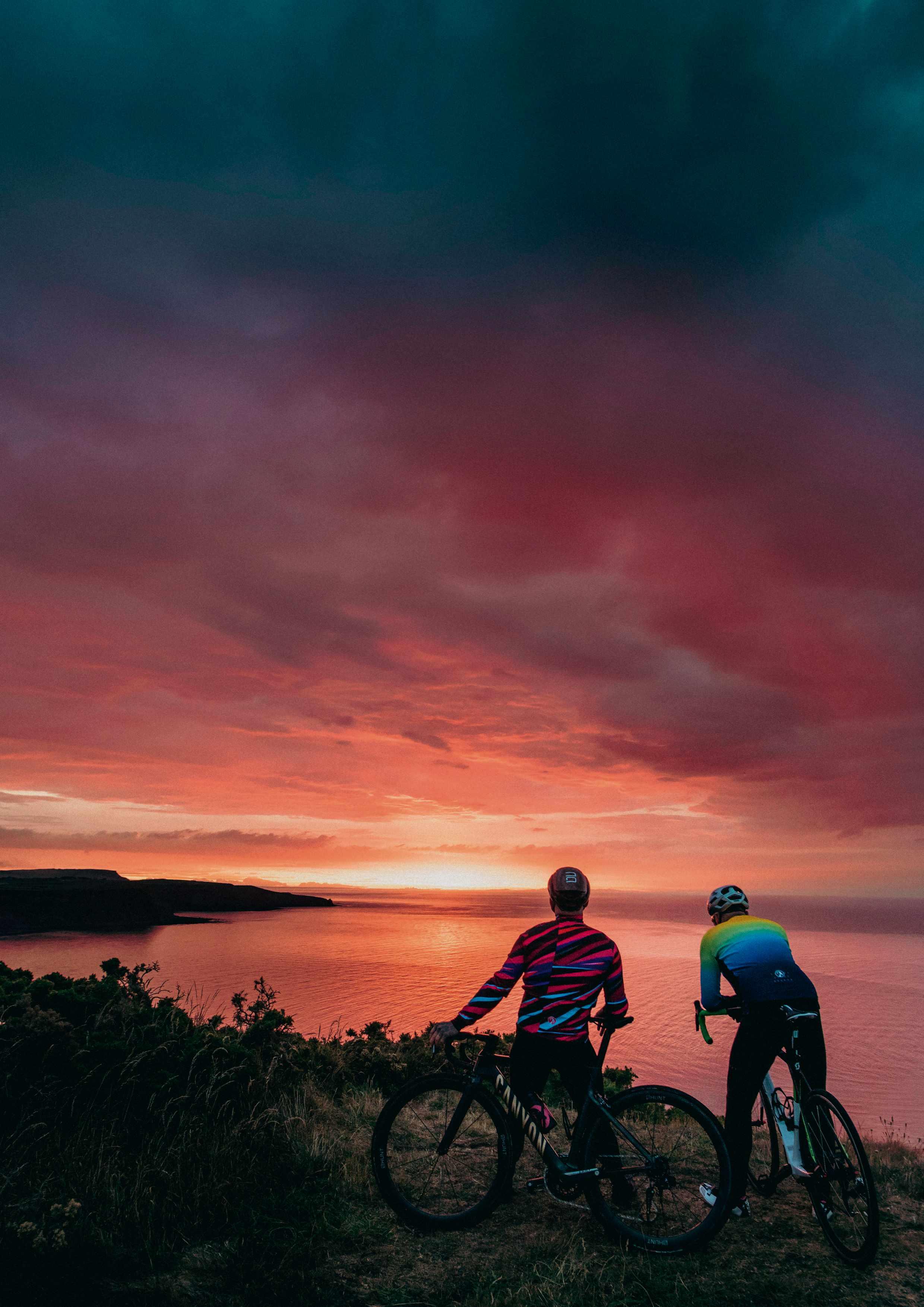
12 July 1964
● Jacques Anquetil and Raymond Poulidor lock horns on the legendary Puy de Dôme. The steep road that climbs the Massif Central volcano was last used in the Tour de France in 1988 and has been resurrected for the 2023 edition. A climbers’ race, it features just 22km of time trialling across the whole three weeks.
Image: Offside/L’Equipe


●
Hannah Grant, the Danish chef who has worked with WorldTour cycling teams, has a new book out. The Cake Cook Book (£23.99) is full of cake recipes for the endurance cyclist. Available from hannahgrant.com
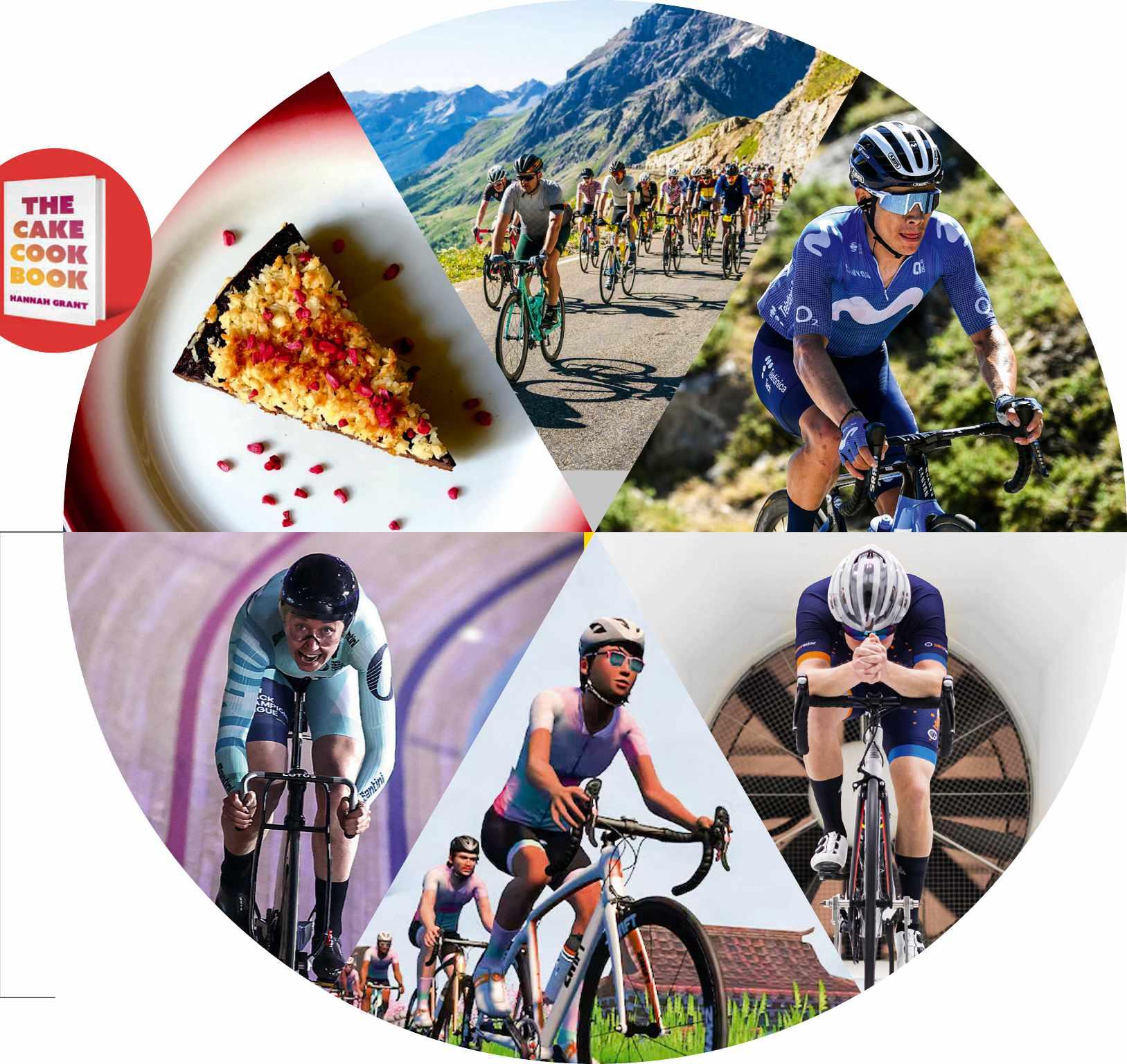
●
The 2023 L’Etape du Tour route is set for 9 July, mirroring the 152km stage 14 of the Tour de France from Annemasse to Morzine. Entries are best sought through firms such as Sportive Breaks and Sports Tours International
●
The ever-entertaining Least Expected Day: Inside the Movistar Team, the Spanish-language Netflix documentary following the WorldTour team, has a third season on the streamer
●
The UCI Track Champions League returns to the London velodrome 2-3 December. The format sees the world’s best racers compete in the same format across five rounds in November and December
Years since a Spanish Grand Départ, the men’s 2023 start will be in Bilbao on 1 July
●
Zwift has launched its latest challenge, the six-stage Tour of Makuri Islands, with the final two stages on the new Urukazi map. Be quick, you only have until 30 November to complete it
●
The wind tunnel that was once at the Boardman Performance Centre in Evesham has arrived at the Manchester Institute of Health and Performance, next to the Manchester velodrome, for athlete and public use
5 90
Mountain ranges in the men’s race: Pyrenees, Massif Central, Jura, Alps and Vosges
22
Length in km of men’s time trial on stage 16, the only TT of the race. It’s a hilly route in the Alps
Length in km of the penultimate stage of the women’s race, ending at the Tourmalet summit
Lacking from the 2022’s women’s race was a time trial. For 2023 it gets one: 22km in Pau



As a professional cyclist, I was fascinated and obsessed with being a better bike rider. I was always trying to go faster, whether through equipment, physically or technically. And I really enjoyed it. But when I stopped racing, I just needed a break. I said: “Right, I’m never carrying another measuring device again”. But adventure or gravel riding has completely revitalised cycling for me. I am enjoying using my bicycle to do something completely different. I’m a sort of ‘anti-competitive’ cyclist now because I just want to ride my gravel bike in beautiful places. And I have fallen back in love with cycling.
A bike can mean different things to different people at different times in their life. At first, it was my bit of childhood independence. Then it was my sport. Then it became my job. Then I used it post-retirement as a way to just stop being fat. But now I use it as a way to explore. I’ve realised that my bike is now just a way to go and take pictures in beautiful places.
Adventure bikes fit my new approach perfectly. When we started making them at Boardman Bikes, I thought they were great. I am a 50mm tyre type of person now. I’m not bothered about my top speed. Mountain bikes are too heavy for getting around town, but they do off-road really well. Road bikes are fast, but only on the road. Tracks and paths and the roads stitching them together are where I want to be now, so a gravel bike just fits that niche beautifully.
This kind of riding really helps me to explore. I live in a nice part of the Wirral, but because it’s a peninsula I’ve done those roads to death. The tracks and paths are where I now go for fun. I ride the Wirral Way – an old Beeching railway line. It cuts through any lumpy bits, so it is quite sedate and quiet. Finding tracks that I didn’t know about in the ’90s because I was too busy trying to go quick is a nice way for me to rediscover my own area. I also really enjoy riding to a cafe or a pub, but only at the end of the ride: I don’t like stopping then starting again when you’re cold.
But I’ve found this kind of adventure cycling most joyous in Scotland. I think I’m going to end up living there. I love riding in the Cairngorms and the Western Isles as well. Traffic is almost non-existent there. You see a car and everybody stops and says hello because it’s another human being. It’s a wonderful place to ride.
I now take a lot of pictures on my rides. Photography is a primary passion of mine. I know it sounds very
Chris Boardman British former racing cyclist and co-founder of Boardman Bikes (boardmanbikes. com)

Boardman is currently the National Active Travel Commissioner for Active Travel England
cheesy, but it encourages you to be where you are and to enjoy it. A certain place might make you feel something, or you might see a cow in the Highlands or the symmetry in the scene, and you go: I want to capture that. And while I’m doing that, I’m not thinking about other stuff. It’s just a way to take a mental break on the bike.
I admit that I still do a bit of looking at the numbers. I’m a very geeky person, so I can very quickly become obsessive about it. And I’m wary of that. But the main point for me is not competitiveness any more. I just ride because it’s fun.

I still enjoy doing some sportives for fun too, so long as I keep my ego in check. As soon as somebody says ‘go’, there is just an automatic instinct to start battering down the road. I have ridden Etape Caledonia in Pitlochry, Perthshire, a few times and that was great. I have done Birmingham and London sportives too. But the beautiful thing about sportives is that there’s always somebody else who is happy to sit on the front instead.
In the future, I’d love to do some big adventures like Land’s End to John o’ Groats, but off-road. It would take about 20 days, so that might have to wait until my retirement, if that ever happens. I’ve also done a nice charity ride from the Masons Arms in the Lake District, which takes in Wrynose Pass and other places like that. A ride which starts and ends at a pub is as good as it gets.
The beautiful thing about cycling is that it can give you whatever you need at any time in your life. The bicycle is just an enabling tool: you can use it however or wherever you want. Riding purely for fun can help you to remember that.
Chris Boardman still finds new ways to enjoy life on two wheelsIllustration Daniel Seex Interview Mark Bailey

Enter the Science Museum in London and you’re overawed by a carousel of historic bicycles adorning the hall ceiling. Among the boneshakers, penny-farthings, folders, MTBs and town bikes, one stands out. Sleek and black, the LotusSport looks like something from outer space.
It’s not, however, from a Star Trek Klingon factory, but from an English bloke in Norwich. It’s the most famous work of visionary bicycle designer Mike Burrows, who died in 2022 aged 79. Imagine ‘Doc’ Brown in Back to the Future as a feisty, maverick British bike nerd in a workshop full of lateral-thinking cycle engineering and a fax machine. That’s Burrows.
The Lotus was a long time in the making. In the 1980s Burrows worked with the new carbon fibre tech to develop onepiece frames with single forks. They were very aero, lithe and fast, a boon for the track rider – and rapidly banned by the UCI. When that was overturned, carmaker Lotus picked up the design as the LotusSport, then the Lotus 108 and 110.

Merseysider Chris Boardman rode it to gold in the 1992 Barcelona Olympics 4km
pursuit. The machine’s futuristic shape (plus Boardman’s coal-scuttle helmet) trumpeted in a new era of performancebike tech and relentless marginal gains that’s still ongoing.
It wasn’t Burrows’ only bike revolution. He designed Giant’s TCR, whose sloping top-tube proved a better, sturdier, more efficient ride than conventional patterns. It set the shape for all modern road bikes.
His work on recumbents enabled Andy Wilkinson to ride Land’s End to John o’Groats in 41h 4m in 1990 on a faired Windcheetah. That’s still the fastest-ever pedalled End-to-End. He also created the Giant Halfway folder, plus the ‘2D’ commuter that could be turned very thin to store in hallways. And his 8Freight –with its wheelbarrow-like back end that can easily shift 100kg loads – is often cited as the urban-delivery cargo bike.
But the Lotus 108 was perhaps Burrows’ masterwork: a performance-bike gamechanger. He struck gold in his design ideas many times, but never more literally than this one. Next time you’re at the Science Museum, think of him. Rob Ainsley

● Founded in 1860 (yes!) by Sutton blacksmith Tom Pearson in the velocipede boom, it’s the world’s oldest bike shop. Now run by fifthgeneration family members Will and Guy Pearson it has a modern focus: high-quality performance bike builds, sustainability, ethics and a big online presence.

What makes this shop special?
● “Customer service is paramount,” says Will. “We survey customers and use data for research and development.
Every bike is 100% custom built to a precise fit, crank length, stem, bar width, everything, Dura-Ace to 105.’
Why is a local bike shop so important
● “Community, and customer care – some have bought six bikes over the years from us.”
● Own-brand performance bikes (End of Road, Venture, Urban) in a 12-strong range of gravel, road and commuter custom-built on any frame (carbon, aluminium, titanium, steel). Own-brand clothing.
pearson1860.com
The Lotus 108 pushed the boundaries of bike designEvery issue, Cycling Plus gives some love to Britain’s best independent bike shopsGroundbreaking masterpiece of the one-off bikedesign pioneer Mike Burrows, who died in August ICONS OF CYCLING


£11,499 This sleek aero road bike is now just about as light as UCI racing regs allow
The winning bike in two of this year’s Tour de France stages, the latest Giant Propel is claimed to be lighter, stiffer, more compliant and more aerodynamically efficient than its predecessor. It also has a shortened reach and wheelbase. Its frame, with an integrated seatpost design, is made from Giant’s Advanced SL carbon layup: its stiffest, lightest and priciest carbon fibre. Here are the details.
At 6.91kg for a complete ML-sized bike (including bottle cages, a power meter and the outfront bike computer mount) and just 1,429.5g for the frame, it’s one of the lightest disc brake aero road bikes out there. That’s around a 255g reduction in frameset weight compared to the previous version, which nudges it impressively close to the UCI’s minimum bike weight limit of 6.8kg.
Giant claims the bike’s frameset stiffness has been improved by 9.9%, while pedalling stiffness is up by 7.2%. This equates to an overall improvement of 9.2% versus the outgoing model, helping transfer power from rider to road.

A slimmed-down rear end, as well as being lighter, is claimed to offer an enormous 85% improvement in compliance compared to the old Propel. This ups the comfort of the ride by helping neutralise road buzz.
Overall, the bike’s said to be 2.6% more aerodynamic than before. This has been achieved thanks to the sleek new Contact SLR Aero cockpit, and using “sculpted lines” and “truncated ellipse” tube shapes to minimise drag. The recently launched Cadex 50 Ultra Disc wheelsystem and Cadex Aero tyres also help here.
The somewhat ungainly over-thetop-of-the-stem cable routing is now gone, along with the bolt-on cover and flexible headset spacers. In its place is the new cable-routing system OverDrive Aero. This sees all cables and hoses routed internally through the handlebar before running under the stem and into the frame in front of the steerer tube, and is designed to make it easier to adjust the fit of components such as the stem.
Advanced SL 0 (pictured)
Weight 6.91kg (ML) Frameset Advanced SL-grade composite Groupset Shimano Dura-Ace Di2 R9200 Wheels Cadex 50 Ultra Disc Tyres Cadex Aero 700x25c Brakes Shimano Dura-Ace Hydraulic with RT-MT900 rotors
Finishing kit Giant Fleet SLR saddle, Advanced SL-grade composite seatpost, Giant Contact SLR Aero handlebar, Shimano FC-9200-P power meter
27 secs
● Time saved over 40km, or 6.21 watts at 40kph, versus old version

Schools are well and truly back – and with them the dreaded school-run traffic. The car is the usual means of travel to school for a third of kids, and makes up about 27% of rush hour traffic in London. According to the AA, only 20% of schools encourage cycling, often because of safety fears.
Growing up in rural Somerset, I dreamt of riding my bike to school, but three miles of narrow, winding country road, much of it national speed limit, stood in the way. There was nothing wrong with the school bus, but I was missing out on the many benefits of riding my bike.
While many kids, rural and urban, face similar barriers, there are solutions without major interventions such as fully protected cycleways. Though obviously proper bike lanes would be the safest option, rolling them out takes time and the kind of largesse the current Government is more likely to splash on climate-busting roads.

One primary school chair of governors in Oxford and Reading, Zaki Moosa, writing in a recent blog, called the school run ‘the biggest safeguarding risk of all’, because of the danger parents unintentionally pose to other children by driving theirs to school. According to the AA, 56% of parents reported traffic chaos near schools at pick-up and drop-off times. As kids returned after the holidays my social media timeline was littered with videos of jammed roads and inconsiderate driving.
‘School Streets’ are a powerful and relatively simple measure that councils can implement to protect children cycling and walking to school. These restricted road closures in the morning and afternoon around the school can improve safety and boost walking, wheeling and cycling. According to research commissioned by Mums for Lungs, these School Streets are ‘likely to be feasible’ for around half of schools (44-50%). While cities outside of London have implemented School Streets at less than 5% of schools, the research estimated if London, Leeds, Birmingham and Bristol alone fully rolled out the measure it could save 32 million car trips per year, or 71 million km of driving. Separate research found the measures cut nitrogen dioxide by up to 23%, were supported by 81% of parents and encouraged 18% of parents to drive less.
Active Travel England is rating councils on their cycling and walking delivery performances to date, and will prioritise funding to those with the capacity and drive to deliver decent infrastructure. For councils with less of a track record they’re likely to fund measures such as School Street programmes.
Laura Laker Transport journalist

Each issue, with her ear to the world of UK cycling infrastructure, Laura reports on the setbacks our community faces – and how we’re fighting back
There’s an even simpler intervention – cycle training. It is by no means a replacement for safer roads but it’s certainly a good start. Last month, while researching a book I’m writing, I visited a secondary school where half of the children cycle each day. I witnessed pelotons of kids riding home together, despite there being no visible measures to restrict motor traffic.
Most of them will have received Bikeability training, teaching them bike handling skills and how to ride in traffic. It gave these kids the confidence and ability to negotiate at times pretty hostile road conditions.
The kids were clearly having a brilliant time cycling home, despite some pretty dodgy overtaking manoeuvres by drivers. One parent told me the school actively encourages kids to cycle to school from the off, and because it’s the easiest thing, due to the local road layout, that’s what they do.
The Bikeability Trust, the charity tasked with delivering cycle training for adults and children, describes cycling as a life skill like swimming and highlights in some recent research the need for professional training – most parents understandably don’t feel confident teaching children to ride in traffic. The Trust wants all kids to be able to learn cycling skills and confidence – and hopes to achieve this from next year. The latest £20m ‘record’ Government funding is only enough to train 500,000 kids – not even a single year group.
Cycle training helped me understand the roads and gave me the confidence to ride wherever I wanted – opening up a world of opportunity once I got big enough to tackle that winding country road and many like it. It’s surely time that all kids were given that chance, in any way we can make it happen.
Bookman draws on the heritage of Swedish safetyconscious brands but also finds inspiration in the traditions of minimalistic, functional Scandanavian design and innovative technology.
Our range of rechargeable LED bike lights come in high-powered designs engineered for long and reliable run times. Designed to be easy to attach and remove, without leaving any fastening devices on your bike, and with a water-resistant build, they’ll guide you safely through rain, hail or snow. All lights have multiple modes so you can choose between ultimate run-time or highest power.

Cycling amongst the trees in the Black Forest is beautifully atmospheric, with some climbs to get those thighs burning


In Germany’s brooding Black Forest, it’s the shimmering slivers of light that speak loudest. Though the sun struggles to penetrate the thickets of common spruce and pine trees (which make up 50% of the forest), when it does, the effects on the road are magical, helping to dry the patches of tarmac still damp from the morning mist.
Schwarzwald, as the forest translates to in German, stretches over 6,000km2 in a long slither in the southwest corner of Germany. To its north is one of its most-visited towns, Baden-Baden, famed through much of Europe for its sumptuous thermal spas, such as the 140-yearold Friedrichsbad and its dazzling

Renaissance architecture. To English football fans, the town has gone down in infamy for their football team’s stay here during the 2006 World Cup campaign, which was a damp squib on the pitch and a media frenzy off it, as the team’s wives and girlfriends – the WAGs, as the papers would have it – became tabloid fodder throughout the tournament.
That bizarre interlude was an outlier in the history of Baden-Baden – a town happier to maintain a slower tempo, one of upmarket shopping, lush parks and architectural touchstones. The cycling isn’t half bad, either!
Mountain biking is perhaps more popular here – it’s not hard to see why, with the rolling hills and wideopen space in between tarmac – but road cyclists have much with which to work.
Though this is a popular tourist resort, ride out of season on week days and you’ll be rewarded with quiet roads on – largely – good tarmac (the winters are harsh here). In British terms, there are mountainous roads to get your teeth into here, with climbs up to 10km long that take you over 1,000m altitude. Cycling Plus visited in the first week of October; the weather was wonderful, sunny and in the low 20s, but a week earlier it had
been half that and the end of cycling season was in sight. September, after the school holidays, is perhaps the ideal time, where you’ll be free of the extreme heat of summer.
Autobahns are where German motorists are allowed to cut loose without speed limits. Culturally, however, they are sticklers for rules, which means elsewhere the masses stick to limits. The result is that it feels safer to ride here than it can do in Britain, but if you do wish to ride with more peace, there’s often an alternative bike path to switch to. Spanning the Black Forest from north to south is the Panorama cycle path, a largely traffic-free series of paths that stretches 287km with almost 3,500m of climbing.
Baden-Baden can be reached by train from London, with changes in Paris and Karlsruhe, in around 5hrs of train time.
Cycling Plus stayed in the Leonardo Royal Hotel, on the southern edge of Baden-Baden – an ideal location to explore the forest to the east.
germany.travel / schwarzwaldtourismus.info
Left Head to the area out of the main holiday season to avoid the crowds and the peak of the summer heat

● A ramp test of four increasingly tough Black Forest climbs on roads that exemplify the region. Gems include the super-steep climb out of Gernsbach, the Panorama bike path section from Höfen to Sprollenhaus and the back-road finish via Schloss Eberstein.
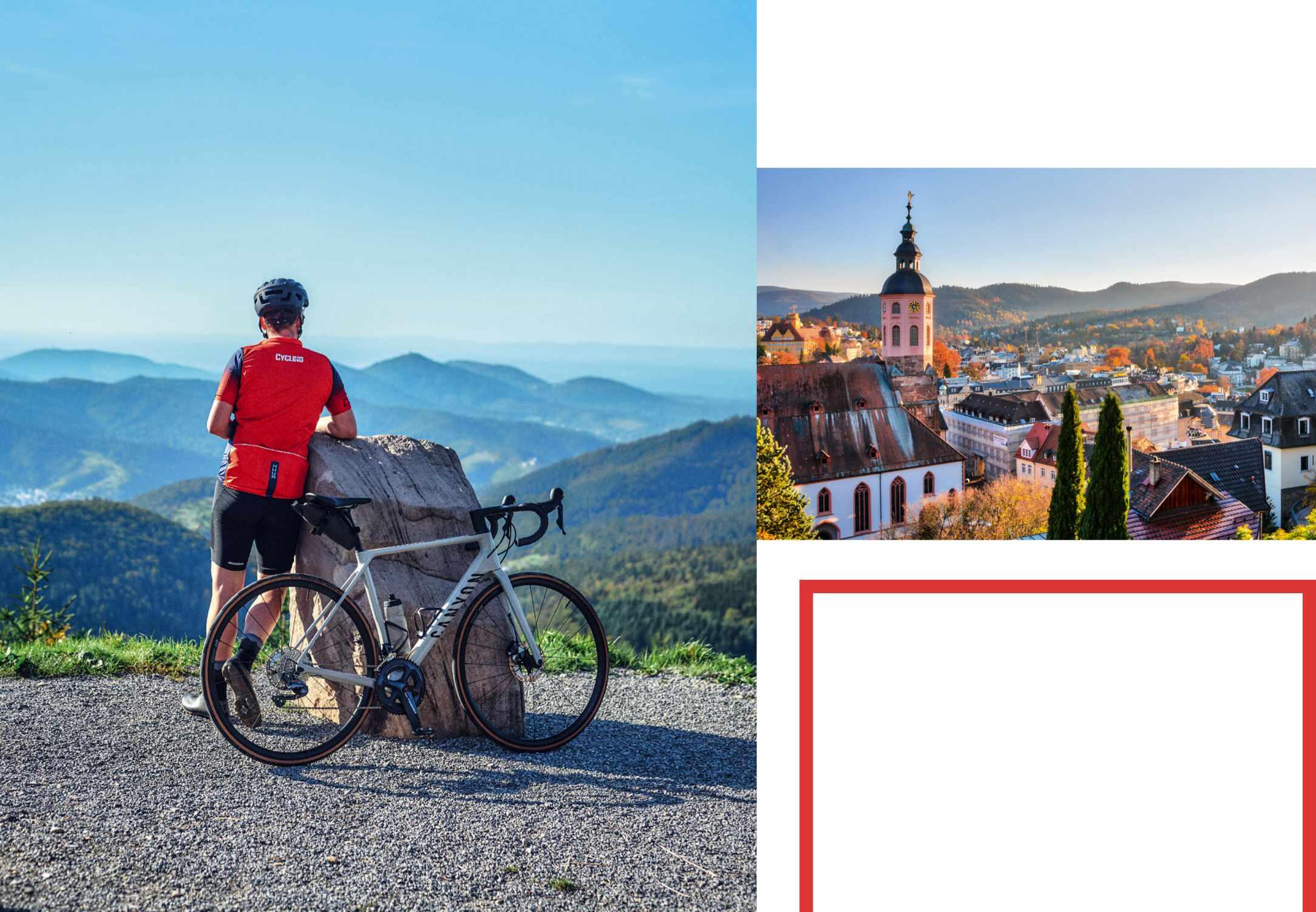
01 Bike shop
● Zweirad Rehm (Kuppenheimer Strasse 3) is a Trek dealer with workshop for urgent repairs.
02 Lunch stop
● Another spa town, Bad Wildbad, roughly
Below As well as offering thermal springs and plenty of culture, Baden-Baden has some great cycling nearby
marks the halfway point of the ride and is an ideal spot for lunch. Be sure to bring cash here –and elsewhere in the Black Forest. The rush to a cashless society hasn’t been as fast in Germany.
03 Photo op
● Coming off the high summit of Schwarzmiss (the big climb of the day) sees a break in the trees revealing a stunning panorama (see photo top left) of the forest below. It’s on your left – and it’s easy to miss if you have your eyes on the road.
Distance 100km Elevation 1,890m Download komoot.com/tour/952017826





Shimano’s venerable 105 groupset has been the powerhouse of performance road cycling for well over a decade, offering Dura-Ace and Ultegra trickledown tech for less. Here’s the latest on the ‘people’s groupset’
SHIMANO’S 105 GROUPSET HAS A well-earned reputation for value for money and is arguably the most popular performance groupset available today. However, while the 105 R7170 Di2 – the brand’s first electronic, 12-speed groupset at the 105 level – had an update in 2022, controversially it didn’t update the 105 mechanical groupset.
Shimano 105 R7000 benefits from Shimano’s trickle-down approach to development in the area, with technology that debuts on Dura-Ace making its way to Ultegra, and then onwards to this third-tier offering.
Sure, you have to wait a while to get the latest shifting and braking tech from the more expensive groupsets, but when it arrives, history shows that 105 includes practically all of the good stuff and leaves out the stuff you don’t really need –predominately at the cost of weight.
With the launch of Shimano 105 R7170 Di2, the Japanese brand catered for the
growing demand to see electronic shifting at the 105 level… but that has seemingly come at the cost of its mechanical 105 groupset, which has remained unchanged. Perhaps 2023 might yield an updated mechanical-shifting 105 groupset, maybe with 12 speeds to match its new Di2 stablemate. But for now, mechanical 105 is only available with 11 speeds (just like mechanical Ultegra, which itself has yet to see an update), but we feel this is ample.
We don’t think so. Shimano’s mechanical 105 is a well-proven, reliable, good-value groupset. With plenty of demand driving brands to build bikes with the groupset, we doubt that this is the last time we’ll be talking about it.
Currently, the smart money is on mechanical 105 eventually getting a 12-speed upgrade, with the current 11-speed 105 groupset being rebadged as Tiagra (bringing 11-speed to the fourth tier for the first time), or Shimano could simply continue to sell mechanical 105 as a bridging gap between an upgraded
Tiagra and 105 Di2. Either way, we think mechanical 105 is likely to live on.
04 Should I buy a mechanical Shimano 105 bike now?
Yes. If a bike meets your needs and budget, and that budget allows for mechanical 105, then the groupset will not disappoint you, as testified by our four test bikes here.
As was the case with Dura-Ace and Ultegra, we would reasonably expect any cassette update to remain compatible with 11-speed freehubs, even if mechanical 105 does shift to 12 speeds. In short, mechanical 105 remains an excellent groupset, and has plenty of mileage left in it yet, so you shouldn’t be disappointed if you choose it!
Quinlan Senior Technical EditorBikeRadar
● Ashley loves a performance bargain and, for him, there hasn’t been a better value-for-money groupset for road enthusiasts than mechanical 105. He fervently hopes to see it updated to match its new, more expensive Di2 sibling soon.
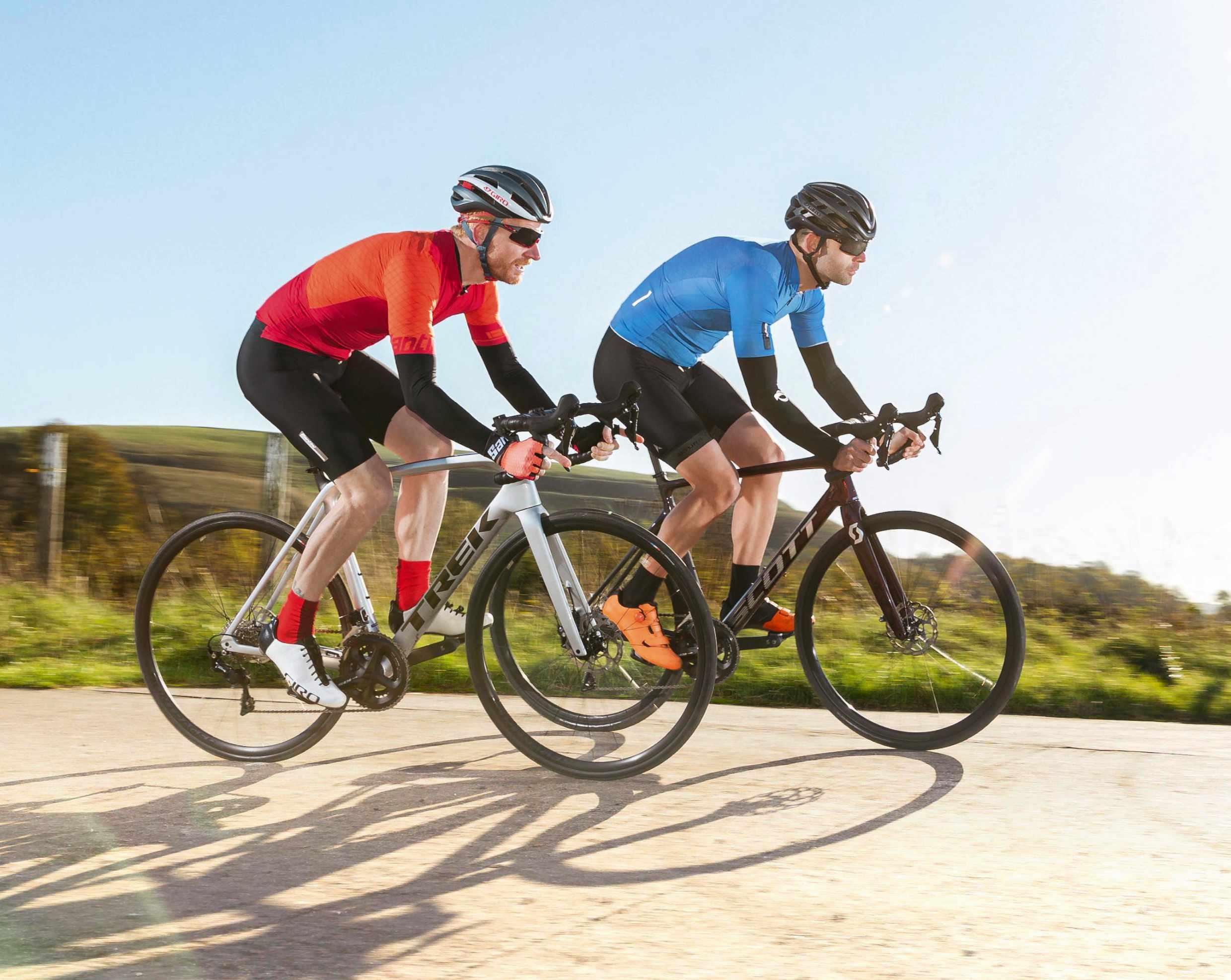
● A road bike designed to be ridden for longer distances. It’s created with rider comfort in mind (versus out-and-out speed), and will often be designed with more relaxed geometry to cater for riders who aren’t as well-trained and flexible as the pros. This test includes three endurance bikes and one race bike, though there’s some overlap.


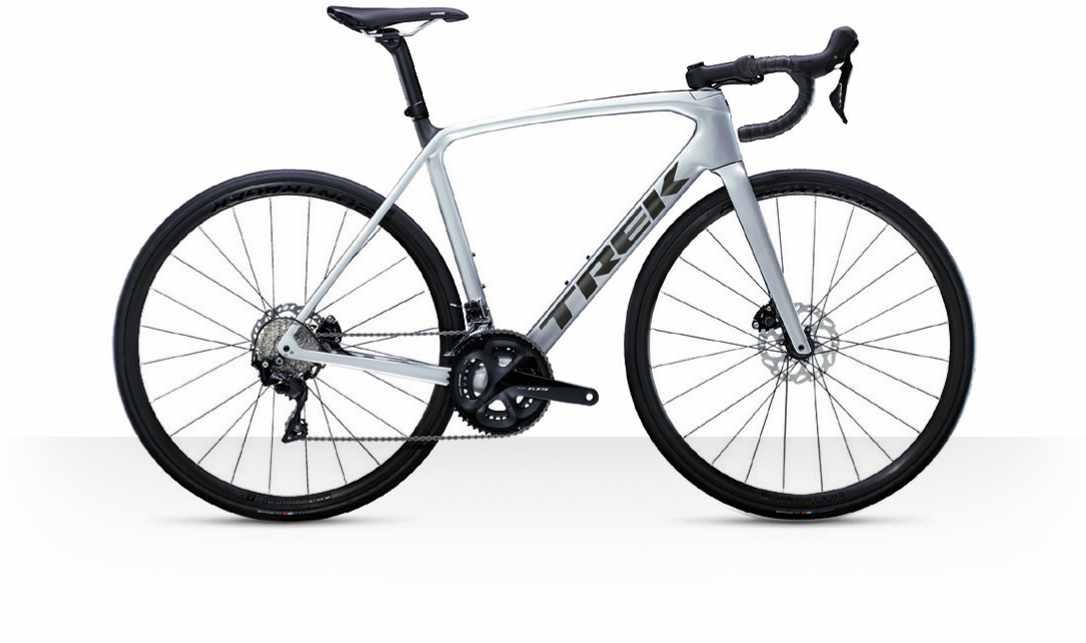
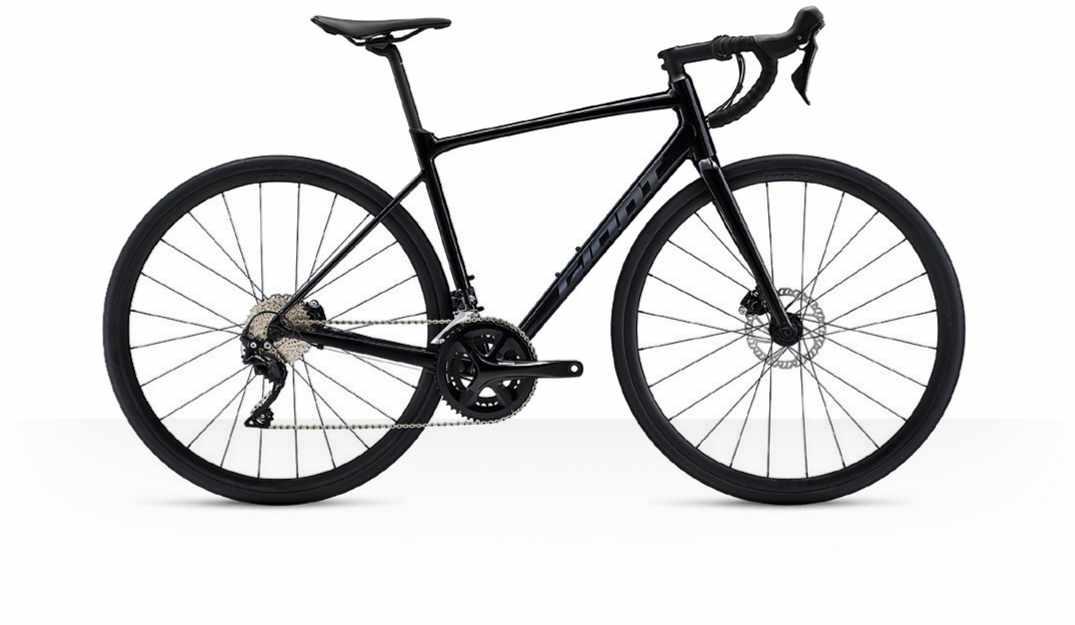
● Geometry refers to the lengths and angles of a bike frame’s tubes, which largely dictates how a bike will feel to ride, as well as the range of ride positions you can adopt.
● Cable routing is an important part of bicycle frame design, especially for mechanical groupsets. Internal cable routing – which all of our test bikes feature to some degree – sees cables (and hydraulic brake hoses) enter and exit the frame for neater looks and marginal aero gains. Good cable routing will reduce kinks and resistance points, helping your gears to shift smoothly.
● Sometimes, bike manufacturers will spec components that are not standard to the chosen groupset. While these are compatible, they’re often heavier, slightly less efficient or wear a little faster than the standard components.
Chainsets, chains and cassettes are common things to be swapped out, and it’s normally done to save money, or could be down to availability of components.
● Not all Shimano groupset components carry the same name. In Shimano’s parlance, 105 R7000 is the ‘standard’ rim brake mechanical variety, while R7020 is the disc brake mechanical version we see on all our test bikes. For reference, any groupset with Di2 electronic shifting has 50 or 70 in its designation.
● The Di2 stands for ‘digital integrated intelligence’, Shimano’s version of electronic shifting, and makes changing gears faster than when using mechanical systems.



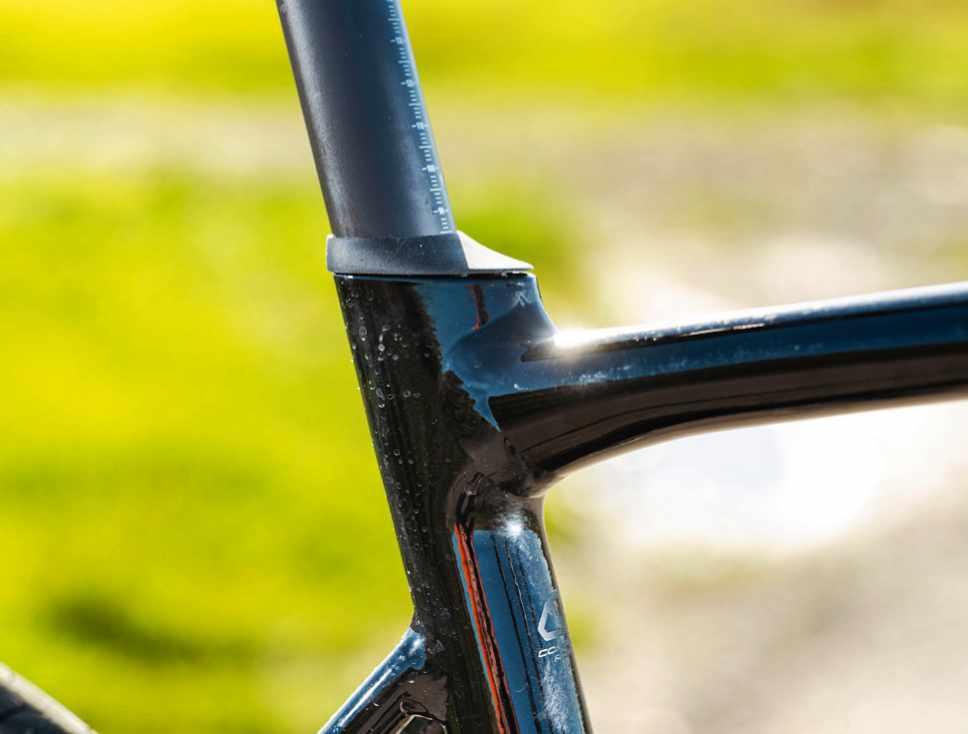

9.83kg (size
THE GIANT CONTEND IS DESIGNED
as an “all-rounder”, sitting between a race and an endurance bike. The Taiwanese brand’s ability to produce a high-quality frame means its bikes are great value. The SL Disc 1’s frame uses Giant’s Aluxx SL aluminium technology, has bosses for two bottle cages and features internal cable routing, albeit with the gear cable routed externally along the chainstay. The rear seatstays aren’t dropped much – often seatstays join significantly lower to offer claimed benefits of improved comfort and aero performance – but Giant’s excellent D-Fuse seatpost mitigates vibration.
The fork is made of Giant’s ‘Advanced’ level carbon fibre, with the aim of soaking up road buzz better than an aluminium option. All-round, there’s clearance for up to 34mm-wide tyres, although you’re limited to the 32mm recommended maximum capacity of the supplied wheels.
The Contend SL Disc 1’s geometry suits long, endurance-type riding and relaxed handling. A relatively slack head-tube (72.5° in all but the smallest of the five sizes) sets the tone, with a 50mm fork rake that effectively pushes the front wheel forward for steady, predictable handling. However, the wheelbase is 1,002mm on our ML size bike (broadly equivalent to a 56cm), which isn’t overly long for an endurance bike and should keep the frame feeling responsive. The reach measures a compact 384mm, helped by the 110mm stem and tall 577mm stack, for added comfort on long rides.
The Good Value; highquality frame; bomb-proof build
The Bad Non-105-spec chainset and brake rotors; sluggish wheels and tyres
The Allux SL frame manages to smooth out road buzz and bumps impressively, in tandem with the D-Fuse carbon seatpost and carbon fork. It also rolls very well too, given its rather
functional and robust wheels and tyres. Once I got up to speed, I could happily maintain a 25-30km/h steady tempo, and carry speed on flat terrain. The 42cm wide Giant Connect handlebar gives a stable feeling, and the drops are easy to lower into.
The Shimano 105 R7020 groupset provides crisp and sharp shifting, with the rest of the drivetrain still as impressive as it’s ever been. The compact chainset and 11-34t cassette offers a decent range for a typical beginner or endurance rider, albeit with some large gaps between some of the ratios. There are some non-standard components, though: the Shimano RS510 chainset, a KMC chain and Giant’s own MPH brake rotors. At this price point, it’s a forgivable – even justified – concession to swap rotors out. While the braking power is good enough,
they measure closer to 30mm wide when inflated. That enables you to run lower pressures for added comfort. The clincher tyres provide ample grip and feature a cut tread for improved road-holding performance in challenging conditions. Unfortunately, though, they don’t offer much feel when cornering at speed – they don’t inspire confidence to really push on through turns or down descents. As a result, the combination of the sturdy wheels and tyres saps the ultimate potential of the bike and they’d be the first things I’d upgrade.
In all, the Giant Contend SL Disc 1 offers a great-value way to get your hands on a bike with a (largely) 105-spec drivetrain, plus a highly competent frameset. The wheels and tyres hold the bike back, while the component swaps are a small (if understandable) concession. However, you have the potential to upgrade as you go with this very good, easy-to-ride road bike.
you don’t get quite the same feel and modulation you typically get in a standard 105-spec set-up. The RS510 chainset offers similar shifting performance, but it’s around 145g heavier and doesn’t feel quite as smooth when you push down hard to sprint or at lower cadences.
The wheels are Giant’s own-brand S-R2 hoops, which have tubeless-compatible rims with a 17mm internal width. Although not the widest around, they help smooth the way. But, despite an adequately fastengaging hub mechanism, they feel relatively heavy and sluggish to accelerate. This is compounded by the tyres, Giant’s S-R3s. Their official size is 700x28c, but
Also consider...
● A little less…. Giant Contend SL Disc 2 £1,449

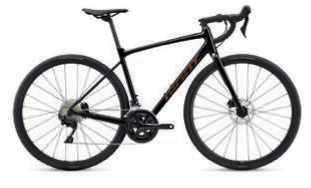
Sporting the same build as the SL Disc 1, the SL Disc 2 swaps out the 11-speed 105 groupset for 10-speed Tiagra, which is a rung lower in spec than the 105, making it cheaper.
● A little more…. Giant Contend AR 1 £1,899
The AR 1 comes with 32mm-wide tyres (it can take up to 38mm), suitable for light gravel, making it arguably a more comprehensive all-rounder.
Weight ML) Frame Contend Aluxx SL aluminium Fork Contend Advanced carbon Gears Shimano 105Verdict A great-value way to get a 105-equipped bike with a highly competent frameset
“The Aluxx SL frame manages to smooth out road buzz and bumps impressively, in tandem with the seatpost and fork”

Weight 9.39kg (L/56cm) Frame Canyon Endurace AL Disc aluminium Fork Canyon FK0089 CF Disc Gears Shimano 105 R7000 (52/36, 11-34) Wheels Fulcrum Racing 900 DB, tubeless-ready Brakes Shimano 105 R7020 hydraulic disc Finishing kit Canyon H17 Ergobar aluminium bar, V13 aluminium stem, SP0057 VCLS carbon seatpost, Selle Italia Model X saddle, Schwalbe One tyres
platform has been a value standardsetter for the past few years and the latest AL 7 model is still one of the best aluminium road bikes you can buy. The frameset is made using Canyon’s double-butting technique, for low weight and high stiffness (1,375g in a size M). It’s a good-looking frame with neat, smooth weld junctions and partial internal routing plus top-tube bosses for a bento box. Interestingly, the seatstays aren’t dropped one iota, and a 27.2mm diameter seat-tube means you can’t fit an aero post. The carbon fibre fork’s pronounced shoulders give good clearance for up to 35mm-wide tyres, which is bang on trend for endurance road bikes.
The Endurace AL frame’s geometry blurs the lines between endurance and race bike. In a size Large it blends a relatively steep 73° head-tube angle with a very tall 611mm total stack and 387mm reach. This should combine sharp front-end handling with more rider comfort. Spacers on top of the 186mm head-tube allow you to lower the front end, though. The shortish 1,006mm wheelbase means the Endurace can be whipped around easily.
The overall handling is very sharp, with fast steering responses. When you’re out of the saddle, the bike accelerates with gusto, and it holds its speed remarkably well, giving an exciting ride. Just be aware the bike’s very playful, almost-darty, reactions require real concentration to make the most of them.
The Good Sprightly handling; excellent spec; price
The Bad Handling may feel too sharp for some; very wide bar
The aluminium frame feels almost as stiff as a carbon bike, while the front end also feels incredibly stiff but not punishingly rigid. The bike climbs well, thanks to this stiffness, but you may feel a little far away from the action when you’re out of the
saddle, due to the high stack. When it comes to rough roads, the aluminium frame (with carbon fork) feels composed, but the wide Schwalbe One clincher tyres (700x30c at the front, and a chunky 700x32c at the rear) make up for any loss of compliance an alloy frame might bring by allowing you to reduce your tyre pressures for improved comfort and grip.
The finishing kit comes from Canyon. There’s a traditional two-piece alloy bar and stem, with external cable routing. The shape of the H17 bar’s drop is accessible, while the squared-edge style of the V13 stem is reassuringly muscular. For me, though, the handlebar width is excessive at 44cm on this size Large bike. The intention is to provide more control and stability when descending and cornering, but it feels odd here when
for most riders, the 52x11t largest gear might be more than most people need.
The tubeless-ready Fulcrum Racing 900 DB wheels feature an alloy rim with a 19mm internal width. They’re built to last and weigh a not-insignificant 1,950g for the set, but in tandem with the Schwalbe One clincher tyres, the ride feels engaging. The tyres offer impressive grip, road feel and roll pleasantly. Although they’re not tubeless, it’s nice to see a premium-performing tyre specced here. On an endurance bike, I’d argue that fitting 32c tyres front and back would boost comfort.
The Canyon Endurace AL 7 is a force to be reckoned with when it comes to valuefor-money spec, and it brings an overall ride quality that even some carbon road bikes can’t match. It sits on the racier side of the endurance bike spectrum, making it one of the most entertaining road bikes available this side of £2,000.
the rest of the bike feels so racy. The 20mm setback carbon seatpost helps the wide tyres smooth road buzz, and I’m a big fan of the Selle Royal Model X saddle.
I’m very impressed by the build of the AL 7: the Shimano 105 R7020 groupset is complete, with no cost-saving concessions. Shifting and braking performance is superb, and that indicates that the routing is well integrated. Canyon has opted for Shimano’s wide-ranging 11-34t 11-speed cassette, which brings excellent range, if a few largerthan-ideal gaps between the ratios. The chainset comes in semi-compact format, with 52/36 teeth chainrings. While the 36x34t smallest gear will be perfectly fine
● A little less...
Canyon Endurace AL 6 £1,449

The Endurace AL 6 features a lowerspec 10-speed Shimano Tiagra groupset instead of 105, but matches the same excellent finishing kit as the AL 7.
● A little more...
Canyon Endurace CF 7 £1,999
The Endurace CF 7 offers a lightweight carbon frameset to accompany the great-value, all-round build, upping the performance factor as well as the price of this model.
Also consider...
Verdict Still one of the best-value road bikes – a lively bike you won’t need to upgrade out of the box
“Out of the saddle, the bike accelerates with gusto, and it holds its speed remarkably well, giving an exciting ride”









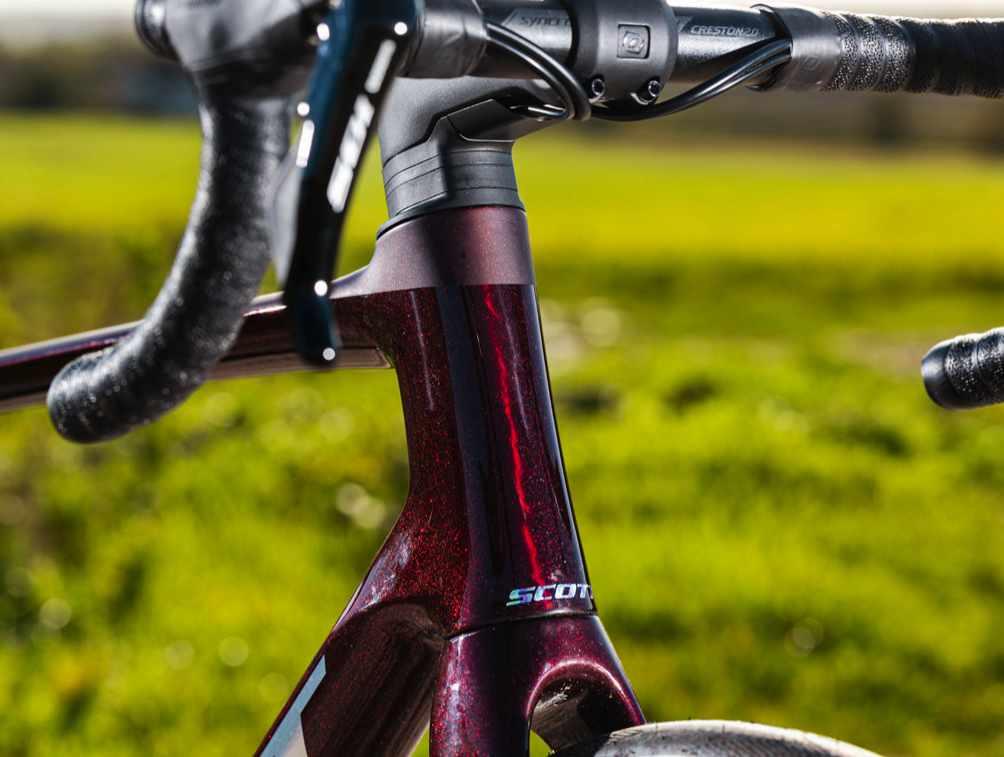
THE SCOTT ADDICT 30 IS THE SWISS brand’s endurance road bike, but it carries a racer’s edge while incorporating a well-considered geometry, a high-quality build and a smart finishing kit that softens the edges without compromising speed.
The bike features a full carbon frameset, using Scott’s more compliant HMF carbon layup. There’s clear aero profiling to the tubing: the broad down-tube has flattened rear sides and flares significantly towards the bottom bracket, for improved pedalling rigidity and power transfer. The rear triangle sees dropped seatstays for aero and comfort benefit. The fork is made of the same HMF carbon with a tapered steerer, plus the fork crown is notably tall, to add airflow when wider tyres are fitted. The frameset has full internal cable and brake hose routing plus mounts for a Syncros mudguard/fender kit.
While the Addict 30 is solidly an endurance bike, it has some refreshingly aggressive nods. Notably, the reach is a race-bike long 394.3mm, and the long 1,015.4mm wheelbase balances things by upping stability over longer distances and poor surfaces. A tall 593.3mm stack and squat 103mm stem ensure the bar isn’t too far away or too low, but the 73° head-tube angle is certainly race-bike steep.
means you have to put the effort in for a few pedal strokes before the speed builds in a satisfyingly smooth way; it also gives you incredibly calm handling, while the steep head angle keeps things interesting. When you tip it into challenging downhill bends at speed, the steering is sharp and accurate enough to encourage you to challenge your bravery, and its composure often leaves you wondering if you could have been even more aggressive when you exit the corner.
All this is fortified by the 32c Schwalbe One tyres. Their voluminous capacity also helps to soften what would otherwise be a rigid ride. Scott says the Addict is good for 35mm clearance, which could potentially even allow you to try some light gravel riding.
it’s an endurance bike first and foremost and offers a welcome small 34x32t ratio for when the gradient gets really steep.

The Syncros wheelset performs solidly and dependably. It features alloy rims with a fairly narrow 19mm internal rim width, laced to alloy hubs using 28 spokes. While the 32c Schwalbe One tyres cushion the ride well and are a safe bet, they can’t be run tubeless. The wheels are tubeless-ready, though, so you could swap out the tyres.
Overall, the Scott Addict 30 is an impressive endurance road bike. It delivers an exciting ride out of the box, but I suspect the frameset has more to give if you can upgrade the wheels and tyres. It’s rigid and racy for an endurance bike, but the 32c tyres soften the ride. It’s a bike well suited to keen club riding and sportive conquering, while it’s got enough flexibility to act as your sporty summer bike as well as a winter mile-muncher.
Verdict For many riders, the Scott Addict 30 could prove to be all the road bike you may ever need

Also consider...
I’d expected the Addict to feel overly long, but it doesn’t. Instead, the sheer stiffness of the frameset dominates, providing a taut, sharp and – importantly – agile experience. On the flat, it serenely glides forward. It shrugs off disruptive crosswinds yet feels efficient when moving at 30-35km/h –impressively so for a bike lacking a mid- or deepsection wheelset. On climbs, it feels suitably rigid and efficient and it’s the same when sprinting. However, the long wheelbase
Finishing kit comes courtesy of Syncros, Scott’s in-house components brand. The handlebar is 42cm wide, while the stem is visibly chunky and 103mm long. The bar is comfortably shaped with very accessible drops, while the stem is impressively rigid and able to handle hard efforts. The carbon seatpost is a standard 27.2mm diameter. I found it was acceptably good at meting out road buzz, in tandem with the wide tyres.
● A little less… Scott Addict 40 £1,899
The Good Easy handling; great finishing kit; good value
The Bad Slow to get up to speed; wheels and tyres
The Shimano 105 R7020 groupset is full series-spec, except the KMC X11 chain, which performed just as well as a Shimano chain. The bike comes with a compact (50/34 tooth) chainset, and an 11-32t cassette that gave smooth transitions between gears at speed. I missed a semicompact 52/36t chainset for top speeds, but
The 40 boasts the same excellent frameset, however it employs a different groupset. The Addict 40 offers 10-speed Shimano Tiagra, which means fewer gears in this step down from 105.
● A little more...
Scott Addict 20 £2,699
The Addict gets a little speedier as it steps up to the lighter Shimano Ultegra build. It also benefits from an improved, aero carbon fibre seatpost for added performance.
Weight 8.32kg (L/56cm) Frameset Scott Addict Disc HMF Carbon Gears Shimano 105 R7000 11-speed (11-32, 50/34) Wheels Syncros RP2.0 Disc, tubeless-ready Brakes Shimano 105 R7020 hydraulic disc Finishing kit Syncros Creston 2.0 Compact aluminium bar, Syncros RR2.0 aluminium stem, Syncros Tofino Regular 2.0 Channel saddle, Syncros RR1.2 carbon, Schwalbe One clincher 32c tyres“The sheer stiffness of the frameset dominates, providing a taut, sharp and –importantly – agile experience”
£2,700
Weight 8.89kg (L/56cm) Frame Trek Emonda Ultralight 500 Series OCLV Carbon Fork Émonda SL full carbon Gears Shimano 105 R7000 11-speed (50/34, 11-30) Wheels Bontrager Paradigm SL Brakes Shimano 105 hydraulic disc
Finishing kit Bontrager Comp VR-C aluminium bar, Elite aluminium stem, P3 Verse Comp saddle, seat mast cap aluminium seatpost, Bontrager R1 Hard-Case Lite tyres
TREK’S EMONDA IS THE AMERICAN brand’s lightweight race bike that’s perfect for climbing. Like the latest Madone SLR, it uses Trek’s H1.5 geometry (H1 is its most aggressive), but features less aero efficiency in its stiff, competent carbon frameset. It uses Trek’s 500 Series OCLV carbon, Trek’s second-tier carbon, and all in, an Emonda SL frame tips the scales at a claimed 1,142g, while the fork weighs 380g.
The frame has had an aero overhaul, however. There’s a deep and aero-optimised head-tube, along with broad tube profiling at the down-tube and in the swooping toptube. The squared-off backsides to the tubes indicate a bias towards easy handling and aero efficiency at lower speeds and, sure enough, the bike feels efficient on the flat and stable in crosswinds.
The frame features fully internal cable routing, and the brakeside chainstay incorporates a mounting point for Trek’s DuoTrap module (not included), which transmits wheel speed and cadence data. The Emonda’s geometry is race-orientated, but what strikes home immediately is its relatively short reach for what is ostensibly a race bike. In a size 56cm, the frame’s reach measures 391mm, which is more like an endurance bike. A short, 100mm-length stem magnifies the stubby feel. Then there’s quite a low-slung 563mm stack height, a steep 73.5° head-tube angle, and a compact 983mm wheelbase. All this means the Emonda handles sharply, with direct steering and efficient power delivery.
The Good Stiff, efficient frame; race geometry; fun on the right terrain
The Bad Build doesn’t do justice to the frame; gearing choices limit future options
The stiff carbon layup combined with the compact geometry produces a frame that’s impressively rigid. The downside to such a stiff frameset, in this case, is a lack of overall
compliance. The ride borders on harsh here, although the seatmast design (a mast topper overlaps an extended seat-tube) offers some ride-smoothing properties. The bike feels light though – lighter than its 8.89kg total weight – and when descending, turns are initiated with resolute ease.
The alloy Bontrager Paradigm SL wheels and R1 clincher tyres don’t offer bags of feel and are a weak point; the cheaper Addict 30 and Endurace AL 7 in this test both outstrip this spec. However, I never lacked confidence in the handling of the Emonda.
The finishing kit is from Trek’s in-house brand, Bontrager. The cockpit is a twopiece affair, with a Bontrager Comp VR-C bar married to a Bontrager Elite stem. Both are alloy, and offer a comfortable range of positions for your hands to rest, although
find the 50x11t combination a little limiting on descents. The tubeless-ready Bontrager Paradigm SL wheels feature a shallow alloy rim with a 21mm internal width. Unless you want something that’ll support broader tyre widths, they’ll do the job as a competent three-season wheelset.
The 28c Bontrager R1 tyres provide middling grip and the tyres inflate to their claimed width, but there’s ample space in the frame for 30c rubber, 32c at a squeeze, and wider tyres would add some comfort to the ride.
The Emonda SL’s frameset is incredibly capable but it’s dressed in a solid-butunspectacular build. It will suit keen sportive riders and even road racers, but you may need to upgrade some fundamental components to get the most out of it. Be aware that in 2023 this model will be named simply the Trek Emonda SL 5, and have a price hike of £550.
I’d spec a 10mm longer stem to push out the reach a little. I found the feel a little noodle-like and the bar didn’t feel quite broad enough in my large hands. The alloy seatmast cap, with 10mm of setback, fits on an extended carbon seat-tube. On top sits a Bontrager P3 Verse Comp saddle. I enjoyed the shorter nose design, and many will appreciate the plentiful padding and pressure-relieving cutout, but the rubberised material ‘grabbed’ my bib shorts.
A full Shimano 105 R7020 groupset adorns the Emonda SL 5 Disc, and Trek has specced a racy, narrow-ranging 11-30t cassette. The compact (50/34 tooth) chainset will help get you up those hills, but stronger riders may
* *
● A little more… Trek Emonda SL 6 Disc £3,400
If you hurry, the 2022 Emonda SL 6 (price as shown above) is still available with a Shimano Ultegra mechanical groupset for not much more than next year’s SL 5 with 105.
● A lot more… Trek Emonda SL 6 Di2 £4,150

The new 2023 model SL 6 Di2 (price as shown above) features the brand new 105 Di2 electronic groupset with upgrades to the wheels and tyres for a lighter, speedier result.

“The bike feels light though – lighter than its 8.89kg total weight – and when descending, turns are initiated with ease”
Internal cabling gives a sleek look to the bike

Aero profiling is evident at the front end of the bike
The seatmast design helps to smooth the ride



It has quite a short reach for a race bike

More than anything, our test demonstrates the continuing impressiveness of Shimano’s 105 R7020 mechanical groupset, whether the Japanese manufacturer chooses to update it in the future or not. In these days of high inflation and soaring cost of living, top-whack value for money becomes paramount, and this groupset is most definitely still a viable option for those who can’t justify spending many thousands of
pounds on a bike. As you’ll have read, the models here will suit different riding styles and uses but all are excellent options in their own way.
The alloy Giant Contend blends a relaxed geometry and ride and, as the least expensive bike on test, offers a good-value entry point to the world of 105. It lacks some key 105-series components, though, in its quest to keep the price down, and the wheels and tyres would be key areas to look at upgrading.
Sticking with alloy, the Canyon Endurace impresses with its entertaining, sharp ride and very strong spec. Special mention must also go to the price – at a comparatively modest £1,699, it’s probably one of the bestvalue road bikes available today.
Switching to carbon, the Trek Emonda brings with it a prodigiously stiff frame and
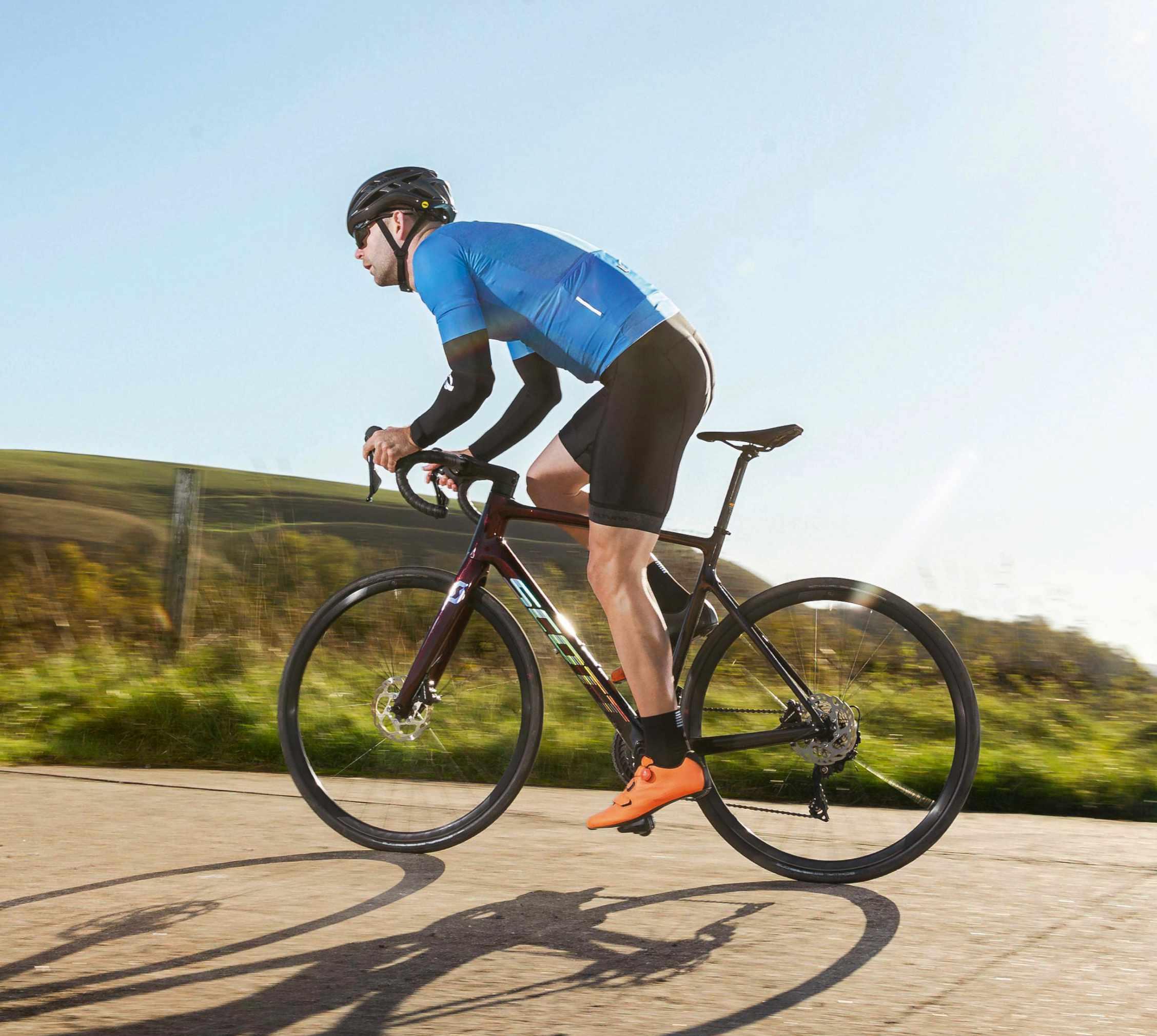
an aggressive geometry. It’s a brilliant foil for climbing, but at £2,700 (and soon to be affected by a significant price increase), it is expensive and needs better wheels and tyres to realise its full potential.
But this month’s 105 winner, despite the Endurace’s outstanding value, is the Scott Addict. The Addict rides like a consummate endurance bike: it’s fast and fun, yet it’s also compliant enough – with a well-considered geometry – to be easy to ride for longer distances. Suitable for everything from sportives to year-round club rides and so much more, it also packs in a smart build, earning it the nod as winner.
The winner is… Scott Addict 30 The Addict proves the most consummate of all-rounders
“The Addict rides like a consummate endurance bike: it’s fast and fun, yet it is also compliant enough for distance”
Thanks to our sponsors...
The big day is sprinting into view and even ultra-fit pro cyclists are getting ready to eat cake and party with friends. The festive season is a chance to take your foot off the gas and reset your body and mind. It’s okay to eat more chocolate and train a little less – you deserve it! But with a few subtle upgrades, you can swerve the side effects of a month of parties, laziness and indulgence – and still enjoy Christmas to the max. Here is our tinsel-covered survival guide.
You should look forward to some big nights out with friends, family and those boozemonsters in the advertising department. “Cyclists should live their lives and enjoy this fun period which only comes once a year, so don’t feel guilty,” insists nutrition and performance coach Will Girling (willgirling.com). “But if you’re keen to hit the New Year in shape, there are some ways to help yourself through the party season.”

Don’t be tempted to do a brutal, guiltbusting training ride before a Christmas party. “Alcohol hinders muscle protein synthesis and increases muscle breakdown, so it’s not worth it,” says Girling. “Go for a light ride instead: it’ll increase your calorie
burn ready for when you indulge later, but without the big recovery requirements.” Wearing an un-aerodynamic Santa cape should slow you down nicely.
“Make your breakfast and lunch protein and vegetable focused to lower your calorie intake ready for more food and drink at the Christmas party,” says Girling. Just don’t go too light, or you’ll be floored by your first drink.
“Beer drinkers should choose 330ml bottled beers, rather than pints (568ml),” says Girling. A 330ml bottle of Peroni has 138 calories, while a pint packs 235 calories. “Other low-calorie options include small glasses of wine, or spirits like vodka or gin with slimline tonic or soda water.”
Adapt your cycling recovery skills into booze recovery skills. “Because alcohol is diuretic (it increases urine production), it’s important to rehydrate before bed,” says Girling. “Vitamin C and paracetamol before bed can also help.” Make sure you hide any Christmas snacks before you come home with the midnight munchies. “When you drink, ghrelin (the ‘hunger hormone’) increases, so your appetite will increase.”
Embrace all the fun and freedom of Christmas while swerving the season’s health-busting pitfalls with our festive blueprint for enjoying your most cycling-friendly Yule yetWords Mark Bailey Illustration
From Mariah Carey to Dean Martin, catchy Christmas songs are filling the airwaves right now – and you’re loving it. So use these uplifting festive earworms to power a fun Christmas turbo session. Research by Brunel University suggests cyclists instinctively adjust their cadence and effort to the tempo, or beats per minute (bpm), of a song. So first build the Christmas playlist below on your chosen streaming service. Then hammer out a 30-minute workout, harnessing the playlist’s ever-increasing song tempos to deliver a progressively more challenging workout. The end of each tune will naturally give you a quick rest between efforts. Don’t worry about specific power or cadence – just go with the flow and adjust your effort to the song tempos for a fun, festive workout. Loud singing and stripy elf hat optional.
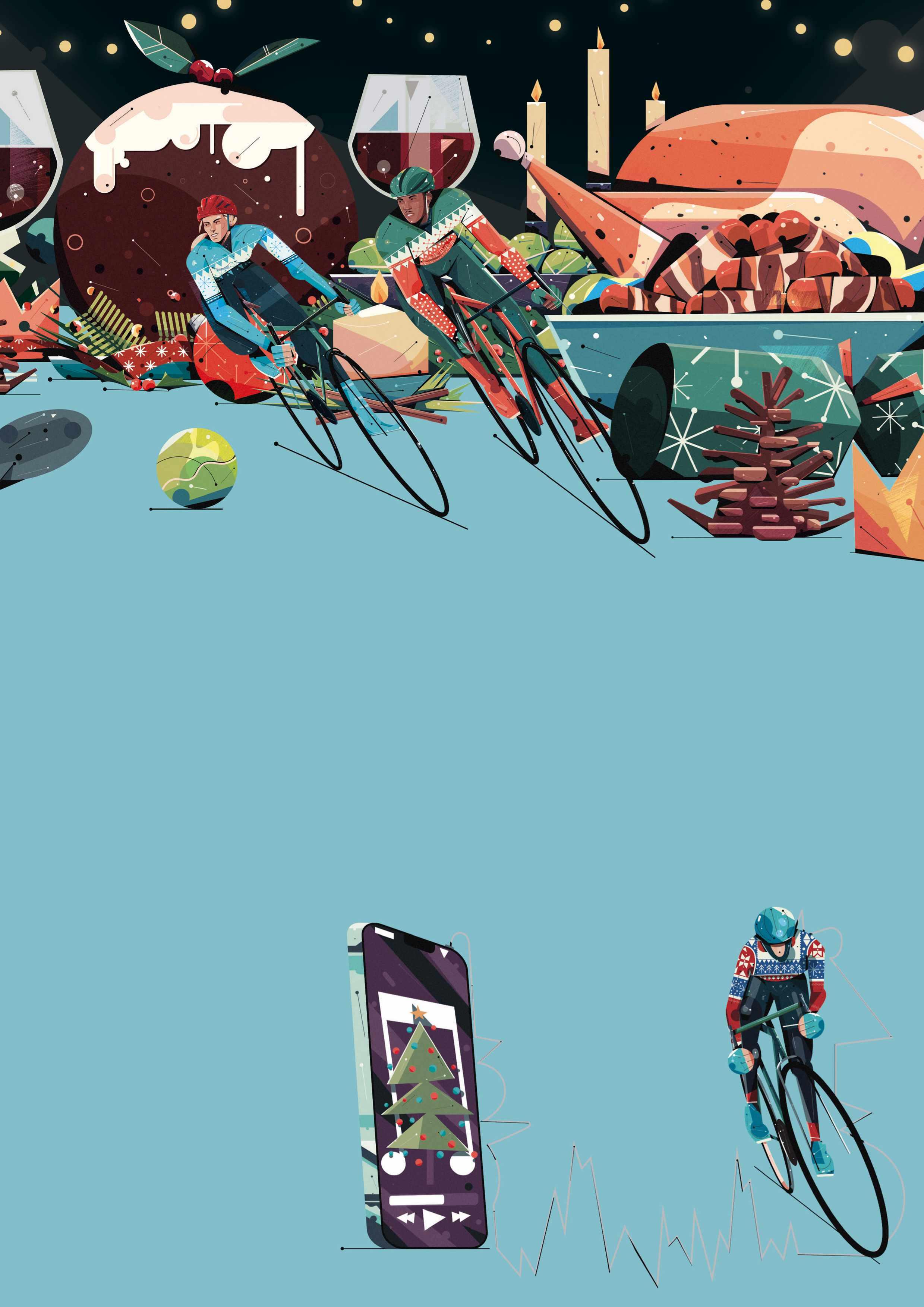
It’s a freezing cold December day and you can see clouds of your own breath when you step outside to drop (another) empty box of Cadbury’s Roses into the recycling bin. But that crisp blue winter sky is beckoning you out for a ride. Follow this winter warm-up to conquer the cold and enjoy an exhilarating Christmas spin.
1. Wait for the ice to melt
Most cyclists like morning rides, but over winter it’s often better to wait. “Every year

I treat people who have crashed due to ice, so on icy days try leaving it a few hours,” says Nichola Roberts of Velo Physio (velophysio.co.uk). By lunchtime the ice should have melted. Switching to wider 32c winter tyres with extra grip will also help.
2. Do your warm-up at home
Always do a proactive indoor warm-up to ensure your muscles are toasty before you leave your log fire behind. “Do a series of single-leg hip thrusts,” suggests Roberts.
“Standing on one leg, reach your opposite leg out behind you in a backward lunge position, then drive through your front leg, bringing the back leg up to hip height.” Repeat with each leg until you’re warmed up. “This will activate your glutes and get your blood pumping. Add a hop at the end to warm your calves too.”
3. Layer up
For a chilly Christmas ride, wear lots of layers, including a base layer and an outer shell. “Wear a hat or cap as we lose a lot of heat from the head,” adds Roberts. Sipping from an insulated bottle of warm water can boost your core temperature mid-ride.
4. Increase your cadence
Opt for a fast, easy gear. “A higher cadence of 90-100rpm will challenge your cardio system and pump blood to your extremities,” says Roberts. “Avoid sprints or out-of-the-saddle efforts until your body warms through. Then settle into your normal cadence.”
So you spent the morning giggling at Home Alone’s Kevin McCallister fending off thieves with swinging paint cans, then you smashed through an Elf and Love Actually double bill. The average UK household will watch 62 hours of TV over the Christmas period. But a few simple stretches between (or during) movie sittings will restore some mobility to prevent a stiff back or neck during the next day’s bike ride. “Lazing in front of a TV puts you in a position of sustained flexion – think of a curled-up prawn!” explains physio Nichola Roberts. “So stretch your body into extension –think of a basketball player jumping for a slam dunk – with these stretches.”

Rest on your knees, while holding an exercise roller (or dumbbell) in both hands on the floor, then gently push the roller out in front of you. “Focus on flattening the chest area, and the area between your shoulder blades, as you move,” says Roberts. Slide back up and repeat 3-4 reps.
Lie on your stomach with your arms by your sides. Pull your tummy in and draw your shoulder blades back. Lift your arms, keeping your chin tucked in and eyes down, then lift your head and chest slightly off the floor. “If your back feels okay, squeeze your glutes and lift your feet just off the floor too,” adds Roberts. Hold, lower and repeat 3-4 reps.
With your feet hip-width apart, bend at the hips as if sitting on an invisible chair. As you squat, reach upwards with your arms, while looking towards your fingertips. “Hold the position for 5 secs, feeling the work in your glutes and quads,” says Roberts. Now drive through your glutes to stand up. Aim for 8 reps in total.
Quality Street, After Eight, Ferrero Rocher… everybody has their own treasured Christmas chocolate. But the nation’s favourite stocking filler has long been Terry’s Chocolate Orange. Now sports dietitian Dr Gemma Sampson (gemmasampson. com) has helpfully created an allnatural chocolate-orange energy ball recipe which gives you that delicious fruit-chocolate Christmas flavour during winter rides – and each ball has 89% less calories than the original. “If you’re a fan of chocolate orange, you’ll love these choc-orange energy balls,” she says.
Method Blitz the
in a
processor or blender. If the mix isn’t binding, slowly add a tsp of orange juice. Roll into balls, then store in the fridge for your next ride.
1.2g fibre
If you’ve behaved well this year, cleaned your bike regularly and done lots of recovery stretches, it’s not too late to ask Father Christmas for a few premium cycling treats. If the big man lets you down, just treat yourself in the Boxing Day sales instead. Christmas is the right time to buy yourself that one expensive item of kit you’ll enjoy for years to come.
SunGod Velans £155
With Iris photochromic lenses, which adjust to fast-changing UK light conditions, these high-quality impact-resistant glasses are a great one-stop solution for all seasons.
LeCol Pro Jacket II £260
Part of Le Col’s new autumn/winter collection, this high-spec jacket combines a sleek aero fit with Polartec fabric for good waterproof and windproof protection in speedy scenarios all year round.
Christmas Day is here and you’re looking forward to spending the day eating pigs in blankets and guzzling wine. But try kickstarting the day like a pro by going for a beautiful Christmas morning ride. “I ride my bike on Christmas Day,” says 2018 Tour de France winner Geraint Thomas. “I always get out and smash myself for two hours. It’s a great time as the roads are really clear. But when I get home I feel so much more like I’ve earned my Christmas dinner.”
In the gloriously lazy days after Christmas, don’t forget that the leftover turkey in your fridge offers the perfect post-ride recovery fuel. “Post-ride you need protein to stimulate muscle protein synthesis –typically 0.3g of protein per kg of bodyweight – and turkey is a great source of protein,” explains nutritionist Will Girling. “It has all the essential amino acids, and is high in leucine (a branchedchain amino acid that helps to repair your muscles).”
Turkey sandwich “With protein from the turkey and carbs from the bread, this is a great simple recovery meal,” says Girling. “And cranberry sauce will add some fast-digesting carbs to top up your glycogen stores.”
Madison Stellar Waterproof
Thermal gloves £39.99
Whether smashing winter miles or braving Alpine summer descents, a pair of quality full-fingered gloves – like these thermal options from Madison – is a brilliant Christmastime investment.
Turkey salad “Take your leftover turkey meat, and mix it with some cashew nuts, dried cranberries, and chicory, rocket and spinach leaves, then add pomegranate seeds, along with some olive oil, honey, sesame seed oil or the juice from a wedge of a Christmas clementine as a dressing.”

“I always get out and smash myself for two hours on Christmas Day. The roads are really clear”
Geraint Thomas
You’re now off work for Christmas and you’re keen to catch up with friends. But instead of pigging out in the pub, head out for a social Christmas spin instead. Sticking to a gentle pace, so you can chat as you ride, is actually a powerful training stimulus. Riding at conversation-holding pace boosts the efficiency of your muscle fibres and develops more mitochondria: the energy-producing powerhouses in your cells. “A good rule of thumb to be in the right zone for long winter miles is the ability to hold a conversation,” says Simon Beldon, who works at Matt Bottrill Performance Coaching (mattbottrill performancecoaching.com). “If you are only able to say a few words, you are going too hard.” So long as you can argue with your friend over whether Die Hard is technically a Christmas movie or not (it is), you’re in the right zone.
So you’re spending the last days of 2022 tucking into leftover Christmas cake and raiding your kids’ tub of Haribo. We won’t tell them. But you can torch off those extra calories before the New Year with this festive fat-burning turbo ride by Wattbike master trainer Chris Stanton (wattbike. com). “This is a fantastic turbo session designed to get you up and on it after a day of indulgence,” says Stanton. “It’ll keep you on your toes, fully engaged, so you feel like you’ve done some meaningful work.” Goodbye calories, hello 2023…

Warm-up 15mins building to 90% FTP* (RPE**7 – can speak in short sentences)
1min at 40% FTP (RPE 2 – light and easy riding)
Sprint - 15secs at 150% FTP (RPE 10 –all-out sprint effort)
1min at 40% FTP (RPE 2)
Sprint - 15secs at 150% FTP (RPE 10)
2:30mins at 40% FTP (RPE 2)
Main Workout
30secs at 125% FTP (RPE 9 – can’t utter even a few words)
15secs at 85% FTP (RPE 6 - breathing getting laboured)
9 x 30sec efforts at 115% FTP (RPE 8 – hard to say more than 2-3 words)
9 x 15secs at 85% FTP (RPE 6) in between each effort
30secs at 125% FTP (RPE 9)
2mins at 40% FTP (RPE 4 –comfortable pace, can speak a few sentences)
Repeat 3 sets of these blocks
Cool-down 5mins at 40% FTP (RPE 2)

Our 400th issue demanded a route fit for a king. John Whitney and Matt Baird strap in for the long haul on a road version of the King Alfred’s Way
Carrera Virtuoso
The £405, 11.6kg alloy commuter disc-brake bike

Triban RC 120
The £399.99, 10.9kg bike with alloy frame and carbon fork
Long-time readers might remember that way back in May 2015, in our landmark 300th issue, we had a feature in which gear tester Simon Withers and a motley crew from the office rode from Weston-super-Mare to Land’s End: 300km on 300 quid bikes, all in the name of symmetry and magazine cover lines. As a Cycling Plus staff writer, I admired my colleagues for riding bikes that probably cost less than the expenses budget of the trip.

Fast-forward seven years. With breathing laboured and sweat pouring profusely off my
face onto sticky handlebars, there I was hauling myself up the steep slopes towards the Westbury White Horse, some 250km into, you’ve guessed it, a 400km ride on, yes, a 400 quid bike. With me was architect of the ride, editor Matt, who had mapped the route and sourced our bikes from Decathlon and Halfords, the same provider as two of the bikes in 2015. Current rampant inflation and supply chain problems in the bike industry might suggest that we were on the exact same bikes, or at least same standard of bikes, as
Above Although the bikes are fairly weighty, their gear ranges mean you should make it up the hills seated
Above right Matt and John missed their usual higherspec bikes when the road surface was less than perfect

seven years ago, only now costing £400 rather than £300. However, that wasn’t quite the case. Matt’s Triban RC 120 (£349.99 at time of writing, discounted from £399.99) and my Carrera Virtuoso (£405) are bettervalue packages compared with their 2015 brethren, now with added nods to modernity, such as 28mm tyres on both and mechanical discs on the Carrera.
In a change from the 300’s coast-to-coast route, we remained inland, with a threeday circular loop from our Bristol home, venturing southeast through Chippenham, over the North Wessex Downs to Winchester, then back to Bristol via Salisbury, Frome, Glastonbury and Bridgwater. It would, in Matt’s vision, be a road version of Cycling UK’s all-terrain King Alfred’s Way, taking in added historical settlements tied to the king of these parts, who ruled between 871 and 899 and repelled the lively Vikings from conquering Wessex (much of southern England at the time).
Lively wouldn’t be the word I’d use to describe my Carrera Virtuoso, given its 11.6kg weight. Add to that the frame bags to carry my gear, at least until the end of day one in Winchester, where we’d meet photographer Joe, and load all our less vital kit into his car. In fairness to the Virtuoso, though, 400km multi-day rides, loaded up like a carthorse, is perhaps not what its creators had in mind. Matt was travelling much lighter than me, making do with a top-tube triangle bag on his Triban RC 120.
Day one would be the toughest day to be hauling our loaded bikes, too, having the most kilometres and climbing metres. The ride opened on very familiar terrain, the Bristol and Bath Railway Path, a stretch of tarmac over which I’ve, at times in the past, monotonously accumulated 400km in a single week. Once through Pucklechurch, recollections of once-visited roads became ever fuzzier, as fully-formed memories faded into fleeting snapshots, all the way to Calne in Wiltshire, where I reached the outer limits of my West Country cycling solar system and became totally reliant on my own personal mission control, my Garmin 820.
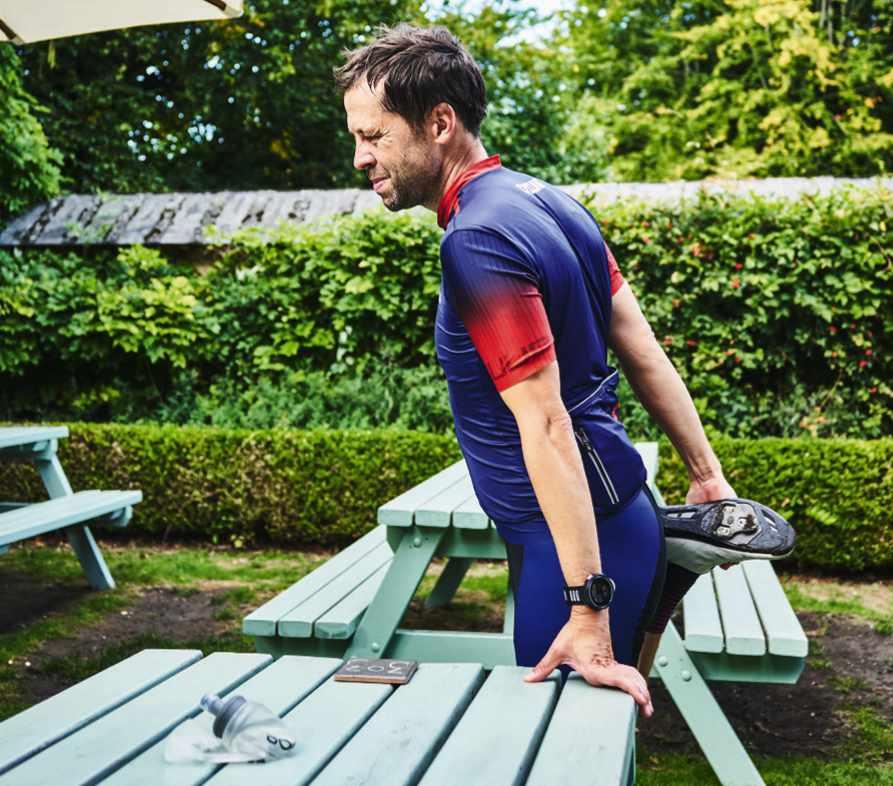
Making use of GPS on rides is the single biggest functional difference between our route features in 2022 compared with those in issue 1 back in February 1992. Four

“With breathing laboured and sweat pouring profusely off my face onto sticky handlebars, I was hauling myself up the steep slopes towards the Westbury White Horse”
hundred issues ago our routes were spartan affairs. Mapped by the very much analogue Philip’s Ultimate Road Atlas, rather than by digital routing tools and large-screen GPS computers, our single-page route guides were filled with black-and-white thumbnail images, a map, profile, basic route stats and brief step-by-step directions that somehow found space for suggested gear ratios on particular stretches of road (including the long-time-no-see 42x16). It was all solid, practical information, replaced in today’s features by six to eight pages of the sort of blather you’ve read up to this point, plus that all-important link to a route that you can download to your bike computer.
Routes are all so much easier now to put together and follow, which perhaps makes it more likely you’ll be wrong-footed by technology, as it sends you down a rough path for which your bike may not be cut out. There were a few sections, such as the NCN 403 between Calne and Avebury, where my trust in the Carrera’s Kenda tyres (and Matt’s Hutchinsons on his Triban) was pushed to the limit on the gravelly surface, even if we emerged from the whole ride with a solitary flat (my Carrera, on a stony road on the outskirts of Calne). It’s on rougher roads and gravel where bikes like this feel their price. The Carrera, for instance, in a straight line on smooth roads, rattles along with gusto, but through potholes or along rough tracks, thanks to the alloy fork, cheap rims and unsupple tyres, the bike jars.

A big highlight of day one included the climb out of Pewsey to another of Wiltshire’s White Horses. Of these eight hillside landmarks still visible, Pewsey’s is one of the most modern (1937), while the most historic is the alreadymentioned Westbury horse (1778). Uffington White Horse, in Oxfordshire, is believed to date back to over 3,000 years, and is thought to be the inspiration for others around the country. An original white horse in Westbury is believed have been made to commemorate Alfred the Great’s victory over the Vikings in the Battle of Edington, a village just east
Weight: 10.9kg (Medium, claimed)
Frame: 6061 aluminium
Fork: Carbon
Gears: Microshift 8-speed, 50/34T, 11-34t
Wheels: Triban 700
Finishing kit: Hutchinson 28mm tyres, Triban ErgoFit saddle, Triban seatpost, front and rear light, bell
of Westbury, in 878, though the one that exists today has more modern origins. By Winchester, our home for the evening and the place where Alfred was buried, it was less white horse and more white flag, as the rigours of a tough day in the saddle came home to roost in a Premier Inn.
Via a detour to King Alfred’s statue in central Winchester, built in 1899 to mark an entire millennium since his death, we set about eating our way through the middle helping of the 400. The 107km to Frome in Somerset was the shortest of the three days, something that we weren’t going to argue with given our ailing bodies were as stiff as the bronze in which Alfred has been immortalised. A testing climb up to the west of Winchester onto Crab Wood, a nature reserve, got the blood pumping immediately and it was pleasing to get a feel for the bikes
The Good Huge gear range, impressive rim brakes, carbon fork!
The Bad Tyres would be the first thing to upgrade. Then the rims

“Consider that for £400 in 1992’s money, I’d have barely got change when buying Time’s £170 clipless pedal and shoe combo that we tested in issue 1”
Left John quietly curses Matt’s route planning as he tries to avoid the worst of the potholes

Below Bikes and riders back in Bristol in one piece, John and Matt tuck into an ice cream
without them being encumbered by luggage. On cheap bikes such as these, gear ranges are often more appropriate for Tour de France riders of a bygone era than their likely riders: people new to the road. That’s not the case with either the Triban or the Carrera, with 34x34 and 34x28 the lowest gear respectively. The Triban, especially, should give you a sporting chance of riding up anything in the saddle.
After riding through chocolate box villages and pleasing lanes, we took lunch at the Pembroke Arms in Wilton, on the western outskirts of Salisbury, before the long stretch of false flat on the NCN 24 northwest to
Warminster and Westbury, and back into more familiar terrain.
By Westbury, the gears on my Carrera were shifting with the predictability of recent politics in Westminster, and in dire need of a tune-up. For £400, though, you certainly get a competent bike, one that had carried me for almost 250km so far with few issues.
Consider that for £400 in 1992’s money, I’d have barely got change when buying Time’s £170 clipless pedal and shoe combo that we tested in issue 1, so I was pleased to be heading towards our day two bolthole in Frome with the bike in good working order.
If the opening two days were packed with climbs, today we’d be keeping things on the level, the Somerset Levels to be precise, with visits to Glastonbury and Bridgwater, before heading north to Bristol. This was our sanctuary today, as was it Alfred’s in 878, when he fled to Athelney after a big old Viking ruckus in Chippenham, before dishing out payback in the Battle of Edington not long after.
Our personal battle continued north, into a solid headwind. Matt wasn’t having to use the rim brakes on his Triban much, but was happy with how they’d performed across the three days. The Tektro Mira mechanical disc brakes on my Carrera were hard to fault at this price and one of the highlights of the overall spec.
All that remained was to negotiate the brilliant Strawberry Line from Axbridge, an off-road largely gravelly path that delivered us to Yatton 12km later, then head back into Bristol, with an Ashton Court finish and an ice cream over Clifton Suspension Bridge.

So there it is… 400 km, on £400 bikes, for our 400th issue. Just don’t ask me about 500 for a while…

Day 1 komoot.com/tour/958565233 Day 2 komoot.com/tour/958573946 Day 3 komoot.com/tour/958581107
Britain’s biggest handmade bike show, Bespoked, returns for an 11th edition, this time in London’s Olympic velodrome. We reveal our favourite designs…










Ben Plowman makes low numbers of rider-specific handcrafted frames. He uses simple lines and geometric designs, drawing on techniques he’s acquired from 20 years making pieces for interior designers and artists. Bicycle design and fabrication is his passion and cycling a way of life. A long time in the planning but made in just 10 days in his Herne Hill workshop, this half and half frameset (£3,000) is for long days and tours. The classy frame’s made from carbon and steel Columbus Spirit tubing.

To be launched this autumn, this Spectre frameset (£4,990 exc VAT) sits at the top end of Festka’s range. From the Czech Republic, the Spectre makes a nod towards comfort with decent tyre clearance, but in its heart, it’s a machine built to go fast. Individuality is part of the DNA at Bespoked, but Festka goes above and beyond in its customisation and concierge service, where you’ll be guided through every part of the build. Riding’s fun, but so is the bike-building process here.
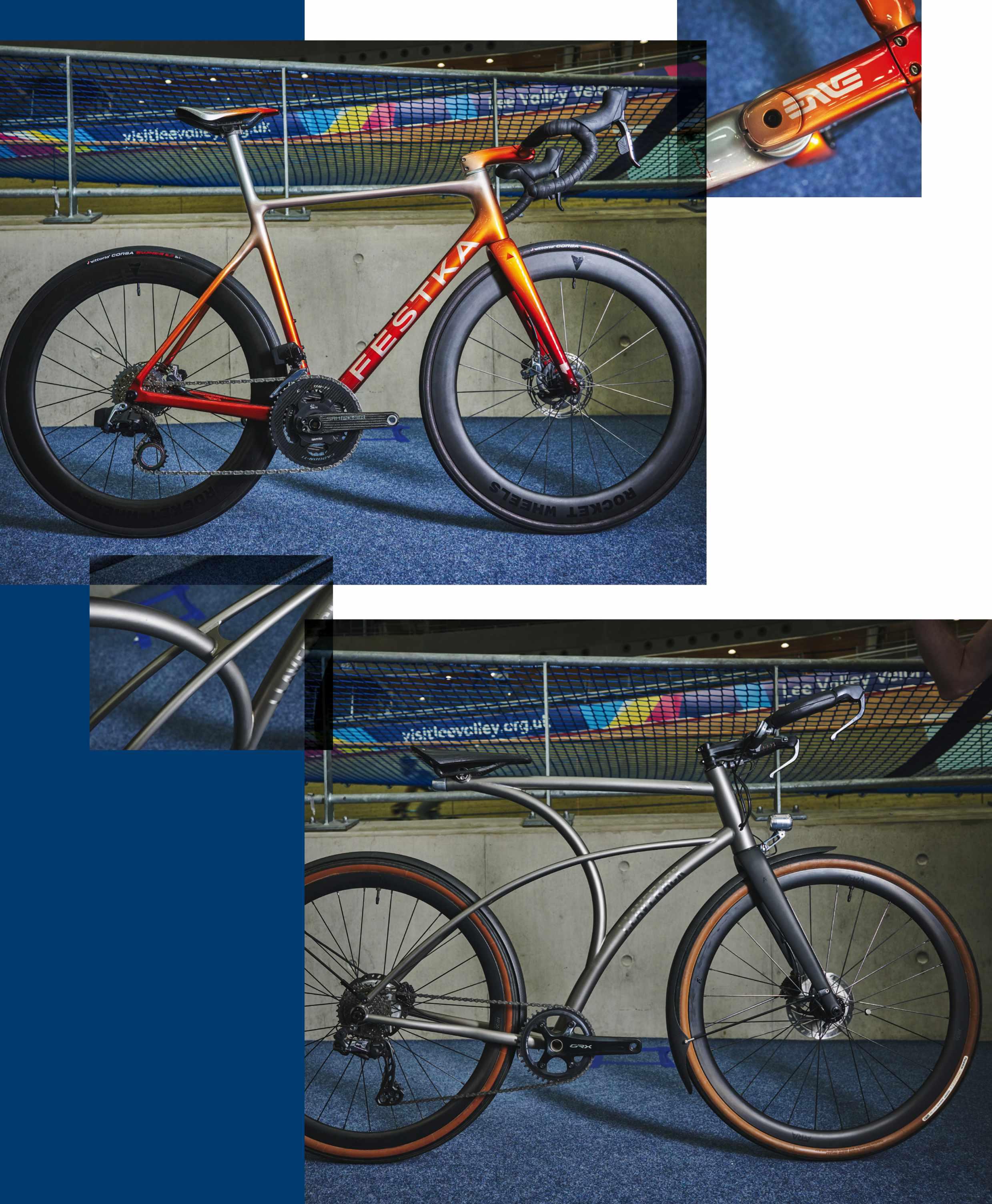
J.Laverack lovingly designs and assembles all of its bikes at its Rutland HQ and isn’t afraid to divide opinion. This beautifully sculptural titanium CURV.3 concept commuter bike, a collaboration with ex-Aston Martin clay modeller Garry Barker, is a case in point. “The thing I like about this design is that not everyone is going to like it. What you don’t want is a design that people have no thoughts about,” said Barker, who wanted to challenge the ubiquitous straight-lined, diamond-frame bike shape while using his favourite bikeframe material, titanium. We think it’s always great to see people bringing something new to the field and this frameset certainly does that!

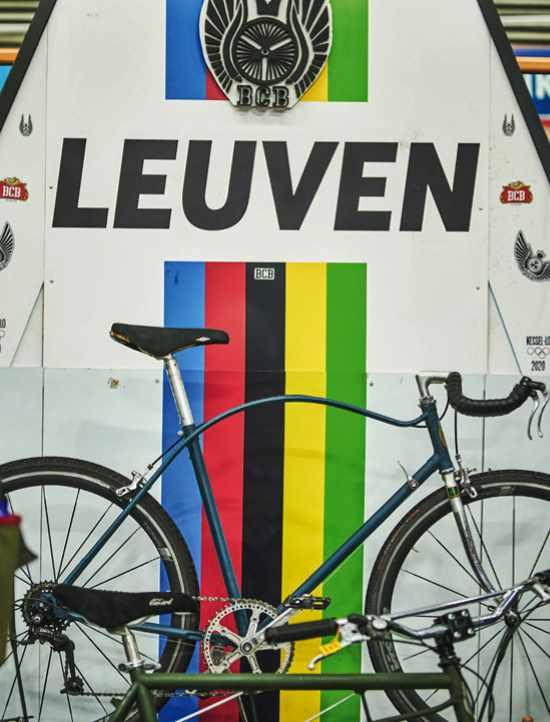

The GT-1 AR (£7,200), a handsome titanium build, is the personal bike of Aaron Barcheck of Mosaic Cycles, from Boulder, Colorado. With the Rockies on his doorstep, he’s designed the bike for all scenarios, as it would be a crying shame to have a bike that couldn’t handle its fair share of gravel. Frames can be made to measure: get in touch with Stephen Roche at The Bike Tailor with any questions.



Based in Somerset, Andy Parsons has put his past helicopter-based mechanical engineering experience to use in the world of bikes. A twoweek course at The Bicycle Academy in Frome helped him to transfer his substantial skills to develop the steel Omni frameset (£1,800). Designed to be a fast, comfy road bike with space for 38mm rubber, the incredible finish has a subtle LXX | XXX in the paint to hint at the 70/30 road/gravel design.
In common with a lot us, cycling represents freedom for James Bleakley. With his background in BMX, cross country mountain biking and everyday commuting, the oneoff titanium Klunker (£11,000) represents the zenith of a frame-building career that included welding titanium at Colorado’s Dean Bikes before his own brand, Black Sheep Bikes, began to consume his attention. This frame has telescoping chainstays for chain tension as well as tube splitters in the seatstays, which allows for complete removal of the rear triangle for travel. While this may look simple, it added a huge amount of labour to the fabrication process.
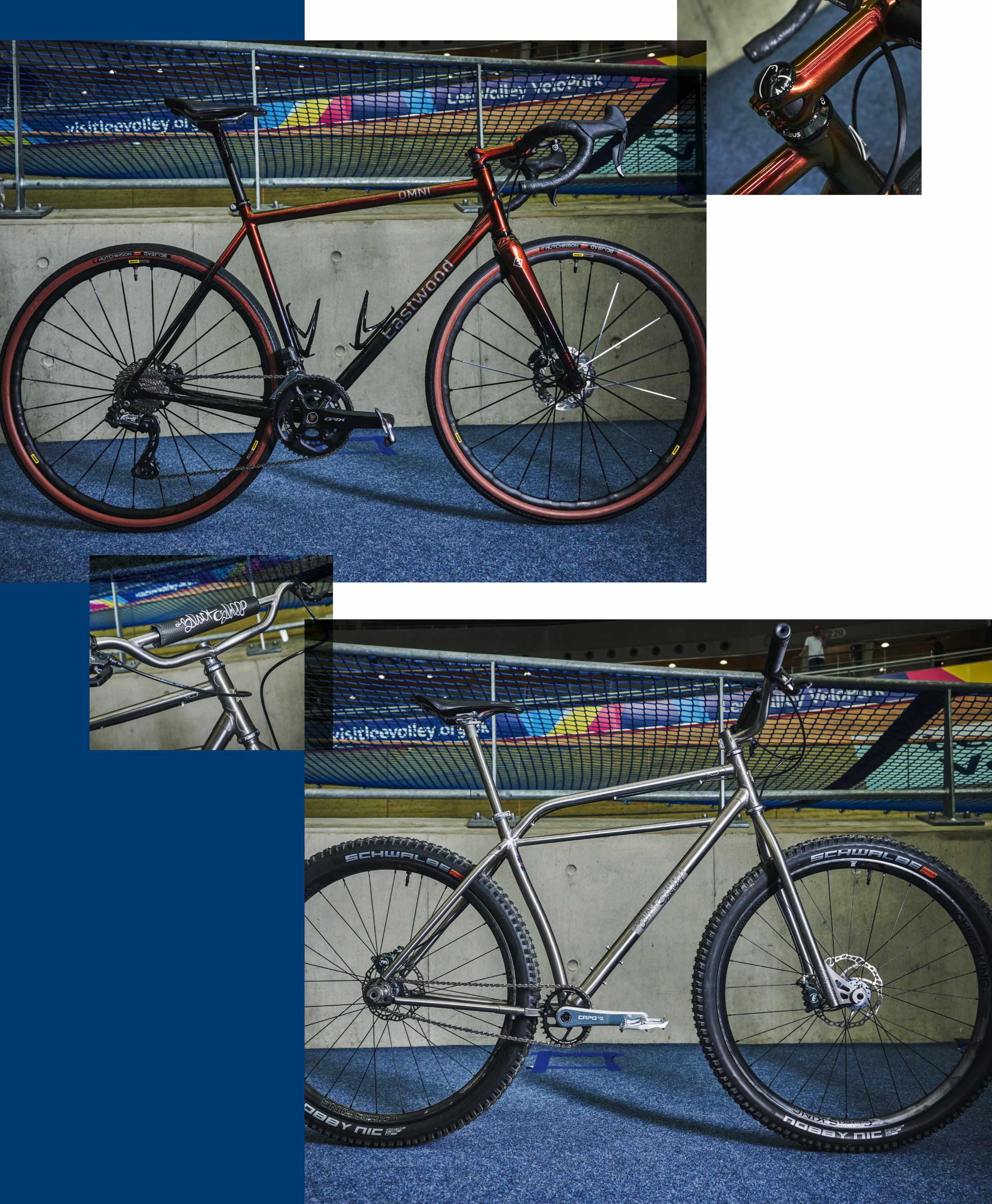
Sam Fish came to this design (£3,380) while swapping out different components to create a truly custom (and variable) geometry and realised that he could integrate this idea into the frame. A minimal weight gain is offset by the advantages the adaptable geometry gives. Sam’s other work alongside artists and designers can be found in museums and galleries. Maybe this one will appear in the Design Museum?

Disc brakes, Campagnolo Ekar groupset, gravel tyres... in the NS Safari, Moulton has a bike up for anything. Front and rear suspension is handled by the Moulton’s own designs: Flexitor and Hydrolastic respectively. The frame’s a mix of Columbus and Reynolds tubing, fettled in this stunning green finish. Have separable (not folding) bikes ever looked better? With front and rear rack/pannier mounts and a weight of 10kg, there’s added practicality to go with the desirability.
 Left Built-in adaptable geometry makes this bike stand out
Above The Norfolk-based firm can make you a frame in 8-10 weeks
Left Built-in adaptable geometry makes this bike stand out
Above The Norfolk-based firm can make you a frame in 8-10 weeks
Bespoked 2022 brought exhibitors from Colorado, Namibia and Australia, but few makers face current challenges as urgent as 7Roads bags (7rbags.com) from Kovel in Ukraine. Elena and Stanislav’s motto is “Ride your bikes where even wolves are scared to shit”, and these bags are designed to be tough enough to enable that. The war hasn’t stopped them producing bikepacking bags – off-theshelf and custom – and some can even be found with friends who are fighting Putin’s invasion on the front line.



Here is a simple, sustainable option for your rear end. Evan at Frame Cycles in Glasgow (framecycles.com) has developed a cork saddle and is on the lookout for beta testers. In one fell swoop a cork saddle replaces the hard plastic, foam and polyurethane you’ll find in a conventional saddle and measures up well in terms of cushioning, friction, density and weight, as well as being an infinitely more sustainable and individual option. Titanium rails complete the 320g, 268mm-long package.

“Does the world really need another bicycle brand? No. But my hometown, Omaruru, does!” These are the sentiments of Onguza founder Dan Craven, ex-pro cyclist and proud Namibian. A true labour of love, this new socially aware brand was supposed to be launched with Dan riding an Onguza frame at the Tokyo Olympics but Covid got in the way. So a trip to Bespoked was a great opportunity to put these world-class, steel framed bikes in front of an appreciative audience. The Gravel Model 1 (£3,500) is designed for ultradistance gravel riding over tough terrain and it looks like exactly the tool for the purpose.
The new Hiplok D1000 is the world’s first portable anti-angle-grinder bike lock. Here’s how it works
WITH ANGLE GRINDERS becoming the weapon of choice in theft attacks, Hiplok’s recent product launch sends a strong signal to the bike thief. “The D1000 lives up to everything Hiplok promises and more”, according to GearJunkie’s resident lock tester. But with a price tag of £250, keeping your bike safe doesn’t come cheap. We take a deep dive into the technology behind the Hiplok D1000 and ask the fundamental question: “Is it worth it?”
D1000 features a high-performing, graphene-reinforced composite called Ferosafe, which has unrivalled anti-cut properties. Never-before seen in bike security, Ferosafe has been designed to disintegrate angle-grinder cutting wheels and drills due to its unique properties.
A quick online search will throw up footage of D1000 in rigorous, head-tohead tests showing D1000 destroying multiple angle grinder heads, while other locks fall by the wayside.
Long hailed for its innovative approach to practical product development, Hiplok founders John Abrahams and Ben Smith
have broken new ground with D1000. The patent-pending design features a layered shackle system, which allows Ferosafe to be added right along its steel core. This ensures the lock is protected from all angles of attack, meaning the thief will hit the angle-grinder-eroding material first, while the hardened steel protects against more traditional forms of attack.
The D1000 features a high-security cylinder with an anti-rotation doublelocked shackle, armoured with Ferosafe plates. This means that apart from being hard to pick (a method of attack that’s highly unlikely from a professional bike thief anyway), a thief would need to cut through both sides of the shackle to remove the lock – a feat Hiplok says is unlikely in real-world theft scenarios.
Weighing in at 1.9kg, D1000 is by no means a featherweight, but it is comparable to many higher-security D and U models on the market. Real-world use has also been thought about: a hardwearing, rubber shackle coating protects the frame from scratches; while small details such as a rubberised weather-
proof key seal make this lock extremely user friendly when you’re out and about.
Tried and tested Independently tested and carrying the ultimate Sold Secure Diamond rating for bicycles and motorcycles, D1000 has left us questioning whether there needs to be a new Platinum standard. The lock’s ability to surpass the 90-second sustained angle grinder attack for the Diamond rating is unprecedented – with other testers reporting over 20 minutes of attack time and multiple grinder discs destroyed in the process.
Not all locks are created equal, and the Hiplok D1000 is certainly re-setting the bar high, receiving the outstanding accolade of “The most effective portable security device I have ever seen,” by John Milbank, consumer editor of Bennetts Bike Social.
There is no doubt that the D1000 is a gamechanger offering class-leading security in a package that is usable for the real-world cyclist. But is it worth the money? Think of it like this: if somebody stole your bike, how much would you pay to get it back? We’d recommend you avoid the hassle of answering this question for real and upgrade your lock now.










The desire to win, be better and achieve above The desire to be better and achieve above expectations For the time being, the team has expectations. For the time the team has surrendered to the commercial forces of modernday road teams But we all know that behind every road teams. But we all know that behind every cycling team, and sponsor lies a simple passion and sponsor lies a for our great sport. If anyone tells you sponsoring for our If anyone tells you road teams is a commercial decision, they are road teams is a commercial decision, are kidding you…It’s a passion decision! a decision!






I ADMIT TO BEING A BIG FAN OF the TCR: the combination of razorsharp handling and a ride that’s stiff in the right places and forgiving where it needs to be are compelling reasons enough. I also like that, in this era of complex integration of everything, the TCR keeps things simple.
It makes a bike that’s easy to maintain, easy to pack for travel, and easy to upgrade should you want to. Giant also deserves plenty of recognition with the

2022 Advanced Pro 2, as in these times of supply chain issues, Brexit-induced price increases, inflation, shipping cost increases and more, Giant has maintained the price of the Pro 2 from 2021’s £3,499. That is impressive and certainly not something to be sniffed at, especially when you consider that the Pro 2 comes with a raft of quality components – not least of which is a set of 42mm full carbon wheels in the form of Giant’s own SLR1s. These come shod with Giant’s hardy Gavia Course 1 tyres in a slender 25mm. Giant supplies bikes with tubeless tyres set up ready to go, with seated tyres filled with sealant (and spare sealant included).
It means the wheel package rides as it should, and while the Gavia may not be the fastest tyre around, it rolls well and feels compliant over poor surfaces, gripping tenaciously in the corners throughout all of my dry test rides. Ideally, I’d upgrade the tyres once they’d shown a bit of wear, and to cope with the poor condition of most of my local roads I’d also up to a 28mm width for good measure, and comfort’s sake.
Just a few short years ago, a Shimano mechanical 105 groupset would have been the stalwart on bikes around £1,500£2,000. This TCR costs around double that; in comparison, Specialized’s SL6 Tarmac Sport is £3,500 with 105 and alloy wheels, and Cannondale’s SuperSix Evo is £2,850 also with 105 and base-model alloy wheels. That Giant has included carbon wheels to up the value makes it stand out in the crowded £3,500 bike space.
If you think that means I’m down on Shimano 105, then that couldn’t be further from the truth. This iteration of Shimano’s sporting workhorse is superb: the shift speed and accuracy are excellent, and the braking full of feel and power. You can get the rather basic brake rotors to elicit a squeak or two once they get full
of heat, but vocal outcries aside, they’re confidence-inspiringly consistent. The front mech can require a bit of trimming on occasion when getting toward either end of the 11-30 cassette as you can get a bit of light buzz when the chain line is less than optimum. The gearing of 52/36 with an 11-30 is a very sporty set-up so the emphasis is on speed; that said, I didn’t find myself wanting for a lower gear as the combination of the light wheelset and the dynamics of the frame make this TCR a brilliant climbing companion.
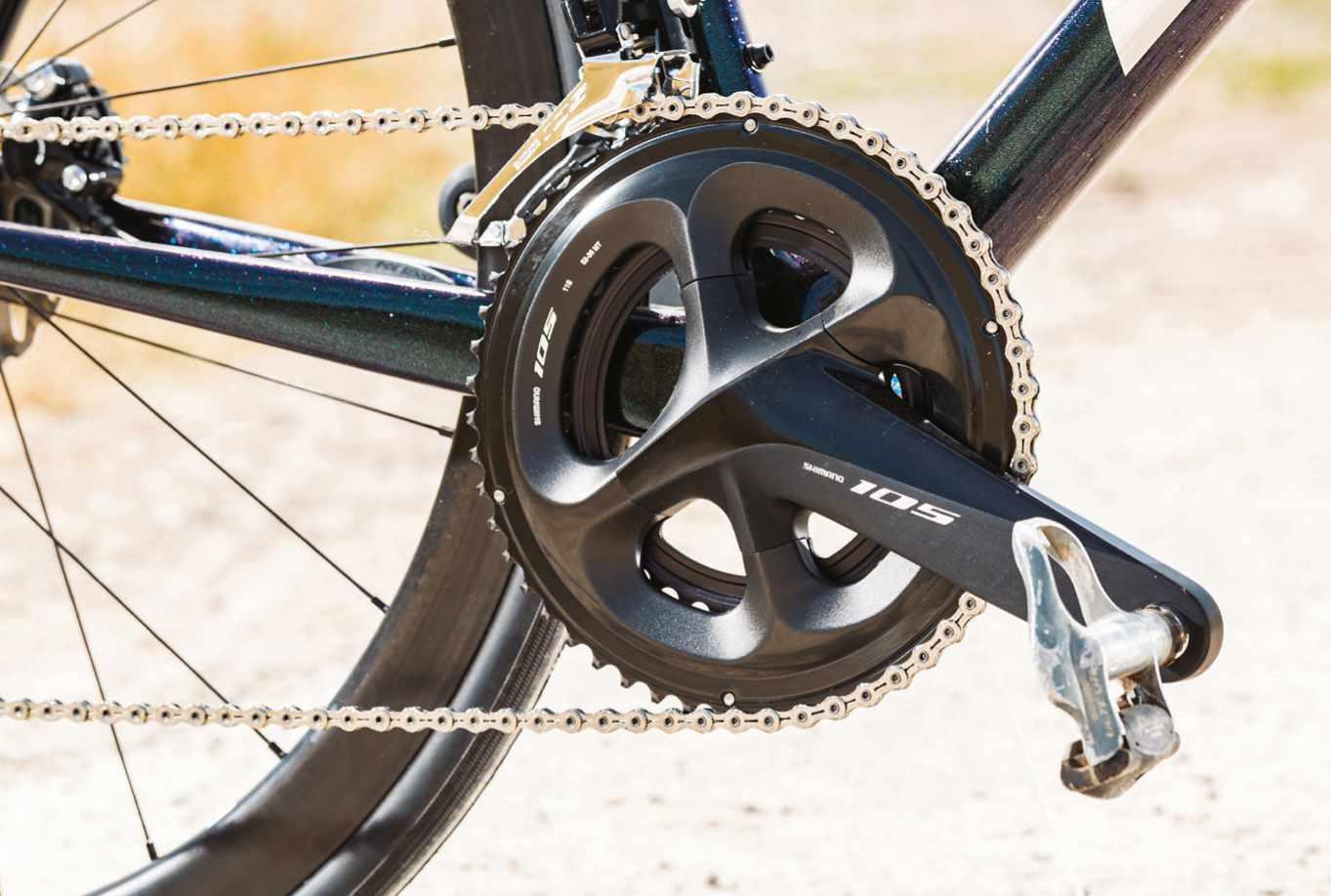
At 8.19kg the TCR is light for a bike at this price (and size), and it shows when you pile pressure on the pedals. In fact, I was impressed at just how similar the Pro 2 feels to the featherweight range-topping TCR Advanced SL0 (6.71kg in the same size). The ride position, with a low stack (for a large) of 581mm and a long 402mm reach, puts you in racy mode from the off, and in this instance that’s a great thing. The responsiveness of the frame and fork just impresses every time you stand up and charge forward. The stiffness through the bottom bracket is matched gloriously by the solid feel through the front end, which combine to create a bike that wants to go fast and changes direction


with the same eagerness, with a superb front-to-rear balance that absolutely encourages you to quite simply go for it at every opportunity. The TCR also tracks straight and doesn’t get unsettled by poor surfaces, ruts or bumps. Again, I’d have preferred a bigger-volume tyre though; the 19mm-wide hookless rims of its SL 2 wheels would revel in being wrapped with a quality 28mm tyre (the frame can take up to a 32mm).
Overall, the Advanced Pro 2 lives up to the TCR legend: it’s flighty, fast yet forgiving and represents class-leading value to boot. The only changes I’d make would be the tyres for personal reasons, and not until the tyres fitted had worn down; and it’s not often I can say that about any complete bike, let alone one at this price.

 Above The TCR”s simplicity allows easy maintenance
Below The bike is fitted with highquality components
Below There’s room for much wider tyres of up to 32mm
Above The TCR”s simplicity allows easy maintenance
Below The bike is fitted with highquality components
Below There’s room for much wider tyres of up to 32mm
Warren Rossiter
“I was impressed at just how similar the Pro 2 feels to the featherweight range-topping TCR Advanced SL0 (6.71kg in the same size)”
Verdict A brilliant bike that’s very well equipped for the pricePhotography Russell Burton
£2,500 Transformative ride quality, but at a price
ASIDE FROM IT NOW BEING tubeless-compatible, the Alpinist CLX II isn’t hugely different from its predecessor, which was impressively light and improved the agility and overall ride quality of any bike it was mounted to.
The Alpinist’s 33mm-deep carbon rims now have more layers of carbon, helping ensure tubeless tyres remain seated on severe impact. This weight gain is offset with updated hubs so the CLX II is still the lightest wheelset Roval has produced, at 1,265g including tape and valves. Many wheel brands are shifting to hookless rims, yet the CLX II retains a hooked design. According to Roval, a hooked bead gives another layer of security and offers the broadest range of compatibility with tubed and tubeless tyres, while avoiding sacrifices in strength or cut fibres. The CLX II is optimised for 26mm-wide tyres.
the CLX II was most apparent when riding on rough-hewn byways that can transmit high-frequency vibrations from the bike to the rider, and while the hum was still present, it was damped and less of a distraction. As expected, the CLX II was at home traversing mountain passes. This 1,265g wheelset spun up to speed quickly and was a nimble companion when changing direction through hairpin switchbacks. While I can’t speak to its performance under riders near the wheelset’s 125kg weight limit, I found the steering precise, and flex wasn’t an issue.
The Good Light; responsive; broad tyre compatibility; high rider weight limit
The Bad Steep price tag; Roval’s crash replacement warranty lags behind competitors
I spent three months testing the CLX II on high mountain roads and mixedsurface routes through the foothills and plains of Colorado. The weight savings weren’t substantial over the Shimano Dura-Ace C36 wheelset it replaced (less than 100g), but there was a notable improvement in ride quality – these lighter, lower-profile wheels did a better job of muting road buzz. The refined ride quality of
With 30mm-wide tubeless tyres mounted, the wheelset tackled hardpacked dirt with ease. The muted ride of these wheels, along with the larger footprint and lower pressure of the wider tyres, gave confidence through potholes and over the chatter of braking bumps. If, like me, your favourite “road” rides include sections of smooth dirt and gravel that can be ridden on 30–32mm tyres, rest assured the Alpinist CLX II is up to the challenge. In all, these wheels are light, agile and supremely comfortable on rough roads, making them great, not only for weightconscious climbers, but for any cyclist searching for a comfortable set of wheels.
The one area Roval lags behind its competitors is its short, two-year crashreplacement policy, with discounted crash-replacement coverage after that (it does have a lifetime warranty against manufacturer defects). Some other brands offer longer or lifetime crash-replacement programmes. Josh Patterson
02
Hooked rims
Hooked reinforced carbon rims give riders the option to run tubed or tubeless tyres

“If your favourite ‘road’ rides include sections of smooth dirt and gravel that can be ridden on 30-32mm tyres, rest assured the Alpinist CLX II is up to the challenge”

ALONGSIDE A TOUGH, HIGHLYrated lock or two, you may want to add a security tracker to your bike to help deter thieves. One option is to add an Apple AirTag to your bike, and the likes of MucOff offer discreet holders. Knog, however, has taken things a step further with its own tag that has a loud alarm as well as app support for tracking and arming the system.
The 35.7g unit (including cover and hardware) is designed to fit on your bike’s bottle cage bosses and comes with long bolts so you can fit a bottle cage on top. This is the stealth option as the matt-black lozenge shape looks like the base of a composite cage. Or you can use it alone with the supplied security bolts, special tool and hi-viz yellow rubber cover for a more obvious deterrent.
The Scout charges from a USB-C power source and battery life is
a claimed six months. After testing it for three months, the battery is showing 60% (on the app).
The Scout is activated via Knog’s Mobile app and, once paired with your iPhone, the
tested the 85dB alarm at a crowded railway station cycle stand, it definitely got people’s attention!
If your bike’s moved, you’ll get an alert via text to your phone, then you can track the bike’s movements via the Find My app. I fitted the Scout to my partner’s folding bike and was able to track her and her bike travelling to her office, a 40-minute train journey and three-mile ride, proving it worked with a range of around 75 miles.
Scout is recognised as a device in Apple’s Find My app. The Scout sends out a Bluetooth signal so it can tie in with other devices on the ‘Find My’ network (iPhone, iWatch, iPad) to help locate your bike, similar to how AirTags work.
Knog’s app also allows you to arm and disarm the Scout’s alarm remotely plus set the device’s sensitivity to being moved and alarm settings (tone and volume). When I

A stand-alone AirTag is £35 and MucOff’s holder another £29.99 (and an AirTag doesn’t come with an alarm), so the £49.99 price tag seems fair. If you’re concerned about leaving your bike (who isn’t?), I’d recommend the Scout for giving you an extra layer of security in the constant fight against thieves. But only, of course, if you’re an iPhone user.
Rivals...
Apple AirTag £35
Muc-Off Secure Tag Holder £29.99*
Sherlock GPS £139.99 (+£2.50/month subs)
Warren Rossiter
“When I tested the 85dB alarm at a crowded railway station cycle stand, it definitely got people’s attention!”
DayBright - Unique pulse pattern designed for daylight use, more obvious than a regular “flash” and visible from over a kilometre away, even in the brightest conditions.


● THE STANCE IS A FREESTANDING, minimally sleek plywood birch home bike stand that looks as good as a piece of furniture, allowing your pride and joy to stand on show wherever you like. It arrives flat-packed, assembles easily in about five minutes and is fully adjustable for any model, from kids’ to fat bikes, with a twist of a knob. There’s no frame contact to ruin your paintwork and I’ve been impressed by the rock-solid grip on all bikes. The Stance is the best excuse you’ve been looking for to keep your bike in the house. Russell Burton

THE KS RAGE-IS IS A RARE BEAST: it’s a dropper seatpost that also has adjustable air-sprung suspension. The post is sold as being suitable for a wide range of ride styles but I tested it on a gravel bike over my regular routes that include tarmac, tracks and more rugged trails. The 415mm-long post has 10mm of travel and weighs 497g, with a 27.2mm diameter.
difference to adding comfort and reducing fatigue on long rides.
● THE GENEROUS FIT AND soft-feel fabric made from recycled polyester make this a top with a conscience that you’d be comfortable in on long days in the saddle. There’s ample room for a winter baselayer underneath, but if you work up a sweat, odour-inhibiting and wicking properties will help keep you feeling fresh. As well as the usual three back pockets, there’s a useful zipped pocket there too that fits my mobile phone and keys. There are also men’s styles, and lots of sizes. Emma Lewis

Designed for internal routing, the RageiS set-up initially seems straightforward, but the cable is clamped at the post end rather than the lever, which means it takes some trial and error to get the tension spot on. That aside, the build quality is excellent.
Dropper functionality for gravel is a personal choice: I find when I have one fitted it gets used all the time, but when there isn’t the option I don’t really miss it. What I do always appreciate is that when a suspension seatpost works well for gravel it takes out all the small-bump chatter and can really make a
The dropper operation here is responsive and smooth, but I’ve struggled to get used to the suspension, which doesn’t have a lockout option to disable it when it’s not needed. This meant I experienced an unwanted combination of energy suck on smoother terrain, plus the problem of hitting the right amount of drop to take into consideration the suspension movement on rougher ground. Increasing the air pressure in an effort to reduce the constant motion of the suspension meant it only kicked in over bigger bumps and deeper ruts. Effectively, I’d disabled the most important benefit I look for in a seatpost of this type.
The above, together with the ache in my knees that followed every ride with the Rage iS, brings me to the conclusion it’s definitely not for me. Russell Burton
The Good Well made; smooth dropper action
The Bad No lock-out option on the suspension

● AS WE EXPECT FROM SWEDISH brand Thule (say ‘too-lee’), this 27l commuter backpack is practical, durable and full of cycling-specific touches such as a pocket for a bike lock and helmet, an enclosed hi-vis rain cover and stash areas for bottles. The laptop sleeve is sizeable and reinforced, and the main section had room for my cycling kit plus sarnies. At 52cm long, I found it quite lengthy (anyone over 168cm might not agree). But, with comfortable straps and a breathable mesh back area, overall this bag justifies its price. Matt Baird

£65 Stylish MIPS-equipped urban helmet
Van Rysel Photochromic HD RoadR 920 £64.99


● THESE ULTRA-LIGHTWEIGHT 27G glasses adorned my head on our 400km ride (see p50), and a weekend of riding in sunshine and rain at the Lombardia Gran Fondo. The good? The winning RRP and clarity of the photochromatic lenses, and their refusal to fog no matter how much heavy breathing I produced. The bad? That frameless design makes them more vulnerable in crashes and café stop-clumsiness, while the lens extends quite high on the forehead, which could clash with protruding aero helmets. Matt Baird
THE URBAN-FOCUSED TONE helmet has a certain Star Wars Rebel soldier look to it with its muted two-tone design and solid-looking outer shell. Look a little closer and you’ll find a single fullwidth vent on top and a large exhaust port on the rear. Inside the helmet, the EPS foam core has pronounced channels cut into it, which keeps the minimal air coming into the helmet moving and helps to help cool your head.
liner, which is rare on urban helmets, especially at this price. This low-friction insert allows for a sliding motion of 10 to 15mm in all directions. Independent studies indicate that the MIPS system reduces harmful rotational forces to the brain during angled impacts. The Tone meets all current helmet standards and has achieved the highly regarded 5-star rating from the specialist helmet-testing operation at Virginia Tech.

Sizing is generous and Specialized’s SX fit system combines tri-fix web straps that stay in place and don’t roll or fold, though they aren’t adjustable so it’s worth trying before you buy. The rear cradle is a simple two-point anchoring system with a nice fine-adjustment, two-way dial that made it easy to cinch up tight. The cradle can hold an ANGI crash sensor (sold separately).
The Good MIPS protection and high safety rating; great for cooler days
The Bad Can get stuffy in the heat; no strap adjustment around your ears

The Tone also incorporates a MIPS
The Tone’s 352.3g weight for a size Large is good for a full-coverage helmet of this type and on the bike the Tone works well. Its minimal but well-placed pads add comfort and dry quickly. On warmer days the Tone can get a little stuffy, but for cooler days and winter commutes I’ve appreciated the extra warmth, and the lack of vents does keep the rain out too. Subtle reflective print adds a bit of visibility but there could be more of this. Warren Rossiter
Rivals...
Bollé Eco React MIPS £140
Nutcase Vio £120
Kask Moebius £89


THE KOALA IS handmade in the UK from a waterproof threelayer laminate and tough 1100D Cordura. The seams aren’t taped but Alpkit’s Airlok Tapered dry bag (£15.99) can be used inside it. The Koala has the usual pair of nylon straps that loop over the saddle rails and attach at the rear of the stiffened base, and three compression straps by the rolled opening. Two Hypalon straps secure the pack to the seatpost. An upper sleeve allows the Koala to slide onto the Exo-Rail mounting system, whose 6mm stainless steel frame reduces sway and bounce. Together, the Koala and ExoRail weigh 434g.

Fitting the saddle rail and seatpost straps is quick. The
Exo-Rail fits most seatposts with two inline hex bolts, but not those with single, or sideby-side bolts. A pair of 50mm hex bolts are supplied, along with a neat 50mm-long cradle which rests between the Exo-Rail and saddle rails. It can be a little fiddly to install, though, and may touch the tail of your saddle.
The Good No-nonsense, hardwearing design; ease of use; UK-made
The Bad No reflectives or rear light mount; dry bag and ExoRail cost extra
The sides of the Koala allow some light through to the spacious white interior, making it easier to find things. Used alone, the Koala’s size makes it prone to swaying, just like most of its rivals, but the Exo-Rail gives you a feeling of connected stability, which is more comfortable when you’re out of the saddle. The bag shrugs off average UK conditions well.
THIS ONE’S BUILT tough, its tightly woven Nylon fabric shell welded along its only seam, any external additions backed by welded patches, and a waterproof coating inside. Stiffened strips help to keep the bag open when needed, and to roll the closure tightly shut. Hardwearing Hypalon is used for reinforcing certain areas. A valve helps release unwanted air, an external bungee cord gives stowage options, there are three rearlight positions, and it’s highly reflective. The supplied X-Guard mudguard fits beneath and the combo weighs 500g.
Fitting relies on the usual combo of beefy seatpost strap and two saddle-rail straps. The rubbery Hypalon of the hook-
and-loop seatpost strap is component-friendly, and grippy, and the saddle-rail straps can be cinched very tight. Fitting the mudguard is optional, but two screws secure it quickly to nuts in the bag’s base.
The Good Tough fabric; reflective strips; external storage; mudguard
The Bad Stiffer fabric makes bag harder to pack; some swaying
The deepest part of the bag’s interior is yellow, which helps when searching for something, and access is very good. The bag’s stiffness, particularly with the mudguard fitted, minimises sway, but it does still sway when you’re out of the saddle. It’s not the worst, but can’t be ignored. The contents survived some intense rain unscathed, helped by the generously-sized mudguard, which kept the outside of the bag impressively muck-free too.
 Robin Wilmott
Robin Wilmott

£153 Solid protection, multiple colours and modern looks
OAKLEY’S ARO3 IS BIG ON ventilation. Also available without MIPS as the ARO3 Lite (£102), the MIPSequipped ARO3 tested here comes in three sizes and thirteen colours.
The Large 56-60cm size weighs 296g, which is reasonable. The EPS foam inner is mostly covered by an intricately shaped two-part outer shell, with only the vulnerable underside of the helmet, and the internal vent recesses exposed.
ineffective. Otherwise, the MIPS cap matches the helmet’s vents.

The Good Bold styling; glasses-friendly design; great ventilation;
MIPS
The Bad Try before you buy, especially if your head is around 60cm
There are three large vertical vents at the front, linked by deep internal channels to three dorsal vents. Channels behind the smaller triangular vents on each side (that also act as an eyewear dock when you’re not wearing your glasses) exit just behind each ear, and the rear of the helmet has two small exhaust vents, but they’re covered by the internal MIPS cap, making them rather
The BOA 360° fit system has a conventional rear cradle, which can be positioned at one of three heights, and has a reasonably large central opening that may fit a ponytail. Support at the back of the head is very generous, and controlled by the interwoven straps and thin BOA lace. This soft, braided lace passes around the flexible plastic strip which runs from temple to temple and helps support the front of the MIPS cap and antibacterial X-Static brow pad. Adjusting it via the rear BOA dial acts evenly all around the helmet, and helps give a secure fit. The lightweight straps have broad Y-shaped guides to avoid ear clashes, and sit flat against your skin.
Ventilation is very good, even at slow speeds in hot weather. Just be aware that the ARO3’s maximum size is 60cm and the shape’s not as round as some other brands. As someone with a round head, on the cusp of the helmet’s size range, the shell pressed lightly, but not uncomfortably, on the sides of the crown of my head. Robin Wilmott
● In the event of a crash, the two most common types of head impact are linear, where you hit something squarely; and rotational, caused by angled impacts, where the head rotates on contact (a common cause of concussion). In the latter, as the head decelerates to a stop, the brain can continue to rotate within the skull. It is designed this way to defend against injury from sudden impacts, but excessive forces can strain brain tissues, potentially causing brain injury. The original MIPS system is a web-like plastic cap that floats on elastic fixings within an EPS shell, but other versions are now appearing, such as MIPS SL, where it’s integrated into the helmet’s pads to keep the vents clear and reduce weight. Each version creates a slip-plane, much like the brain’s own, to slow or reduce potentially harmful rotational forces to the head.
7mesh’s British Columbia roots mean its designers know a thing or two about inclement conditions. The Seton Jersey’s newly developed WTV fabric combines a checkerboard woven loft fabric that’s like a super-soft fleece, with a highstretch outer layer that blocks wind and repels light spray. The close fit is enhanced by the highly elastic fabric, so the jersey moves with you rather than feeling restrictive. It’s also superbly well thoughtout when it comes to features. The fulllength zip makes temperature regulation easy, and the high, soft-lined collar keeps out the chills on cool mornings. Articulated cuffs allow winter gloves to snugly tuck in, while three high-stretch pockets, including twin zipped pockets on the flanks, provide masses of storage. It’s a great-fitting top that’s become my go-to for cool autumnal rides. There’s a women’s version too.
The men’s MK3 Cargo Bib Tights are a great companion to the Seton jersey and ideal for big days out in cool weather. The ‘cargo’ refers to the twin thigh pockets (ideal for empty gel packets!) and three rear pockets at the base of the Y-shaped bibs. The flat, broad braces sit smoothly, and the welded seams mean no irritation. Inside, a thick multi-density pad is just what I’m looking for in an all-day pair of tights. The articulated legs with preformed knee shaping are simply brilliant. Although they can look a little baggy at the knee when standing, they fit like a second skin when pedalling. The leg hems are laser cut from non-fraying material and 7mesh stitches in bar-markers so you can trim the length to suit. The close, compressive material repels spray well, while some subtle reflective details and print provide a little lowlight visibility.
7mesh Chilco neck warmer £30
The Good Warm, quickwicking, superbfitting jersey; tough bibs with plenty of storage

The Bad Not much reflective detail; hefty price
Warren Rossiter● Using the same soft, warm and comfortable checkerboard loft fleece as the Seton jersey, the Chilco the coldest chills at b th h autumn and into th d th f winter too.
neck warmer comes in matching colours to both the men’s and women’s jerseys It’ll keep e o est ch l t bay h u e
EELO’S 1885 HAS BEEN completely revamped for 2022. The bike now comes with custom one-piece alloy wheels which look sharp in their raw, polished-aluminium state. Mechanical disc brakes have replaced the old bike’s v-brakes and the engine has gained a little oomph and a trigger throttle to help you accelerate off from standing starts and to give a boost at the foot of hills. It’ll only kick in once it senses pedal movement, but the boost is pretty impressive.
The simple LCD display gives plenty of info and, unlike a lot of its mid-range rivals, the battery-level indicator is reasonably accurate. Eelo claims a range of up to 40 miles from the bike’s 280.4Wh battery. That may well be achievable if you
live in a relatively flat urban area, ride in the most economical of its three power modes and are a smaller, lighter rider, but I couldn’t get much more than half of that, as I live in a relatively hilly area and, at 6’2” and 90kg, it’s taking a fair amount of energy to move me. My longest run was 22.85miles/36.77km, albeit with a pretty hefty 3,133.2ft/955m of ascent.
I wouldn’t criticise the Eelo on range, however. This is a compact folding bike that, with its 89cm (axle to axle) wheelbase, is shorter than a Brompton (105cm) and it’s intended for shortdistance rides that last a few miles, such as commutes or short trips to the shops. Its folded dimensions (37cm x 61cm x 59cm) are nearly as good as a much pricier

Brompton, making it practical to stow in camper vans, caravans, boats or flats.
Its adjustability from a saddle height of 70cm to 98cm (from the floor) and a bar height of 80 to 103cm means it can cater for riders from under 5ft (152cm) up to around 6’3” (190cm), which could allow you to have a shared bike for the family or the office to use when needed, for example.
The downside of the dimensions, however, is the handling. The super-short rear end (36cm) means that taller riders like me are pitched way back over the rear wheel because of the seat angle when the long post is fully extended. It means the 1885 has a very light and slightly twitchy front end. I rode in a pitched-forward position, but with a backpack laden with groceries, the problem was worse: the bike wanted to wheelie on steeper inclines! My 5ft-tall partner had no issues with the handling when she borrowed it for her bike/train/bike commute, though.
The 250W motor in the one-piece rear wheel is impressively punchy. The three modes controlling the motor output are at their best when you use them a bit like gears (as the 1885 is a single speed). Use the high mode to start and get up to speed, then step down through the modes
increase your pace. On the flat, however, a relatively fit rider will soon find they don’t need the motor assistance. On hills, the motor provides ample power to smoothly assist you, though the short back end meant I had to lean forwards once the gradient ramped up beyond around 5%.
The folded bike is suitably compact, though at 17kg+ it’s not that light and the fold doesn’t properly lock in place as a Brompton, Tern or MiRider would. If you’re carrying the bike any sort of distance, this means it’ll need to be bagged (it comes with a bag which neatly straps to the rear rack).
For shifting on and off a train or bus, the 1885 does the job well enough, but it’s outclassed by the market leaders. It’s the same thing with the included equipment.
The Good Compact; lots of standard equipment; launch throttle makes riding in
The Bad Not great for tall riders; not that stable on the hills; nonremovable battery
The front light is wired into the battery system and can be operated by the controller, which is good. But the rear light straps to the seatpost and isn’t integrated. The rear rack is neat and generously sized to fit a bag, but there isn’t room
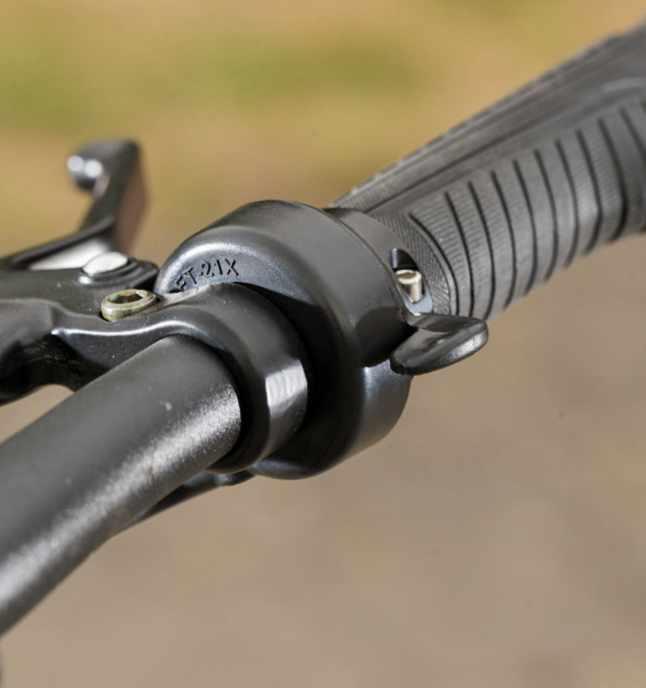
to carry the bike bag at the same time. And because the wheel size is small (14 inch), you can’t fit panniers.
The Eelo is easy to live with. It’s compact, easy to adjust and easy to ride and the compact charger slips into a backpack pocket easily. However, the battery is fixed and the charge port is under the main frame so you’ll need to keep the whole folded bike near a power source to charge it. The five-hour charge time is shorter than the working day, so you could top up the 1885 for free at the office and potentially use it for long commutes.



Impressively, it’s backed up with a threeyear, unlimited-mileage warranty.
I do, however, find it hard to recommend the 1885 to anyone taller than around 5’10”, and if you’re in the market for a compact e-folding bike at this sort of money then MiRider’s One just does things better. Its longer wheelbase and longer rear make it more stable for taller riders too. The Eelo isn’t a bad compact folding ebike, it’s just not the best I’ve tested. Warren Rossiter
 Above A trigger throttle helps give you an extra boost
Below right As it doesn’t lock folded, you’d need to use the bag to carry it very far
Below The punchy 250W motor sits in the rear hub of the compact 14” wheel
Above A trigger throttle helps give you an extra boost
Below right As it doesn’t lock folded, you’d need to use the bag to carry it very far
Below The punchy 250W motor sits in the rear hub of the compact 14” wheel
“This bike’s folded dimensions are nearly as good as a pricier Brompton’s, which makes it easy to stow in caravans, boats, camper vans or flats”
Verdict A perfectly good compact folding ebike, but bettered by similar-priced rivals
traffic easyPhotography Russell Burton
● THESE BARGAIN-PRICED mudguards come in 26in x 60mm, and 700c x 35mm or 45mm, in black or silver plastic. They attach with parallel twin stays, with Secu-Clip fittings designed to release the stay if anything gets jammed between the mudguard and the tyre. Spray protection depends on the combination of tyre

and mudguard width you use, and the 45mm tyres on my test bike were dwarfed by the generous width of these ’guards. The only places where spray escaped them was from the front of the front wheel at speed, and from the rear of the rear wheel, despite the good-sized flaps on these slightlytoo-short mudguards.
● ZEFAL’S RESIN MUDGUARDS give extensive protection thanks to their moulded shape, and solidity, through their shaped stainless steel stays. The rear mudguard comes in three sections, clicking together at the seatstay bridge, and screwing together between the two stay mounting points. The front mudguard clips together at the fork
crown mount, and has a single U-shaped stay low down at the rear. On my test bike the bulge from the mounting bracket dictated fitting it behind the fork crown, to leave enough tyre clearance. They worked well with 32mm tyres and were rattle-free, but the fitting quirks can limit tyre clearance on some frames.
● A CLASSIC DESIGN, THESE robust ’guards come in black, latte or silver Chromoplastic. The front mudguard’s stainless steel stays fix easily to the fork leg or dropout with the SKS breakaway Secu-Clip. Fitting the rear mudguard is easy too, but the rear stays don’t have the Secu-Clip. Excess stay can be
cut off, and plastic endcaps added to cover the sharp ends. The 35mm width works for tyres up to 30mm, and the slim, snug-fitting ’guards allow easy adjustment for optimum positioning. They simply refuse to rattle and their curved profile and generous lengths with rear flaps mean little spray escapes.
● MADE FROM IMPACTresistant polycarbonate, these offer useful width for some modern endurance or gravel bikes. With a similar build to SKS, each ’guard has two stainless steel bridges for the V-shaped stays to attach to, and the front mudguard has SKS-style safety clips. The 42mm width copes well with tyres measuring 35mm,
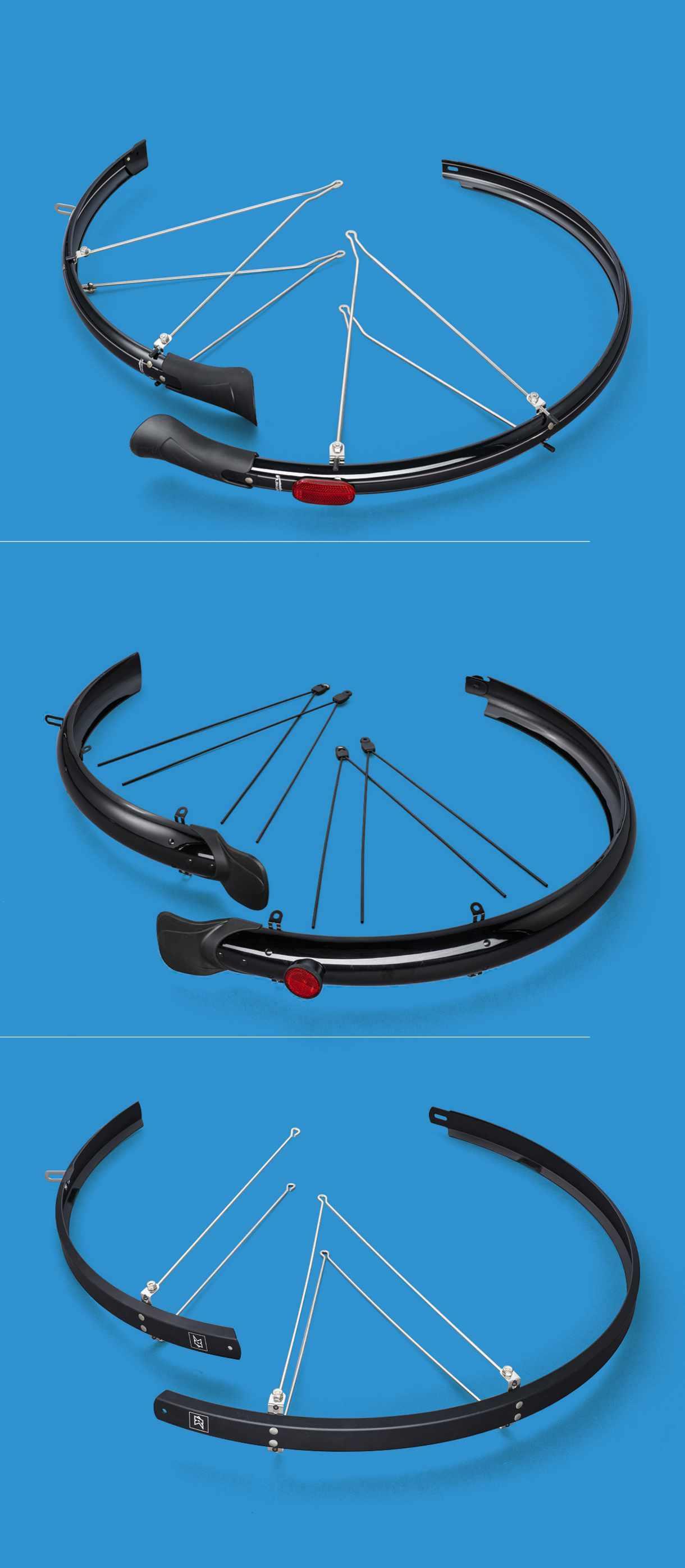
Widths 35, 42, 50mm 05 M-Part Primoplastic £46.99
its slim profile maximising frame and tyre clearances, and the stout stays keep everything stable on rough surfaces. Decent flared flaps work well. The rear mudguard has a useful red Cateye reflector and, although not as long as the SKS Longboard, gives very good wheel coverage. These are simple to fit, effective and easy to live with.
● M-PART OFFERS THESE polycarbonate mudguards in five widths, and different colours, with stays in stainless steel, or blackcoated stainless steel. Their profile is classically rounded, and only trimmed to fit between the chain stays, so check the available width of your frame before choosing a size. The stays have Pop Off safety
Widths 38, 46, 50, 60, 68mm 06 Kinesis Fend Off £60
Widths 40, 50mm
● THESE ALUMINIUM ’GUARDS come in two colours, and the wide version costs £65. The maximum recommended tyre widths for each size are 34mm and 45mm respectively. They’re around 200g heavier than their plastic rivals, at 637g, including hardware. Kinesis supplies most, but not all, fixings.
couplings, similar to SKS SecuClips. Flexible flaps are stepped away from the tyre as they flare out, to intercept more spray. The rear also has a reflector. There’s good coverage at both ends, with the rear covering just over half of the 700c wheel. The 68mm width easily covered the 45mm tyres on a gravel bike; 50mm tyres also fitted.
The polypropylene packaging is designed to be converted into flaps, with cutting guides and fixing bolts supplied. The flat profile gives more tyre clearance, but they may touch your frame. Add the flaps and these stable ’guards are a great long-term choice for committed all-weather riders. Robin Wilmott
A performance-boosting winter musthave, mudguards will keep you, and the person behind you, cleaner and drier, increasing everyone’s ride enjoyment
CYCLING PLUS: Before we get into the benefits of tubeless tyres, what actually is a tubeless system?
STAN’S: “Tubeless tyre technology for bikes is exactly what you’d imagine from the name – it does away with the need for inner tubes. Tubeless is now the default option for mid-range and high-end gravel bikes, and it’s becoming increasingly popular for road bikes too.”


Do I really need this for my road bike or are tubeless tyres just for gravel and off-road riders?
“Road tubeless offers the same benefits as tubeless mountain bike applications: fewer flats, lower rolling resistance, more comfort and more traction. And, if you do experience a pesky puncture in your tubeless set-up that your sealant can’t prevent, they’re easier to fix on the fly with our DART tubeless repair plug, which forms an airtight bond with our Stan’s sealant.”
How do I know if my wheels and tyres are tubeless-ready?
“Most current 700c road rims are tubeless ready but make sure you have a quality tubeless rim tape, a universal valve, sealant and a road tubeless tyre. Check with the manufacturer of your rim and tyre for their recommendations on tubeless use before conversion as there are still some rims that aren’t compatible.”
What is the process to go tubeless?
“The process sees sealant poured into the tyre or injected through the valve and helps plug any tiny leaks. This sealant stays liquid inside the tyre and will heal small punctures suffered while riding.”
Do I need to amend my normal PSI levels when going tubeless?
“Rider weight and terrain will help you determine your preferred pressure, but a good starting point is 10% lower than you would run with tubes.”
£4
● The product that helped start a tubeless revolution. Just 60ml of Stan’s in a converted standard or tubeless tyre can repair punctures up to 6.5mm almost instantly to keep you rolling.
● These DARTs don’t just plug large slices and punctures in your tyres – they react with Stan’s sealant to form an airtight bond. Includes 5 DART Refills (required DART Tool not included). Grail CB7
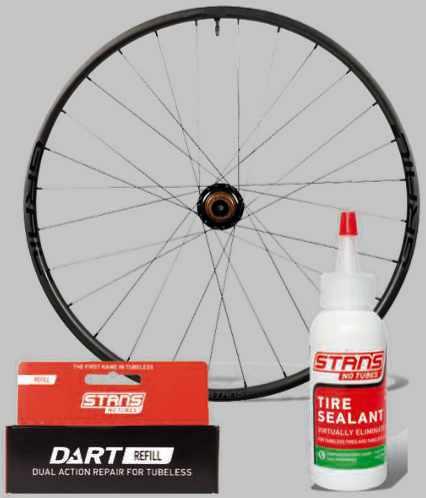
● An ultralight 300g carbon rim engineered to absorb impacts is combined with a durable and smooth-rolling M-pulse hub to create great tubeless wheels for gravel and adventure road riding.

Clean the rim with isopropyl alcohol or a similar residue-free cleaner and allow the rim to dry. Ensure the rim is free of factory-installed tape or rim strip.
⚫ Start to tape your rim opposite the valve. Install the tape evenly and make sure you apply tension on the tape. Overlap the tape by 8-10cm and cut with scissors. Aim for two revolutions for road wheels and smooth out the tape to eliminate any bubbles.
Using a sharp end of scissors or a knife, make a hole in the rim tape. Install the tubeless valve. The valve nut should only be finger tight.
Start, but don’t complete, the tyre seating at this stage.
⚫ Install most of the first bead (edge of a tyre that sits on the wheel). Aim to line up the logo or tyre info with the valve. ⚫ Install most of the second bead. Start opposite the valve as this will give more slack in the tyre.
Shake thoroughly. Invert the bottle and pour into the tyre, keeping the bottle inverted. For road and cyclocross tyres, we recommend 60ml. The sealant should
last an average of two to six months. ⚫ Finish installing the second tyre bead.
Apply plenty of soapy water to both beads of the tyre to help them slip onto the bead of the rim when inflating.
Don’t exceed the rim or tyre max pressure! Inflate tyre to riding pressure using either a floor pump or compressor.
⚫ Check the chafer strip and moulded concentric line, just above the bead of the tyre, to make sure it’s seated evenly. If not, use more soapy water to help the bead slip neatly into place.
Hold the wheel vertically and bounce it to disperse the sealant throughout the inside of the tyre. Let it drop from a height of up to about 5cm, then rotate it a few degrees and repeat. Make sure you do this for several revolutions of the wheel.
⚫ Some tyres with a slightly porous sidewall (the outward facing side of your tyre) may weep sealant. If this occurs, lie wheel on its side and allow sealant to plug the small holes.
⚫ Once the tyre has settled and there’s no air leaking, install it back on your bike. Now your new tubeless tyres should be ready to ride!
At a rough guess, Cycling Plus has reviewed around 20,000 pieces of kit since its launch in 1992. But which 25 of those items have proved the most influential, innovative and downright enjoyable since we first hit the shelves of newsagents across the land? Here, in no particular order, a trove of reviewers from Cycling Plus’ past and present pick their ultimate pieces of groundbreaking tech. Cue disc brakes, electronic shifting and some formidable chamois cream…




I was present for the original launch of Shimano’s electronic Dura-Ace Di2 in 2009. Back then Di2 was controversial. Plenty in the cycling press called it ‘a solution to a problem that never existed’, a ‘gimmick’ or just plain unnecessary. The cabling that required a heat gun to seal the connections and the external battery that piggy backed your bottle cage mounts may have been clunky, but the shifting? Just other worldly. That it accurately shifted every time, required almost no maintenance to continue to do so and you could shift under load and not worry about the chain slipping or dropping really changed the game. Add to that the front mech’s robotic smartness that self-trimmed to avoid chain rub, which meant you weren’t harshly punished for cross chaining as happened with mechanical groups.
Di2 has come on leaps and bounds in the intervening years, including the formidable Ultegra Di2 pictured. Like disc brakes and STI levers, which meant you no longer had to take your hand off the bar to change gears, it’s become the gold standard for performance bikes. With the advent of SRAM’s AXS and its lowercost Rival, along with Shimano’s recent 105 Di2 groupset, I think you’ll soon be hard pushed to find a performance bike that doesn’t have electronics at the heart of its gear shift system. And not before time. Warren Rossiter, senior tech editor, Cycling Plus

Tyres are the single best upgrade you can make to any bike as they improve ride quality, speed and efficiency. Back when I first started out riding road bikes, the perceived knowledge was that skinnier was faster. Pro riders and racers used 19mm-wide tubular tyres for time trials and ‘bigger’ 21c’s for racing. Us normal riders used ‘fat’ 23c tyres and tourists went big with a 25c or, on a rare occasion, 28s.

Then science showed that largerdiameter rubber led to less rolling

resistance thanks to a shortened contact patch. Plus, advances in other tech, wider rims and, more recently, disc-specific frame designs and tubeless standards, have allowed tyre technology to leap forward, as evidenced in Continental’s brilliant GP4000 and later GP5000 28mm tyres. These tyres are faster, more comfortable, have better grip and are far less prone to puncture than the thinner rubber that came before.



A CURIOUS PHENOMENON swept the Cycling Plus office at the turn of the year,” began my feature in the October 2012 issue of this magazine. “After-work rides had always been civilised steady-paced affairs, but a new training tool caused a metamorphosis in our approach. Climbs were being tackled at full gas, all in pursuit of topping an online, virtual leaderboard and having bragging rights the next day. Training became full-blooded competition and it’s been nothing short of a game-changer.”
This training tool was, of course, Strava, early on its evolution 10 years ago, and time hasn’t much diminished the impact it has had on our sport. A further decade of product development has allowed it to become a more elegant training and social tool than the chaos-making wrecking ball that it was at the start, when it was all about chasing hill climb records – ‘segments’. In 2022, it can be used to plot and track your entire cycling life, from routing to training logging to networking with like-minded riders. However, it’s hard to see how any additions to Strava will ever come close to the impact on cycling culture that those seductively motivating segments had at the turn of the last decade. John Whitney, deputy editor, Cycling Plus


 Warren Rossiter
Warren Rossiter
“Tyres are the best upgrade you can make to any bike as they improve ride quality, speed and efficiency”




I KNOW THAT a good set of rim brakes paired with the right pads and rims can provide all the brake feel and quality you need. For me, however, disc brakes on road bikes has meant freedom for bike designers. Without disc brakes we wouldn’t see the sublime levels of aero integration on new bikes such as the Trek Madone or Cannondale SuperSix Evo. Dropped stays that bring comfort and aerodynamics would be compromised by brake bridges, and we wouldn’t be able to enjoy wide tyre-width choices if they were still restricted by the limitations of the U-shaped rim brake. It’d be easy to argue that disc brakes bring more consistent braking come wet or dry and require little maintenance. But I don’t think that holds a candle to how much more advanced both road and gravel bikes have become thanks to disc brakes. Warren Rossiter

I am the original low-tech kid but I love my Garmin 520. Forget measuring tyre diameter and fitting magnets, my Garmin 520 measures my every ride to the metre, and provides more metrics than I’m ever going to use – but they are there and even my Stone Age brain can navigate my way around most of them, using buttons that work even with gloved hands. The screen is big enough for me to read, the Garmin mount is secure and is now the go-to standard, and the battery life is very good.
Simon Withers, tech writer



MANY DECADES AGO when I started putting miles in on a road bike, I suffered, like many beginners, from chafing. At first, I thought it was part of the process and things would get better. I tried different bibs and saddles but nothing seemed to work. Then someone put me on to Assos Chamois Crème.

Like shaving my legs for the first time, slathering this silky cream over my nether regions couldn’t have been more alien. I shoved it in places I’d never put cream before and off I pedalled. I returned after several hours with no chafing. It was a true revelation and it felt like one of the best-kept secrets in cycling. Put simply, Assos’ Chamois Crème is a tub of joy for your rear. Ian Osborne,
tech writer

For racers, or those who simply like riding fast, Castelli’s Gabba jersey was revolutionary for riding in wet or cold conditions. Previously, you had a choice in inclement weather; tough it out in your lightweight, more aerodynamic summer cycling jersey, or put on a baggy, less breathable jacket or gilet in order to stay warm. The Gabba jersey allied the tight, flexible fit of a jersey with enough protection from the elements to keep you in fighting shape.
As someone who suffers in wet and cold weather, I instantly knew I wanted one. As did the professional peloton, around half of whom turned up to the infamously snowy 2013 edition of Milan San Remo sporting Gabba jerseys (with the Castelli logos blacked out to avoid upsetting team sponsors, of course).
Following that, every clothing manufacturer in cycling rushed to bring out a Gabba copy, and wetweather racing was never the same again. Since I’m more of a fair-weather cyclist these days, my own Gabba doesn’t see as much use any more. But I find immeasurable comfort in knowing it’s in my wardrobe, waiting to step up in my hour of need.
Simon von Bromley, senior tech writer, BikeRadarWet-weather racing was never the same after the Gabba. Here’s why
MY PICK FOR this list is the Lumicycle Halogen lighting set, which probably launched at about the same time as I joined Cycling Plus as art editor in 1997: it was the light to have around the turn of the century. By modern standards it was dreadful: the battery only lasted an hour and a half, the halogen lamps fixed to your bars with zip ties, became super-hot and were pretty fragile. But it opened up a whole new world of riding – after dark, at speed, even off-road – that simply wasn’t available to me before. My love of night riding began there and has never waned. And it’s great to see that 25 years later, Lumicycle lights are still some of the best you can buy. Dave Atkinson, CTO, road.cc

My friend Mike Taylor, who I was working with at a shop in Exeter, had his bike (a pink and purple Orbit 753) in the very first edition of Cycling Plus in 1992 as it had one of the first Shimano Dura-Ace groupsets in the UK on it. So I’d have to say the best pieces of bike kit has to be the Shimano STI combined shifters and brakes for drop bars that were introduced in that groupset. A total revelation compared to down-tube or bar-end shifters. I was writing for CP by 2001 and I’m still doing so today, as well as shouting about bikes on YouTube. Guy Kesteven, tech writer


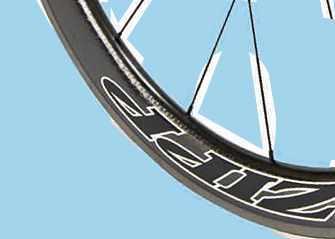

BACK IN 2011, carbon fibre deep-section aerodynamic wheels had become the go-to speed accessory for professional racers, triathletes and committed time triallers. Most of the early designs were based around a slim V-section rim that, although epically fast in a straight line in controlled conditions, proved something of a handful in the real world. I can still recall the abject fear of a mountainous descent in the Alps on a rather special set of European aero wheels when a sidewind pushed me from one side of the road to the other before I had any inkling to react.




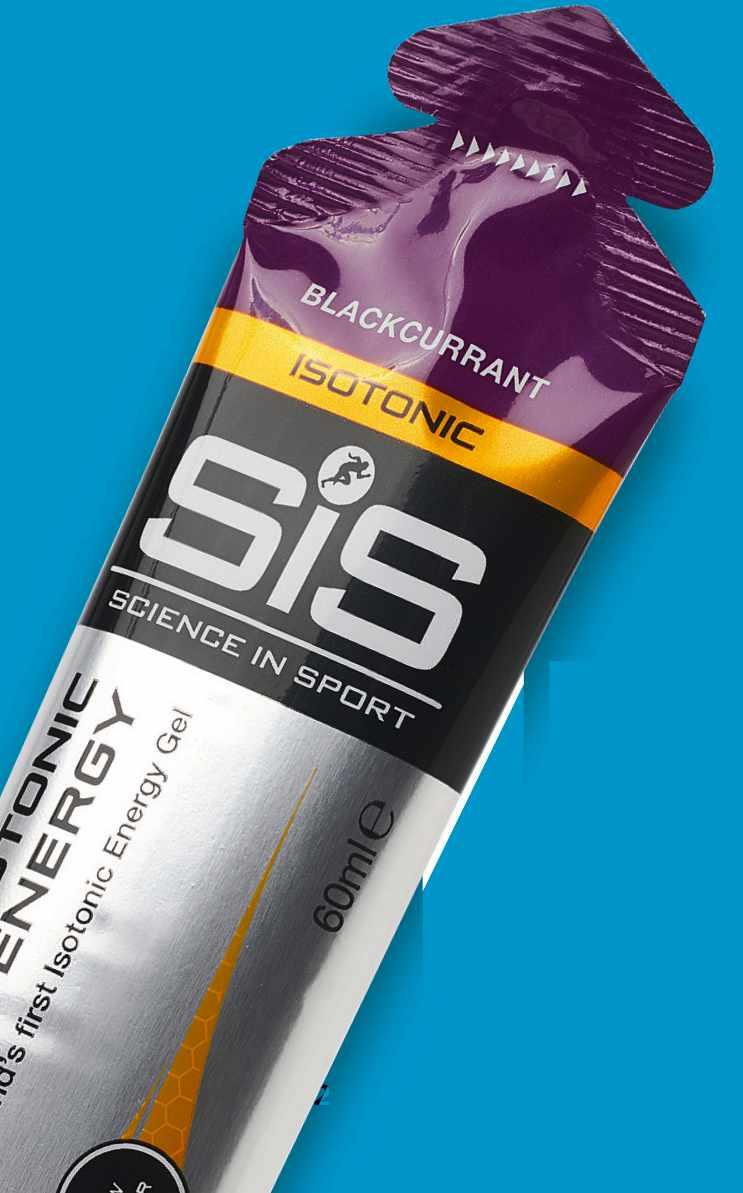
Before I trod the freelance-writing path, I edited 220 Triathlon. My time coincided with endurance athletes overhauling how they fuelled themselves. Where once bananas dominated, now scientific-fuelled sachets of energy promised stronger, faster efforts. Gels were easily portable and, unlike bars, could be consumed on the run without causing what we politely call ‘gastro distress’. The problem was they resembled Polyfilla.
That was until SiS came along and invented the world’s first isotonic gel. The premise was simple but effective: that by adding water to the gels, you could sidestep the inevitable water chaser, making them more palatable and practical. Yes, the science and application is more detailed than that, but here a gel’s potential was realised. James Witts, author
Then came Zipp’s groundbreaking Firecrest design. From moving away from a V-shape or Zipp’s toroidal shape (which was like a V shape with a fat belly) to the broad, blunt-edged shape of Firecrest, Zipp’s aerodynamicists had worked out how to balance a wheel in adverse winds. By making the inner edge of the rim mimic the leading edge of the tyre, they were able to balance the forces impacting on both. It was this balance that meant the wheels were so much more controllable when riding in stiff crosswinds.
The Firecrest shape has influenced rim design ever since and, even though Zipp has evolved the original 404 Firecrest shape, it still remains the gold standard for aerodynamic rim design.
 Warren Rossiter
Warren Rossiter


THE LAST DECADE has seen a whole raft of pee-friendly bib-short designs hit the market, as more women have demanded a better solution than having to strip naked in order to answer the call of nature. There’s been the good, the bad and the ugly – think flesh-pinching bum zips, stretchy elastic clips that ping up into your face, and other ‘solutions’ that make dropping shorts more testing than getting out of a straightjacket.
When I first tested a pair of American brand Velocio’s Luxe women’s bibs, I breathed a hefty sigh of relief. Its ‘FlyFree’ bib design, used across its women’s bib range, features two wide, elasticated bib straps that pass over the shoulders and cross at the back.
In order to use the toilet, all you have to do is pull down the bibs from the back, and the extremely stretchy bib straps do the work: no clasps, buckles or zips required.
The simplicity is the best part, and it’s now used on all of the brand’s women’s bib shorts and tights.
Katherine Moore, tech writer


“The two enemies of human happiness are pain and boredom.”
So said the German philosopher Arthur Schopenhauer. Seen through a cycling lens, the Schopester would’ve been half right. Pain’s embraced –or fetishised – by many cyclists. But historically, he’d have hit the nail on the turbo-training head.
Growing up, indoor cycling seared the synapses, hours of cycling against a garage wall to the deafening backdrop of a whirling flywheel upon a mildly unstable A-frame lump of metal providing a really rubbish end to the working day. Then indoor cycling experienced its own technological revolution and the rules of engagement changed completely.
Zwift may have dominated the evolutionary headlines but it’s the WattBike Atom smart bike that’s proven my most loyal and, yes, entertaining friend. Why? Firstly, it’s cut the faff. There’s no need for detaching your rear wheel or the like; instead, it’s just there, waiting to be ridden. But where the Wattbike comes into its own is ride realism. Just sync to the Wattbike app, choose a training session and you can interval train to your heart’s content.

It syncs effortlessly to the likes of Zwift, too, where you can import training sessions to crank up excitement in the world of Watopia. It’s not cheap but it’s achieved the unthinkable – making indoor cycling interesting. James Witts


and consistent, the 7800
When I started taking training and racing seriously around 2011, I knew I needed a power meter. Back then, most power meters were hideously expensive, especially if you wanted something from a reputable brand. After a short and rocky affair with a first-generation Stages power meter, I picked up a second-hand SRM Dura-Ace 7800 power meter for £850. It was money well spent.
First and foremost, it did the basics exceptionally well. It measured power accurately and consistently, and it had

rock-solid build quality. Its silver crank arms were also exceptionally pretty.
As with most power meters of its time, it had its quirks. Only official service centres could replace the battery, it required a frame magnet to measure cadence, and it didn’t play nicely with the auto-zero function on Garmins either. As a result, my SRM has been retired from active duty. However, it could easily be pressed back into service, and that’s impressive for a piece of tech released in 2008.
Simon von Bromley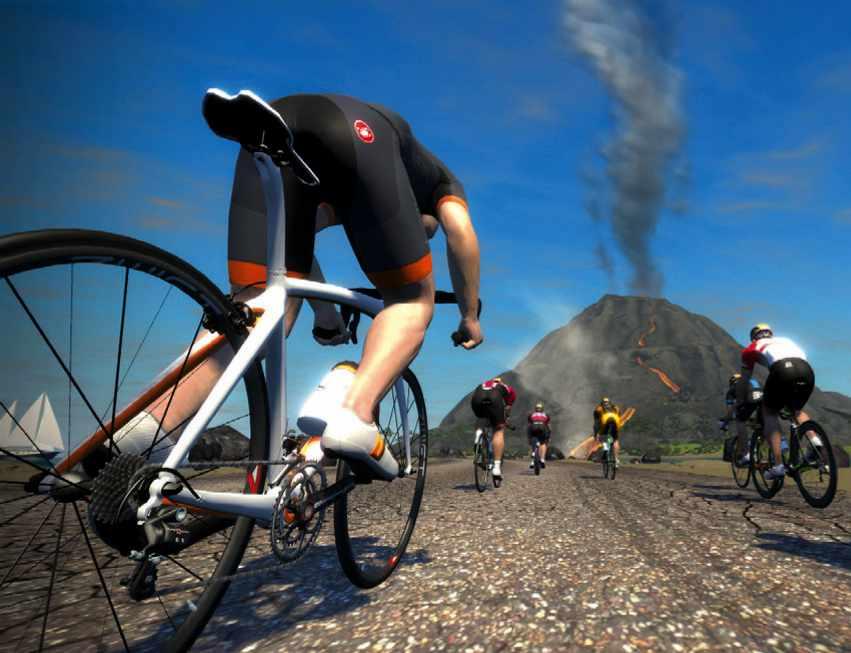


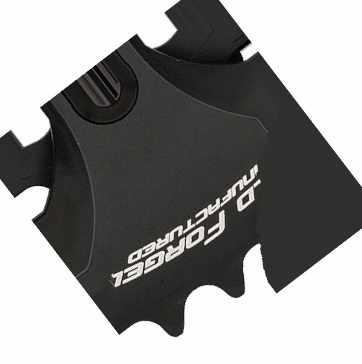



ORIGINALLY LAUNCHED AS a cyclocross-specific groupset, the impact of what’s now known as Force, Rival or Apex 1 on CX, all-road and gravel riding has been significant. Single chainrings with guides made from larger chainrings, were common in cyclocross for decades, but chains still regularly bounced off over rough ground. SRAM’s CX1 made single-ring riding truly functional and foolproof. Its rear derailleur’s clutch tensioned the chain, preventing chain slap, and the large, MTB-derived jockey wheels and extended cage allowed more grass and mud to clear. The advent of hydraulic disc brakes for drop bars elevated CX1’s holistic, go-anywhere system above the usual collections of unsuitable road components.
My original 2014 CX1 components are still going strong. The gears keep shifting even when the drivetrain is completely caked in muck, the brakes are relentlessly consistent, and I never have to worry that it’ll let me down. Because it never has.
Robin Wilmott, tech writerIt’s a cliché, but prior to Zwift, indoor cycling was a slog. Most indoor cycling apps simply focused on training – the idea you might have fun didn’t factor into the equation. When Zwift’s Watopia first opened to riders in 2014, though, everything changed. Fast forward a few years and the interactive indoor cycling landscape has completely shifted. Gamified features, an ever-expanding array of virtual worlds, as well as vast swathes of group rides and races, has massively improved the indoor cycling experience.
I’m far from the most avid Zwifter in existence (you won’t catch me doing any virtual Everesting), but I can’t imagine going back to simply doing intervals and staring at numbers. The virtual indoor cycling future is here, and I’m fully on board. Simon von Bromley



Larry David believes that a compromise is when neither party is happy. While we agree with the Curb your Enthusiasm star on plenty of things, obviously Larry isn’t familiar with the concept of aero road helmets, that winning compromise between traditional road helmets and pointy time-trial lids. The Giro Air Attack started the aero-road helmet revolution in 2012, and it was an instant elite hit on the elite race circuit, being sported by Rabobank, Garmin-Barracuda and more on the WorldTour, and ridden to victory by Leanda Cave at the Ironman Worlds.
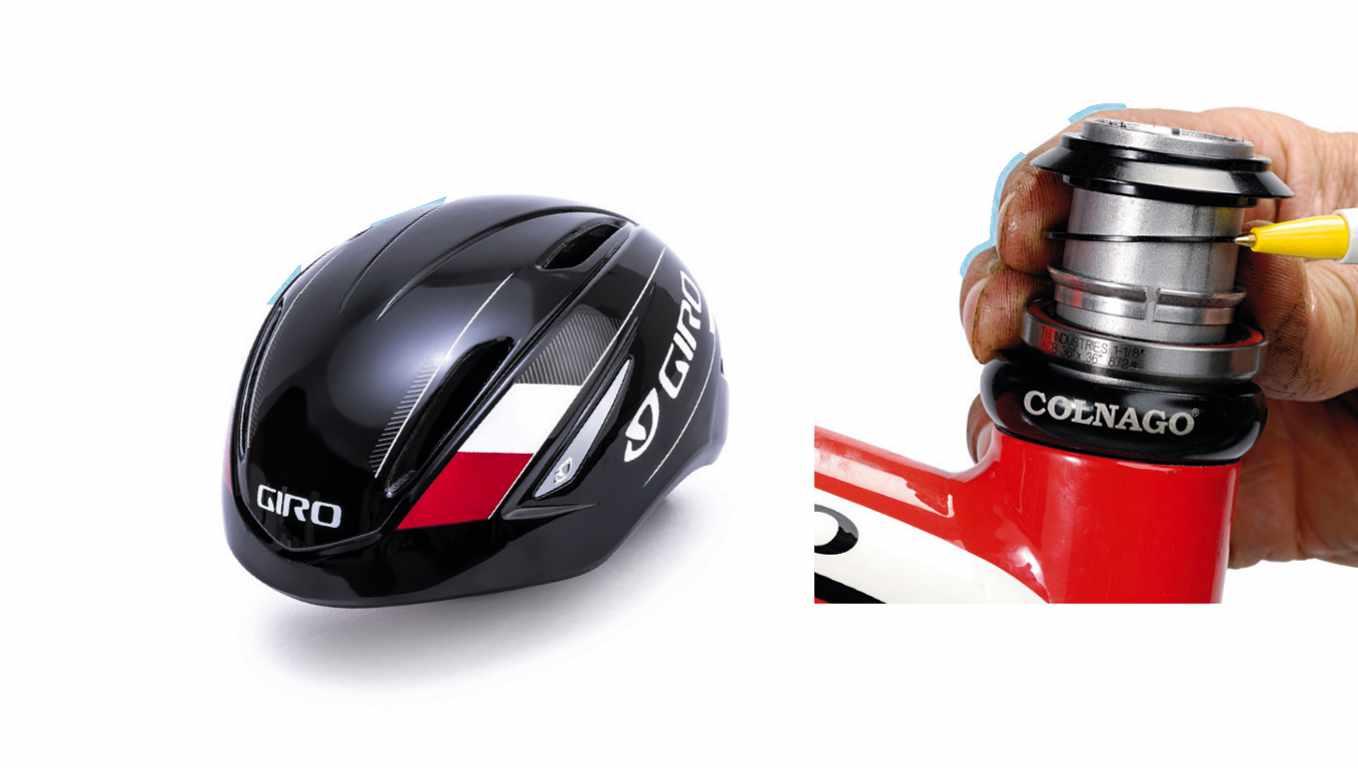
The result was a helmet for those of us prone to overheating in a TT helmet (or too self-conscious to wear one), one that married much of the aero gains of a TT lid with some of the cooling of a classic road helmet. It was also lighter and less claustrophobic than a TT lid. Cut to 2022 and the Air Attack’s influence can still be felt in the helmet world. Matt Baird, editor, Cycling Plus


ONE COMPONENT THAT I think is massively overlooked is the threadless headset/AheadSet, invented by John Rader and the Taiwanese company Dia Compe in the early 1990s. It allowed for an increased head-tube diameter, which improved front-end stiffness leading to better-handling bikes. With no need for a heavy, swan neck-shaped stem, expander wedge and threaded steerer on forks, bike designers had more freedom. Cue lower front ends and lighter forks and stems.

About a decade ago, I tested the original Giant TCR of pioneering bike designer Mike Burrows with its threaded headset against the then top-of-the-range TCR, and the new model’s front end was a revelatory leap forward in cockpit design and riding feel. The new TCR was just as racy but didn’t have to rely on an adjustable stem to lower the front end of the bike. This saved weight, removed complexity and it simply looked better too. Simon Withers

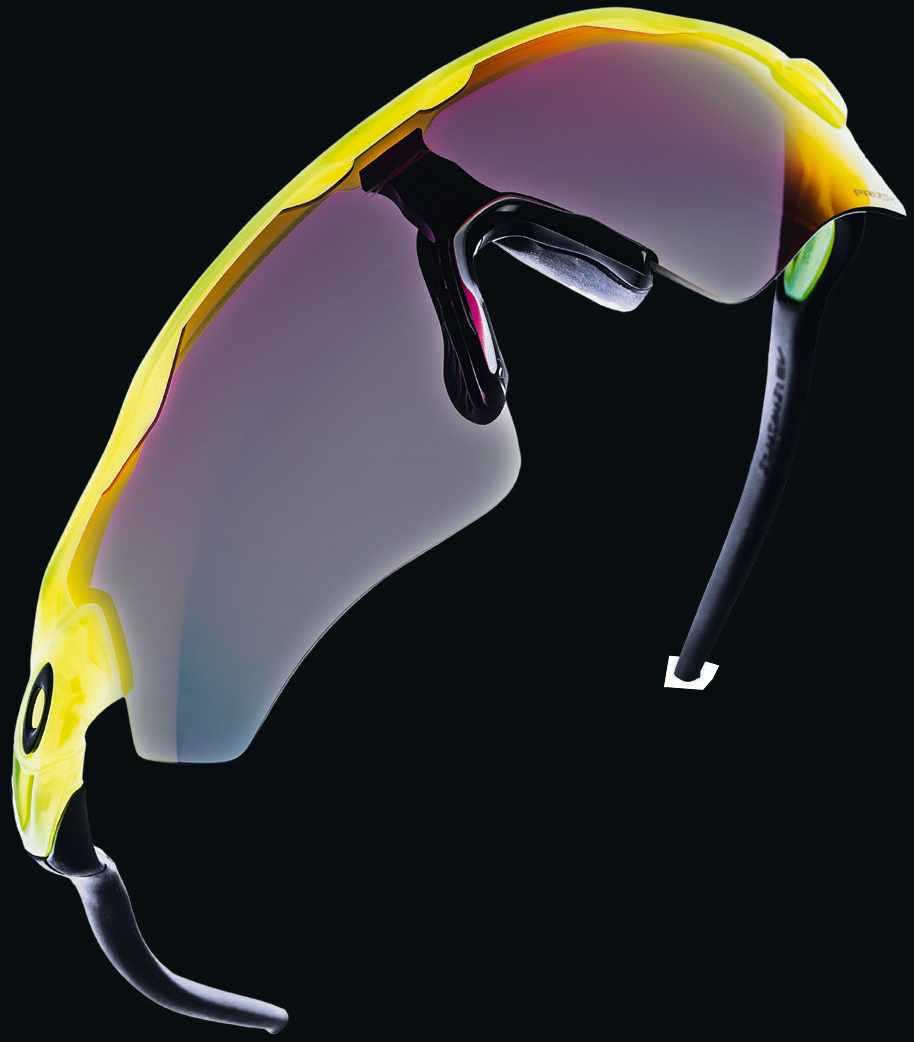
Believe

Back in the mid-1980s when I was riding BMX bikes, Oakley launched its first sunnies, the Factory Pilot Eyeshade. They were cool looking but far too big for my little head. The Oakley glasses trend continued during my mountain biking days in the 1990s and I liked the performance of the Razor Blade. They looked good and did the job well but weren’t perfect for me.
Several years later when I’d switched to riding road bikes and racing triathlon, Oakley hit the market with Radar with three sizes and shapes; Path, Pitch and Range. The Path model came with the smallest lens and fitted my face perfectly. It was a Goldilocks moment.
Everything about these riding shades was perfect in terms of fit, function, style and how they sat on my helmet. I loved how they looked and felt. There was ample eye coverage and being Oakley the protection was second to none. Whether it was from the sun’s harmful rays, flying debris or a crash situation, they performed superbly.
While the current trend is for bigger glasses, the Radar Path remains a perennial performer that bypasses fashion fads and looks good with any kit. It’s easily customised and lenses can be changed quickly to suit the conditions. It’s a design classic that remains the benchmark for all riding glasses.

the hype with the sunnies that combined fit, form and style

SRAM came to the road group game much later than both Shimano and Campagnolo. Yet its original double-tap gear system was a smart interpretation of what could be done, being ridden to Tour success with Alberto Contador in 2009.
It was another breath of fresh air when SRAM launched its original Red eTap in 2015. Whereas both Shimano and Campagnolo, with Di2 and EPS respectively, had brought in electronic shifting that mimicked their mechanical systems, SRAM instead took the view that electronics could free them from multi-buttons or levers. Hence the simple shift logic of eTap was born. Click the right shifter and gears get harder, hit the left button and it gets easier. Hold the buttons and it’ll keep shifting. Hit them both together and it shifts the front derailleur.

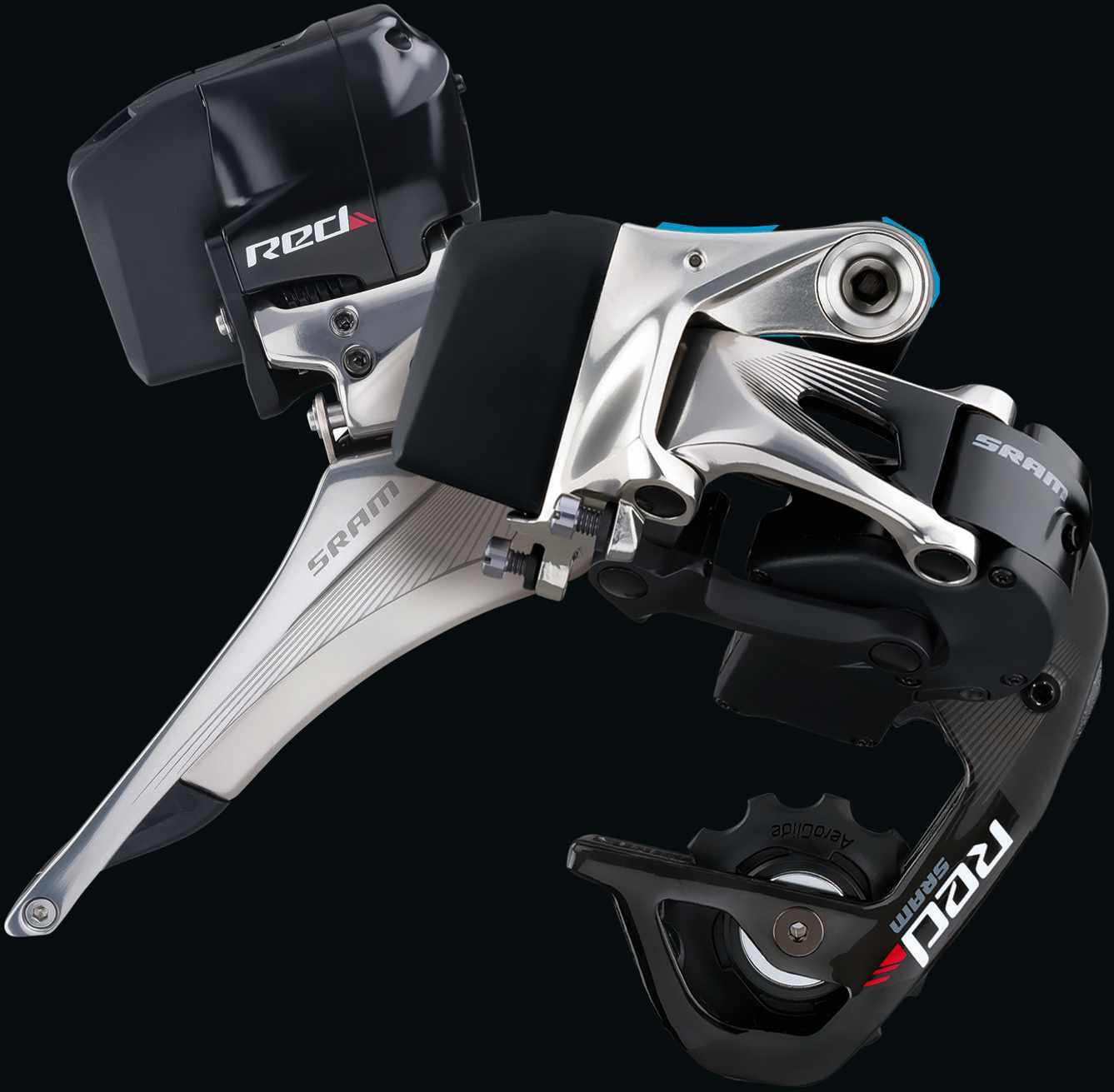
A further masterstroke was to embrace wireless technology to free up the groupset from vulnerable wires, complex connections and junction boxes
in favour of its own wireless protocol, which proved safe, reliable and secure (the eTap group was ridden in every major GrandTour in its first year without a hitch).

While both Shimano and Campagnolo also believed that bigger, heavier batteries for long life was the way to go, SRAM instead isolated the batteries to the derailleurs to make them compact, quick releasing and fast charging from pretty much any source. In a world used to charging phones and laptops daily it seemed like a smart choice.
Etap may have been superseded by the connectivity of AXS and 12-speed, but I still have the original Red eTap on my own bike and, with excess of 12,000 miles under its belt, I think eTap’s simple, clean and robust design deserves to be remembered as the proper game changer it is. Let’s not forget that without eTap, Shimano may not have felt the need to redesign its Di2 system to incorporate an element of wireless technology. And just when has Shimano ever been a follower? Warren Rossiter


WHEN I STARTED cycling, I wasn’t aware that saddles were even supposed to be comfortable or of the huge variety available. Purchasing a secondhand men’s Genesis bike, I initially accepted the default saddle it came with and the discomfort that followed.
A female coach enlightened me to the existence of women- specific saddles and leant me a Specialized Power. While it wasn’t a design specifically for women, it used the channel cut-out from Specialized’s women’s-specific saddles, and was available in different widths.

It’s designed to alleviate pressure around the perineal region, and allows blood flow to be maintained, avoiding regions of compression and potential subsequent bruising or numbness.
It’s been great for me – always feeling secure and comfortable as I took on my first road races, and seeing me through my dabbles with ultra-distance riding, including Paris-Brest-Paris in 2019. It barely looks the worse for wear four years down the line.
There are now a range of ‘Power’ saddles available (the unisex Power with Mirror is pictured), all using the same underlying concept. Sitbone measuring and saddle advice services are available in Specialized stores, allowing you to find the right width for you. Yes, saddle preference is personal and certainly no one size fits all, but this one was a game changer for me. I haven’t looked back since.
Alice Thomson, tech writer

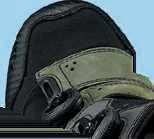

I’VE NEVER BEEN a big fan of overshoes in winter. All that wrestling with overtight neoprene, or the latest waterproof membrane, just to hasten the demise of your favourite road shoes in a moist, boil-in-the-bag microclimate. I first discovered winter boots when commuting two hours per day in London, and my Specialized Defrosters were a short-lived revelation.
When reviewing work dictated even more riding in all weathers, Lake’s CX145 winter road boots fulfilled every need, with tough waxed canvas and water-resistant leather uppers, secured by dual BOA IP1 dials. The overlapping uppers are simple to put on and they fit closely around the ankle, refusing to let cool air and spray in. And the CX145 were so well built that I’m still using my seven-year-old pair regularly.
 Robin Willmott
Robin Willmott

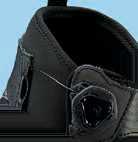






WE’RE SPOILT FOR choice when it comes to choosing a set of bikepacking bags these days. But it hasn’t always been that way. Giving tourers and bikepackers the world over a whole new realm of choice when it comes to storing kit on the bike, it was no great surprise that waterproof pannier market leader Ortlieb was one of the early pioneers of rack-free luggage. Forget the seemingly dark magic of rack compatibility and panniers flying loose over rocky tracks. These bikepacking bags landed on the scene to help riders pack gear with much more versatility across different bike types and shapes than ever before. Early designs included the handlebar roll, a seatpost pack and a frame bag, with many more designs emerging, including fork-mounted cargo bags. Katherine
 Moore
Moore
4

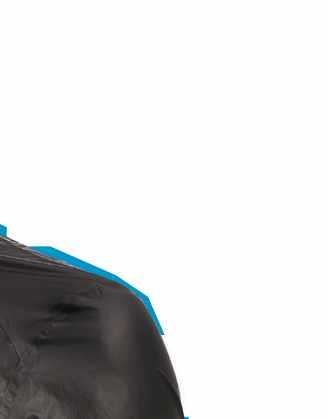

I love riding outdoors year round, and avoided succumbing to owning an indoor trainer from when I started cycling in 2017 until the first lockdown. The Gore Shakedry rain jacket was a big contributor to my comfort in doing that. Packing down to genuinely pocket-sized dimensions, there’s always room for it on those ‘just in case’ days.
Now more widespread, the ‘Shakedry’ tech means the Gore-Tex layer is on the outside of the jacket (they’ve got rid of the outer fabric to reduce size and weight) and, thanks to its water-beading properties, the rain on the surface of the jacket can be shaken off – hence the name. And thanks to using fewer layers, the Shakedry also has enhanced breathability, the air-permeable membrane able to let moisture escape more easily.



It’s also impressively weather- and windproof. I once underestimated the chill on an Atlas Mountains’ ride and ended up descending for over an hour in wintery and wet conditions with only summer kit and the Gore Shakedry. It probably saved me from serious distress. It comes everywhere, and I’ll even carry it in the summer as it weighs next to nothing. And mine has stood the test of time, going strong for four years with no reduction in waterproof properties. Alice Thomson
JANUARY
Our review team’s best bike buys of the past few months…
01
Reilly Fusion
● Winning tech, craftmanship, ride manners and looks: Reilly’s titaniumframed Fusion has it all in abundance.
Ribble Gravel AL SRAM Rival 1x £1,999 Issue 396

● This Ribble offers a more-than-capable ride that can handle the rough stuff, and with cracking spec for the price to boot.
Sonder Colibri AL £1,249 Issue 399
02
● A great, sporty, year-round titanium endurance bike that majors in value and definitely doesn’t disappoint in its ride.
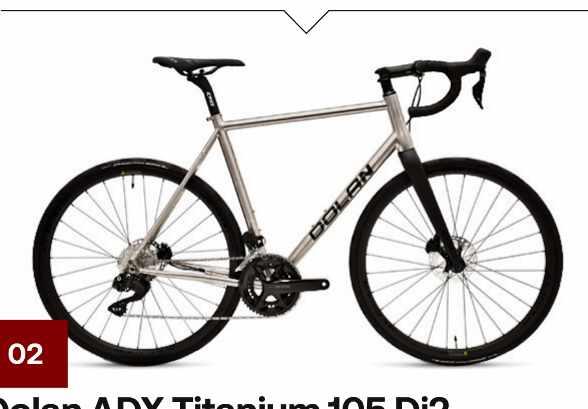




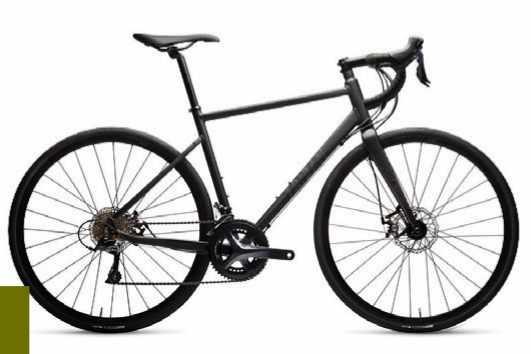
02
Boardman ADV8.9 £1,150 Issue 393
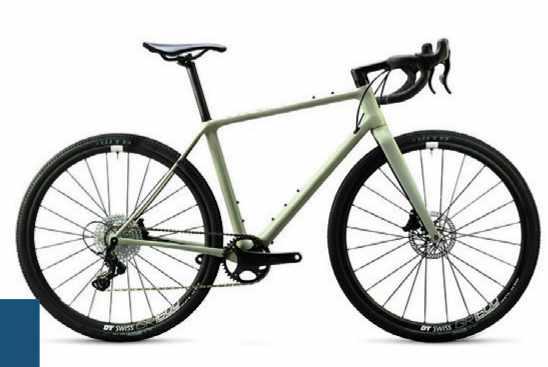
● An aluminium bike with carbon fork, this boasts an excellent spec, including Shimano’s GRX 400 10-speed gravel kit.

Triban RC500 £649.99 Issue 393

Four fantastic flyers for road riding and racing This capable quartet will help you head off the tarmac A great-value trio that punch above their lower price tags 03 03
Canyon Aeroad CF SLX 7 Disc eTap


£4,949 Issue 397
Vielo V+1 Strato SRAM Rival £5,299 Issue 393
● A great choice for racing, this Vielo manages to blend racy geometry and great handling with plenty of compliance.
● Decathlon’s great-value own-brand bike is versatile enough to work on gravel or even do a spot of touring or bikepacking.
04
● A very special frameset with a superb level of kit and fantastic wireless gearing. The latest Defy is very, very hard to fault.
Cube Nuroad C:62 Pro £2,499 Issue 393
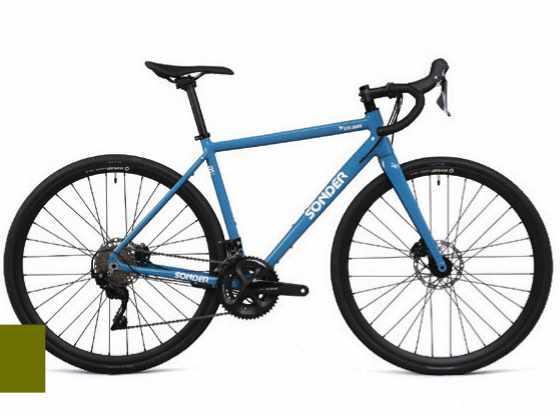
● Influenced by gravel tourers, the speedy Nuroad would work well for commuting as well as for less-technical gravel.
Giant Contend 1 £949 Issue 393
● Kit includes a Shimano Sora groupset, vibration-damping seatpost and carbon fork plus tubeless-ready wheels and tyres.

Perfect for cylcing lovers, the Leatherman Skeletool weighs in at a mere five ounces and has seven irreplaceable tools in one compact parcel. With a combo blade, pliers, bit driver and wire cutters - this is a great tool for those quick last minute bike repairs.

Perfect cycling the Skeletool weighs in at a mere five ounces and has seven irreplaceable tools in one compact parcel. With combo blade, pliers, bit driver and wire cutters - this is a great tool for those quick last minute bike repairs.
Available online from: www.leatherman.co.uk

Enter 2023 with fantastic bike fitness thanks to the exclusive chance to join the world’s best riders on Zwift’s Pro Training Camp

“You’ll be able to complete workouts by Grand Tour leaders, national and Olympic champions, and both current and ex-World Champions”

FROM INEOS GRENADIERS’ famous blocks of training in Tenerife to Team Jumbo Visma tearing it up in Alicante, winter training camps have a rich history in the world of elite cycling. They’re where teammates come together, form strong bonds over epic efforts, and lay the groundwork to become champions when the racing begins. Training camps have long been athletic dens of secrecy closed to all except official team members… until now. Enter Zwift’s Pro Training Camp, the community training camp brought to you by the world’s best athletes and teams that will see you hitting the new year with a brilliant fitness base ready to hit your 2023 targets.
Join Pro Training Camp’s four winter riding camps, hosted by four top-tier teams of INEOS Grenadiers, Team Jumbo Visma, Movistar and Team BikeExchange
Jayco’s men’s and women’s squads and experience engaging, fun, tough yet achievable workouts, based on and informed by some of the world’s best riders.
You’ll do workouts by Grand Tour leaders and points jersey winners, national champions, Olympic champions, and both current and ex-World Champions. Pro Training Camp isn’t training for pros though, it’s training like a pro.
As with any other FTP-based workout on Zwift, the difficulty is scaled to your ability, so you won’t have to hold onto the wheel of the likes of Jumbo Visma’s Tour de France champ Jonas Vingegaard or Team BikeExchange Jayco’s star Kristen Faulkner.
In addition to Pro Training Camp, for both Zwift newcomers and existing riders there are a host of
Above Experience training like the big names this winter with Zwift’s new Pro Training Camp
in-game updates arriving this winter, including one within the expanded Pace Partners function that gives Zwifters the ability to join an always-on group ride for a social workout at a variety of paces.
There’s also the all-new HoloReplay feature that allows Zwifters the chance to compete against a ghost of their previous PBs, giving a personalised competitive element to their riding to help you gain a better understanding of correct pacing for any given segment in the game.
You can also expect to see new functions in the Route Based Workouts, which provide an alternative to FTP-based training and offer a more accessible pathway into structured training on the platform. The Route Based Workouts use Zwift’s terrain and marked segments to create a structured workout plan, allowing for a mix of different efforts.
Also new this season is ZRacing, a thematic monthly race series that will deliver always-on, easy-toaccess competition. A new stage will run each week, and those taking part will be able to earn a monthly badge. ZRacing is designed to fit with a rider’s schedule, allowing Zwifters to warm up, race and then cool down in under one hour. Also look out for Timetrial updates and a new map of the Urukazi world.
Pro Training Camp is live now and will continue until 15 January 2023. Head to zwift.com for more info on this and the wealth of new Zwift updates. And turn overleaf for the ultimate training tool for your Pro Training Camp experience.
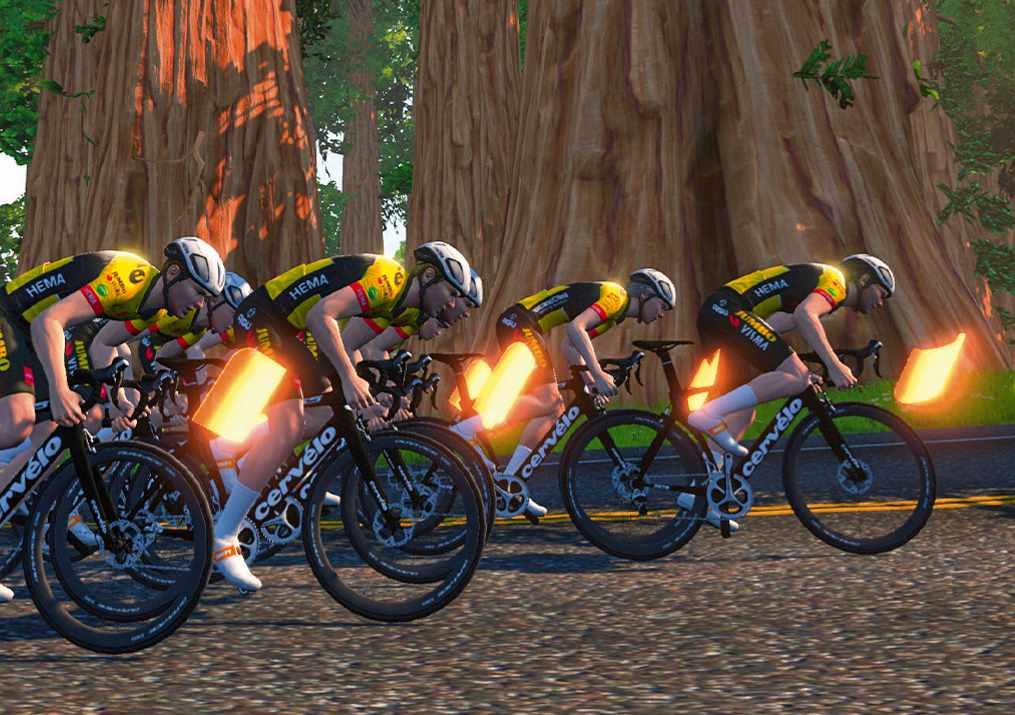
3 RIDE TO YOUR OWN SCHEDULE
You’ve trained like a pro, now race like a pro in December’s ZRacing series. With races hourly every day, you can try a different course each week on a route selected by big-name pro teams.
WANT TO GIVE ZWIFT A GO but don’t know where to start? The global online fitness platform’s immersive cycling playground has just become more affordable and easier to access with the launch of the new Zwift Hub, which costs £449 and includes a pre-installed cassette.

Zwift Hub is set to unlock the fully immersive experience of riding on Zwift, simulating Zwift’s virtual terrain with uncanny realism, bringing the outdoor cycling experience indoors.
Whether performing structured workouts in ERG mode, training with power for the first time, or riding the steepest gradients on Alpe du Zwift, Zwift Hub’s wheeloff design ensures that cyclists enjoy smooth and instantaneous resistance changes to match what
Zwift
they see on the screen, allowing them to focus on the ride.
Unique for the market, Zwift Hub will ship with a cassette preinstalled (8, 9, 10, 11 or 12-speed Shimano/SRAM) at no extra cost. You’ll be able to specify the number of gears you require at checkout, meaning Zwift Hub will ship with everything needed to take that first ride in Watopia in minutes.

With its rock-solid design, Zwift Hub delivers a smooth and realistic ride experience and one that won’t upset the neighbours. Even at high speeds, it’s whisper quiet. For those using AppleTV, meanwhile, Zwift Hub is able to act as a Bluetooth bridge for your heart rate monitor, freeing up a Bluetooth connection so you an pair another accessory with Zwift.
“Zwift Hub is going to disrupt the market, and we think that’s great news for the customer,” says Eric Min, Zwift’s CEO and co-founder.
“Zwift Hub will help us deliver our mission to make more people, more active, more often by making it both easier and more affordable to get set up on Zwift.”
“Zwift Hub is set to unlock the fully immersive experience of riding on Zwift, simulating Zwift’s virtual terrain with uncanny realism”
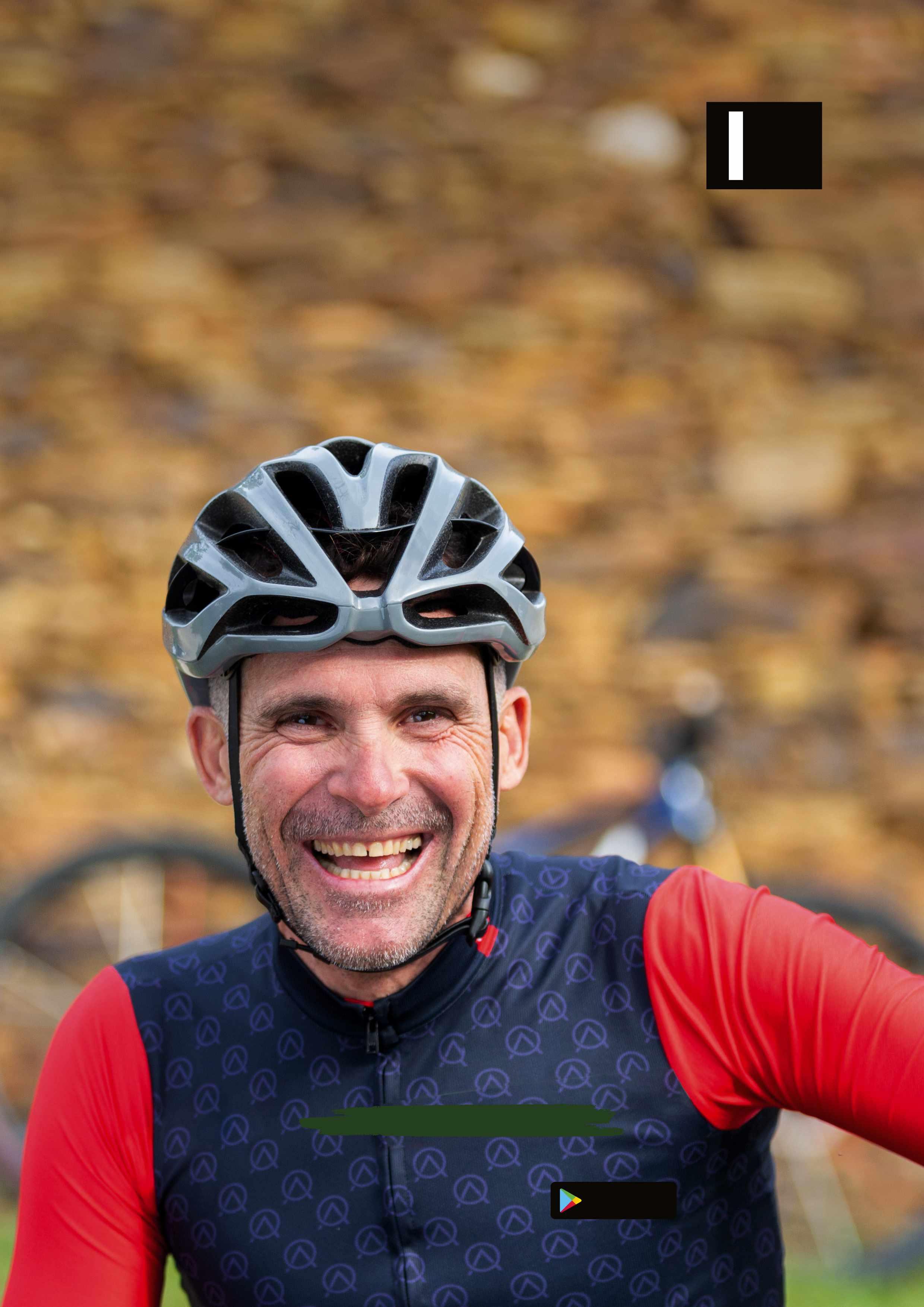


Like many riders, I suspect, a coast to coast, or C2C, across the north of England, is one of those rides that I’ve always wanted to do and just never got around to. Too much faff perhaps, starting and finishing in two places miles apart. Moving to Sheffield, slap bang in the centre of England, from London, several years ago got me thinking more about it, particularly as something that might be doable in a single day. At the right time of year, with a prevailing wind, the right ride partner and no clangers from our rail network, and you know what? It just might be.
The plan I concocted was to travel by train from Sheffield to Morecambe at the crack of dawn, ride east to Scarborough then get the train home. It wouldn’t be a classic C2C route, but one tailored to my particular need of cramming much into a short time. With 204km and 2,150m elevation ahead of me, it was clearly a two-person job. Flicking through my Rolodex of ride buddies I picked out young Chris Moores: strong, fast and both 10 years younger and kilograms lighter than me. That’s not much to shelter behind, but a solid wheel to follow on climbs.
Time would be tight, even with this wingman. Chris had to be back in London by the end of the day, which meant we had no make the 17:35 train out of Scarborough. Leaving Morecambe at a prompt 9am would give us 8.5 hours to play with: that’s 24km/h

over hilly terrain, pit stops and a photographer, Henry, to keep happy. This was a tight schedule, and the route was a happy medium between a fast A-road fist fight and a scenic traipse around the houses of the Yorkshire Dales and North York Moors.
From Sheffield we took the 6.09am train to Manchester, with a second change in Preston, before arriving in Lancaster at 8.45am. There was no point waiting for a third change to Morecambe, with it being only a few miles down the road, so we jumped onto the excellent bike path and met our photographer Henry at the fabulous Art Deco café, Brucciani’s, on Morecambe promenade. A family business since 1893, it’s currently run by Paulo, the third generation of the family. He’s also a cyclist, so we got to talking about all sorts, for far too long in fact, on a day the clock was ticking and every minute counted.
Before we literally talked our way out of this mission, we jumped back onto the bike path then onto the only busy road of the day, the A683 to High Bentham. This was going to be a long day, so no matches were to be burnt early doors: we simply had to sit on a nice tempo. Which meant that when a van driver slowly moved past us on our inside and Chris jumped into its slipstream and disappeared up the
road, I wasn’t best pleased. Not having the jump in my tank, nor wanting to sit at 400 watts on a rear bumper, I declined to join him. I told him off when I finally caught up with him. He sulked at that: he doesn’t know the meaning of slow.
Eventually we turned off the main road, which had seemed easy now that we were in lanes and the countryside was morphing into the rugged Dales before our eyes. From here all the way to Ripon was up and down, exposed to the elements in places as we crossed the spine of the country. We gained altitude economically, largely avoiding any savagery. We hit nothing of note until we’d made our passage through Stainforth, where, with a right turn through the village we hit nominative determinism’s Goat Lane. The ascent was brisk yet comfortable – the real issue was keeping Chris in check – and once at the top we swung a right onto what would be the only truly arduous climb of the day, a twisting 25% taking us towards Malham Tarn. We were unable to enter it with any momentum, as the lower slopes were occupied by black sheep, with the quad bike-straddling farmer struggling to maintain control of his flock.
I wasn’t starting this ride in tip-top shape. Just a couple of days previously I’d returned from a gruelling four-day smash-and-grab trip to the Swiss Alps that included a nine-hour 212km ride, mostly ridden in the

rain over four giant passes. I’m 49 now and my powers of recovery aren’t quite what they were. I was carrying a significant amount of fatigue in my legs – it was on climbs like the one to Malham Tarn where I was hoping my reserves would hold until Scarborough.
After this brutal little interlude, we rolled on across the open moors. Chris had never ridden in the Dales before and was, of course, blown away by their beauty. And by how quiet it was, with vehicles a seldomseen aberration on a pristine landscape. Following the wonderful zig-zags of Nab End, we plummeted down into Arncliffe and for the next 15km there was a hiatus in climbing; in its place fizzing 40km/h averages through Grassington until the testing climb to Greenhow.
One thing we weren’t getting any help from today was the wind. The reason most people ride a C2C in this direction, from west to east, is for the benefit
Left Bright-eyed and bushy-tailed, Simon and Chris set forth from Morecambe’s promenade
Above For the distance, there isn’t a huge amount of ascent overall, but the climbs still hurt
We were unable to enter the arduous 25% climb with any momentum, as the lower slopes were occupied by a flock of black sheep
Above Chris fulfils his domestique duties with good grace and apparent ease, while Simon struggles to keep up
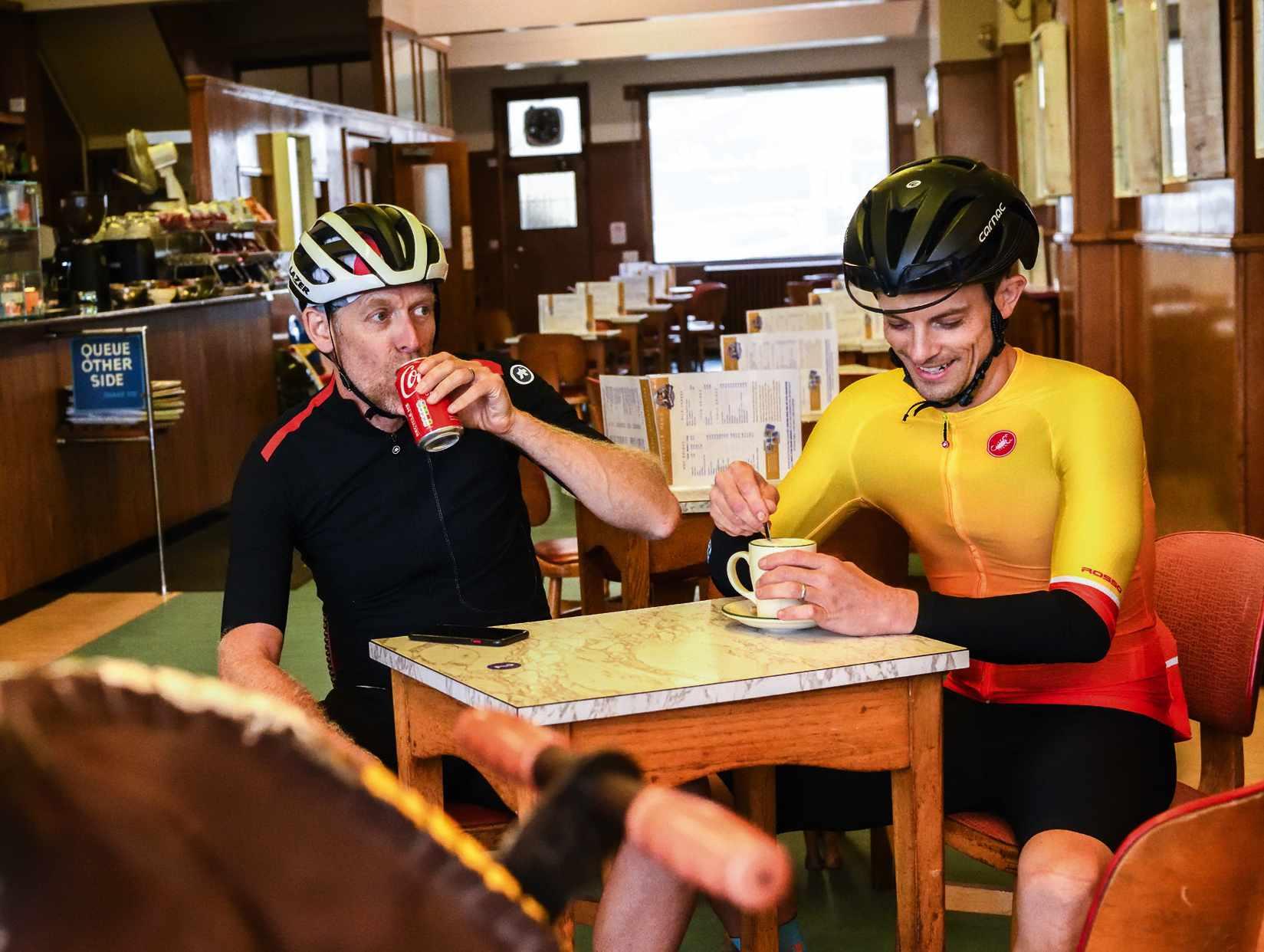
Right Having not found a lunch stop, they finally find a cafe, but sadly the scone and Coke will prove too little too late for Simon

Above Unluckily for the duo, the tailwind they’d hoped for didn’t materialise, but at least the roads were quiet

Left The route was very scenic with many a tempting stop, but there was no time for that on this C2C mission

of a tailwind. The joy of a whole day with a tailwind is what all riders dream of, sailing along with the invisible hand on the small of your back, coaxing you up hills and powering you on the flat. Today, however, we had the misfortune of a crosswind that impacted us more the further we travelled. Rain was also forecast, arriving on cue as we rose up towards Greenhow. We strapped on our jackets and slogged up the near 10km of climbing, punctuated by a number of short descents, until we reached the top of the mighty and exposed Greenhow Hill.
The plan was to stop in Pateley Bridge to refill our bottles but as we were soaked I made the call to press on to Ripon. This meant we got all the serious climbing out the way and, by the look of the blue sky ahead, we’d also have the chance to dry out a bit. We were almost out of water, but thankfully photographer Henry had come prepared and was doubling as a team car with a coolbox full of water, squash and bananas. There was some faffing involving photos on the way out of Pateley Bridge and then, for the first time, I looked at the clock, doing some mental maths regarding making it to Scarborough on time.

The answer wasn’t good. We’d need to ride 30km/h, including breaks, from here on out to make the train. This was music to Chris’s ears – it was time to ride full
gas. Though as I’ve already made clear, his full gas was rather more powerful than mine.
In Ripon we were expecting to find a garage or shop for lunch, but found nothing. We pressed on, hoping to come across a village with provisions. Norton-leClay? No. Cundall? Ditto. Brafferton? Nothing. We’d have to make do with another of Henry’s bananas. It wasn’t until we reached Hovingham, 25km up the road, that we passed anything that would sell us some sustenance, a wonderful little cafe where we grabbed a huge scone and Coke. It wasn’t to help me much because by this point I was done for, still another 60km from the finish with only two hours remaining on the clock. The route needed to be changed.
My original plan to head north and ride through Dalby Forest had to be scrapped – our new mission was simply to reach the seafront in time for a bag of chips before our train home. The only problem with this was having to ditch our GPS and use our noses to get us to Scarborough. We pressed on to Malton, following road signs to the A64 and Scarborough. For a brief moment we considered jumping onto the A64 and press on at turbo speed, but glancing at its four lanes of traffic this was hardly a desirable option. Getting there alive was more important than getting there on time. I was now a passenger, clinging onto a surging Chris’s rear wheel, with the carrot of the train the only thing keeping me upright.
Taking the A169 up towards Pickering, we then turned right to cut through to the A170 on a glorious road via Yedingham to Snainton. Hitting the main road we had just 15km to go and still 40 minutes on the clock. That’s plenty in my book. I imagined it being all downhill from there to the coast, but I was wrong. There was one last hill, which pretty much finished me off. I teetered over the summit, emptier than an empty thing from Planet Empty. Now it really was all downhill.
Once in town we had 15 minutes to find Henry, a chip shop and, of course, take that all-important photograph of us at the coast. Along the seafront, past the big wheel, the amusements and people surfing the waves, we rolled along and there Henry was. We got the shot, but there’d be no time for chips as Henry –going above and beyond to the last – gave me a lift back up the road to the train station, with just five minutes left on the clock. We jumped onto the train, stashed our bikes and slumped deep into the seats. Thankfully the carriage was deserted, as this would not have been the first time Chris and I would have emptied a train due to the overpowering stench of hard-earned sweat. We’d done it. Coast to coast, from home and back, in a single day. A big, page-spanning tick on my bucket list.
Above Lucky Simon has his bike to hold him up, as he’s in a sorry state by the time the pair reach Scarborough

● Both Morecambe and Scarborough have train stations.
01 Where to stay
● This was a day trip so no hotels were needed for Simon and Chris, but with two seaside towns sandwiching the route, you won’t be short of options.
02 Where to eat
● We started from Brucciani’s cafe in Morecambe, which we can’t recommend highly enough for friendly service, cycling knowledge, the Art Deco interior and homemade ice cream. On route we stopped at The Park Cafe in Hovingham,
which has a large selection of cake.
03 Tourist Information ● exploremore cambebay.org.uk / visitscarborough. com
Find, plan and share adventures with komoot Komoot is an app that lets you find, plan, and share adventures with the easy route planner. Driven by a desire to explore, and powered by the outdoor community’s recommendations it’s komoot’s mission to inspire great adventures, making them accessible to everyone.
Distance 204km/127 miles
Elevation 2,156m/7,075ft
Download the route komoot.com/tour/950508280







Fancy a scientist extracting a segment of your muscle fibre within a day of hardcore intervals?
Doubtful. Fancy that same scientist extracting four segments of muscle fibres during a day of hardcore intervals? Sod off. That’s what a brave set of Danish cyclists let a team of Danish researchers do to their thighs, all in the name of finding out more about the role of muscle glycogen in high-intensity exercise. From our point of view, their suffering was worth it as it’s given us a deeper insight into why your power output drops after two hours of chasing your mate’s chamois or from battering yourself round Watopia.
Eighteen cyclists performed high-intensity, intermittent, glycogen-depleting intervals. They were then randomly assigned to the high-carbohydrate diet group, who’d scoff bars and consume drinks, or the low-carbohydrate placebo group. After 5hrs, the scientists assessed their repeat sprint ability by having them undertake 5 x 6sec maximal sprints with 24secs rest in between.
Throughout the day’s tests, muscle biopsies were taken, as well as blood samples.
So, what did the vampires find? On a fundamental level, it was as you’d expect. The first set of intervals reduced both groups’ muscle-glycogen stores, while the high-carbohydrate group then enjoyed greater glycogen replenishment. That showed in the final 5 x 6sec maximal sprints as they performed better than the
placebo group and they found it easier (their rate of perceived exertion scores were lower). Nothing new there. But when the scientists dug deeper, they showed that in the low-carb group, 19% of individual slow-twitch fibres and 4% of fast-twitch fibres were depleted to less than 20% of their original levels. No individual fibres in the high-carb group were that depleted, inferring that even if the majority of your muscle fibres are loaded with glycogen, those that aren’t will compromise performance.
At an even deeper level, they discovered that how glycogen is stored matters, too. In a muscle fibre, it’s stored in three places: subsarcolemmal, intermyofibrillar and intramyofibrillar. The latter’s associated with contraction and, true to form, in the low-carb group, over half the subjects’ intramyofibrillar was depleted to less than 20%. The conclusion? It’s not just muscle-fibre quantity that matters, but where it’s stored in the muscle.
Takeaway There’s still much to learn about glycogen and muscles at a cellular level. But, in general, carbohydrate feeding before, during and after cycling will help you ride better
Don’t forget to pack those snacks in your back pocket
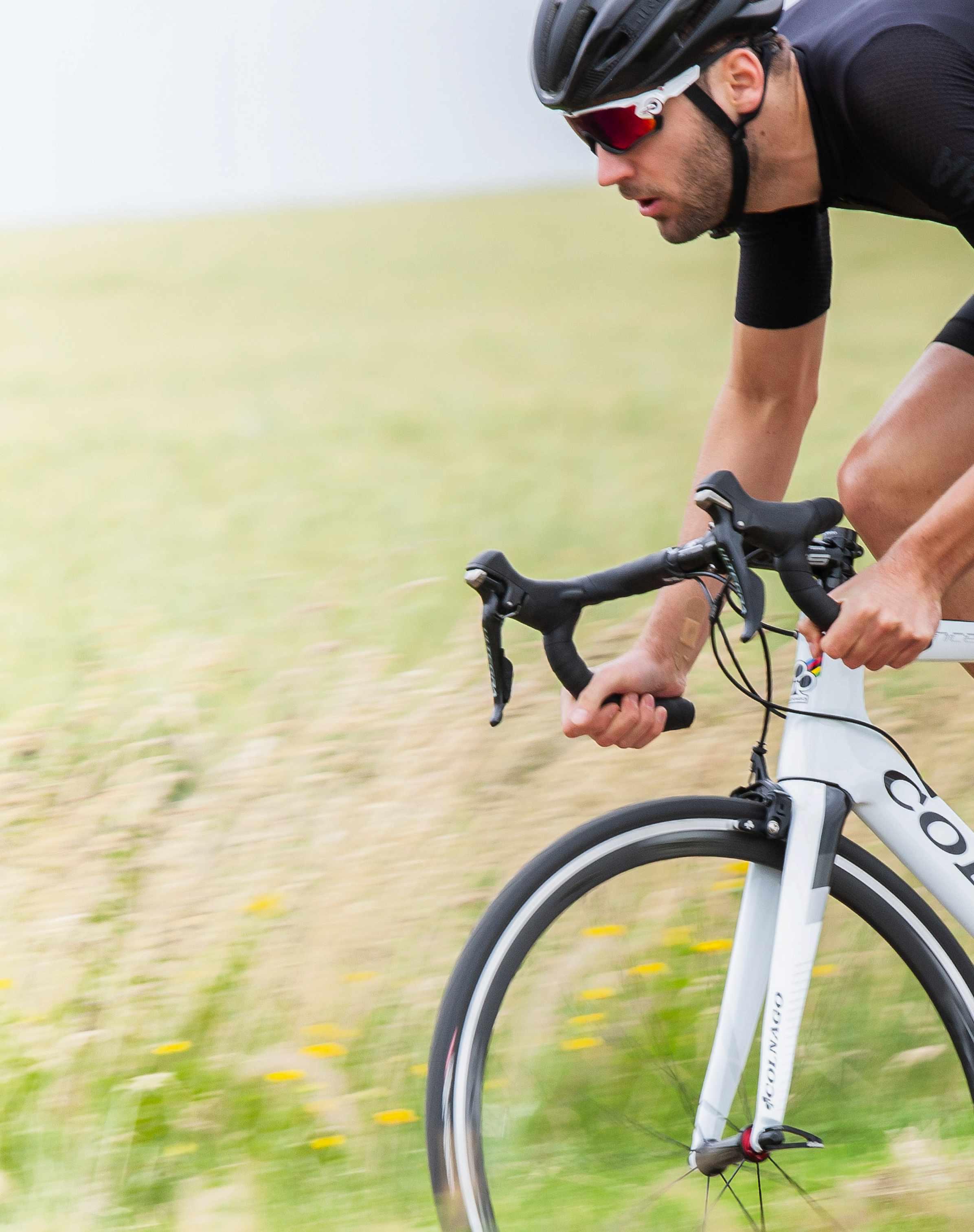
A team from Birmingham University has shown that riders rode stronger in a 4km time trial after consuming sodium bicarbonate in the heat (30°C) via the same mechanism as they used in more temperate conditions. That mechanism is ‘buffering’; in other words, when ingested, the alkaline nature of sodium bicarbonate (baking soda) raises the pH of blood. As highintensity riding generates lactic acid, which ultimately lowers the pH of blood making it more acidic, the idea is that baking soda gives you longer to work hard before your acidic blood slows you down. The researchers noted the ergogenic effect came at just 0.2g/ kg bodyweight compared to the traditional 0.3g, meaning common gastro issues might be avoided. Baking soda also retains water, so may help in longer hot rides. Takeaway

Baking soda could have benefits in all conditions. But too much can cause stomach upsets for some
HRV (heart rate variability) training is flirted with the masses for the past few years, especially as smartphones and wrist-based training tools have become more sophisticated. The idea is that
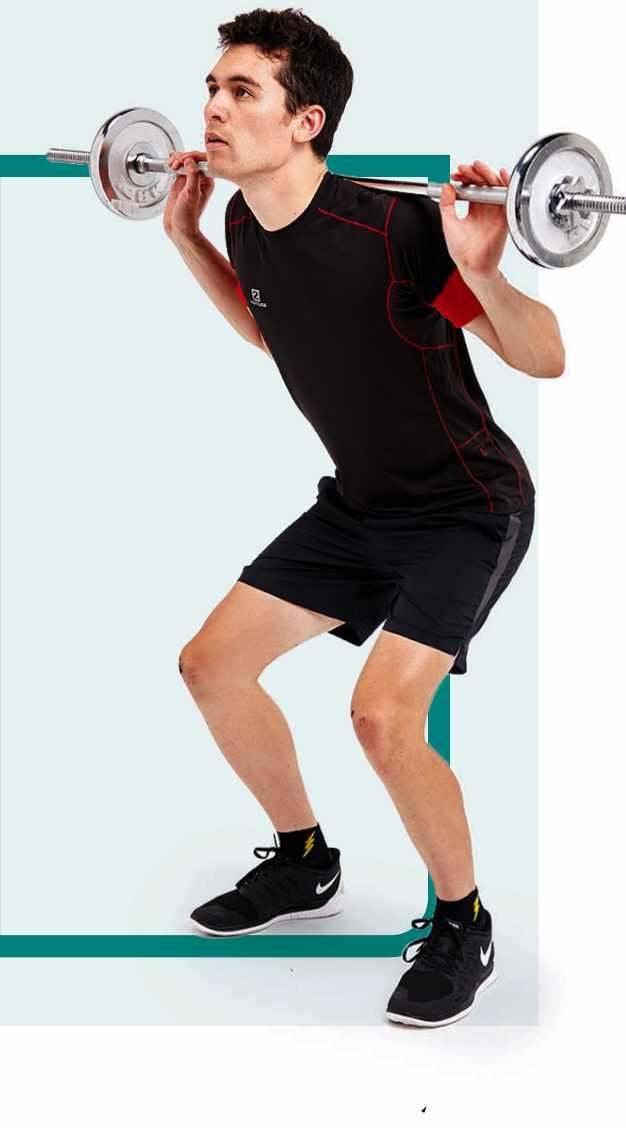
HRV measures your ‘state of readiness’, mainly by assessing your autonomic nervous system. If your nervous system’s stressed, you should tone down that day’s training. If it’s not, go for it. Research is equivocal on its benefits, but a recent study from Finland is in the ‘for’ camp after researchers found that endurance runners whose training load was managed twice weekly by their nocturnal HRV score and recovery status outperformed those who followed an off-the-peg programme. In our experience, HRVTraining is one of the most reputable apps. It’s available on iOS and Android.
HRV training learns with you, so the more you use it, the more impact it will have. A reading as soon as you awake is preferable
04 Focus and distract
In pain? It’s time to focus… A German team had 58 athletes run 9 x 3min outdoors around a large pond. While running at three intensities, they were instructed to focus on their breathing, on the environment or did not receive an instruction. In light activity, ‘nonfocusing attention’ was deemed most effective, but when it came to hard efforts, a self-audit, like focusing on breathing, proved most beneficial. Paying attention to your environment also seemed to help.
Takeaway

This and other mind-trickery techniques, like self-talk and visualisation, are easy wins
Weight training is used by all levels of cyclist, with the aim of reducing injury and increasing power. But there’s a school of thought that says strength training could inhibit performance because the weight movements just aren’t specific enough. For instance, squats and leg presses are quite different to pedalling technique. Well, a recent UK study dispels this notion. After a 12-week gym plan – two
sessions a week – that complemented their cycling, the participants’ crank power increased significantly, showing both the nervous system and muscles had adapted.
Takeaway Strength training is another easy win this winter
“IFWords James Witts Photography Robert Smith
Fibre is a type of complex carbohydrate that’s mainly found in plant-based foods (fruit, veg, wholegrains and legumes). Make sure you eat the recommended 30g per day to keep your digestive system happy and help you feel fuller for longer. Fibre can also help keep your weight stable and lower risk of diseases such as bowel cancer, heart disease and diabetes.
A winter warmer soup that’s packed with fibre, plus slow-releasing carbs, protein and vitamins and minerals. Prepare in advance and use it during the week ahead. Eat it with a hunk of bread if you wish.
Details
• Prep 10mins
• Cook 40mins
• Serves 4
Ingredients
• 3 tbsp olive oil
• 4 boneless, skinless chicken thighs, diced
• 1 red onion, peeled, sliced finely
• 3 cloves garlic, peeled, crushed
• 2 sticks celery, chopped
• 3 carrots, chopped
• 2 tsp each cumin seeds, ground cumin and ground coriander
• 1 tsp each ground cinnamon, ground turmeric and smoked paprika
• 2 tbsp harissa
• 2 x 400g tins chopped tomatoes
• 1 x 400g tin chickpeas, drained
• 100g raw Puy lentils, washed
• 1 tsp sugar
• Juice of half a lemon
• 1 chicken stock cube
• 4 tbsp natural yoghurt
• 25g fresh coriander, chopped
01 Heat 1 tbsp olive oil in a heavy, flameproof casserole dish. On a high heat, quickly brown the chicken. Set aside. Reduce the heat, add another tbsp oil and gently fry the onion, garlic, celery and carrots until soft. Stir in the spices and cook for 1min.
02 Return the chicken to the pan, add the harissa, tomatoes, chickpeas and lentils, then pour in 500ml water. Do NOT add salt, or the lentils won’t go soft. Bring to the boil and simmer, covered, for about 30mins.
03 Add the sugar and lemon juice, crumble in the stock cube and
This warming, satiating stew packs in four of your five a day and is perfect post chilly ride

season well. Cook for 2mins, serve with a large spoonful of natural yoghurt and a sprinkle of coriander.
Per serving: 421 Kcals • 13g fat
• 2g saturates
• 18g sugars
• 0.3g salt
• 38g carbohydrate
• 15g fibre • 31g protein
Also great in curries, this little legume is packed full of fibre. Chickpeas are also stuffed with protein and contain iron for oxygen transportation, and calcium for bone health. B vitamins and magnesium support heart health.
These lightly-spiced Thai stuffed sweet potatoes are fibre heaven, containing two of your five a day. The garlicky-chilly-coconut sauce will provide an anti-inflammatory effect too. You can make them in advance to heat up after training.

Details
• Prep 2mins
• Cook 50mins
• Serves 2
Ingredients
• 2 large sweet potatoes
• 1 tsp olive oil
• 1 tsp sea salt
• 2-3 tsps Thai red curry paste
• ½ can coconut milk
• Handful of frozen peas
• 1 red chilli, deseeded and sliced
• 2 tsps Thai fish sauce
• Juice of half a lime
• 25g fresh coriander, chopped
• 20g cashews, chopped
• 1 tbsp desiccated coconut
Method
01 Preheat oven to 200°C. Rub potatoes with oil and salt. Prick with a fork and bake in oven for about 50mins.
02 Combine the curry paste with the coconut milk in a saucepan and bring to the boil. Lower the heat, add the peas and chilli and cook for a couple of minutes, until the peas have defrosted. Add the fish sauce, lime and coriander.
03 Once cooked and cooled, cut each potato in half lengthways. Carefully scoop out the flesh, leaving a little on the skins to keep their shape. Chop the flesh into cubes and gently stir into the sauce.
04 Spoon the sauce back into the skins. Sprinkle with the coconut
and cashews. Return to oven for about 5mins. Tuck in!
Per serving: 578 Kcals • 29g fat
• 20g saturates • 63g carbs
• 19g sugars • 12g fibre
• 10g protein • 4.4g salt
Not a relative of the white potato, the sweet one is a member of the bindweed family! And this one counts towards your five a day while a starchy white potato doesn’t. Sweet potato is an excellent source of vitamin A (beta-carotene) for eye health, vitamin C for fighting disease, plus minerals such as potassium (for helping with cell function) and iron for oxygen transport.
● Thanksgiving and Christmas Day are on the horizon, which means turkey. Or, as a cyclist, should you fall fowl (sic) of the rules and go for chicken instead?
Both are fine sources of protein for recovering after hard sessions and to stimulate muscle repair, and they’re both made up of around ⅓ protein.
Fat’s not too bad in either as long as you leave the skin (which admittedly is tricky to resist). Breast is the

least fatty cut. There’s no huge difference in vitamin and mineral content either.
Variations come in the form of white and dark meat. Chicken breast, for example, contains more niacin (for a healthy nervous system) than a chicken leg. The leg, however, packs in more immuneboosting zinc.
In conclusion, it’s good to eat a bit of each type of poultry to make the most of their slightly different nutrient profiles.
● Love them or loathe them, these cruciferous veggies that are native to Belgium (hence the name), are very good for you. Part of the brassica family, these high-fibre buds are full of protein, vitamins C (for warding off disease) and K (for bone health); and folic acid, which helps
produce blood cells How to eat them? Don’t boil them to oblivion, but stirfry, roast, or even eat them raw and thinly sliced in a salad They go well with salty flavours such as bacon and even, d i Marmite! Yes, really.

“MAKE SURE YOU EAT THE RECOMMENDED 30G OF FIBRE A DAY TO FEEL FULLER LONGER AND KEEP YOUR DIGESTIVE SYSTEM HAPPY”
I have never been much of a hill climber. I could, of course, get up most hills but in general, when I was with my friends, I was the one being dropped. On my desk I have an Audax Altitude Award. If I remember correctly it was for completing a 200km ride with cumulative climbing of 14m per km. In terms of these awards, it’s likely of the lowest rank. During the Covid-19 lockdown I read that there was a surge in Everesting activity, where cyclists climb 8,848m in one go, on one climb. It’s not for me. The stultifying boredom of going up and down a hill several hundred times would fry my brain. That said, I’m not totally averse to climbing.
There existed on the south coast an Audax series consisting of 200km, 300km, 400km and a 600km rides. If you did them all in a year you became a ‘Wessex Super Randonneur’. Between 1994 and 2003, in my years riding it, a total of 76 riders completed the series. I mention this because the 300km ride climbed 4,280m; the 400km climbed 5,985m and the 600km ride 8,185m. It took me about 35 hours to complete this latter one. It’s not far off an Everesting. Doing the ride three times has cured me of wanting to climb 8,000m ever again. In all, the total height gained over three rides was nearly eighteen and a half thousand metres. Of the four rides, the 400km was to my mind the hardest because at an average of 14.9m of climbing per km, the event posed quite a challenge.
The last time I did the 600km I lost my brevet card, which you need to prove the validity of your ride. This was a near disaster. To ensure that riders do not take short cuts,they are asked to answer a question about some landmark which is on the designated route. This keeps most people honest. I remembered there was a question set on the road via Warleigh in the West Country but had quite forgotten the specifics. At Warleigh I noted down all kinds of details, hoping that I would get lucky and find the correct answer.
While hunting around I came across a letter box with VR (Victoria Regina) on it and thought nothing more of it. Back at the finish the organiser asked whether I had noticed a post box on the road near Warleigh and if I had noted something unusual about it. Victoria Regina was the answer to the question, which meant that I was accredited with the ride. Because I was using the 600km ride as a qualification ride in order to be accepted for Paris-BrestParis (PBP), the 1,200km daddy of audax, which occurs every four years, you can imagine my relief. I definitely did not look forward to doing another 600km. A side effect of all of this was that I remembered VR forever and from that
Norman Lazarus Cyclist/professor

Norman, 86, is a physiology professor at King’s College London, a former audax champion and author of The Lazarus Strategy: How to Age Well and Wisely

sprang my interest in letter boxes, which you may remember from columns past.
The interesting thing about the 300km ride was that it started at 2am. Now at that time of the morning your circadian rhythm is causing many physiological systems to be near or at their lowest. The hormone cortisone secreted by the adrenal gland is almost at its lowest level; body temperature is also approaching its lowest point. It’s time to sleep, not be out gallivanting in the dark. The organiser is fully cognisant of this physiological disturbance, which provides a way to add to the cyclist’s misery. I remember cycling at around 3am in the PBP when three cyclists in a line behind the leader came past me at speed. I was just ambling along at that time of night. There was a sharp turn ahead. Two cyclists took the turn. The third and last cyclist just kept straight on into a hedge. Luckily he wasn’t hurt but he had fallen asleep on the bike in those few seconds and had cycled straight on.
Looking at my cycling diary for last year I see that I cycled on 35 occasions between March and October. I climbed an average of 2,000ft per ride, about 610m, making a total height gain of 21,350m. That is only 3,000m more than I did on three 600km rides, back when I was still operating on testosterone.
Looking back, I cannot reconcile that cyclist from my past with the old man struggling up the North Downs on a weekly basis. The sheer feeling of freedom that you get on the saddle knowing that you could ride forever given sufficient time still lingers in remote corners of my mind. Now the horizons are limited in my dotage and the satisfaction and pleasure of cycling is now found on the way to my favourite cake stop.
Norman’s climbing stats aren’t quite what they were



Fitting cycling around a busy lifestyle is a position that many of us find ourselves in. As amateur cyclists we’re constantly juggling family life, work pressures and social commitments. The key to progressing your cycling is consistency, and this can be hard to establish and maintain when you have many different responsibilities. When things get hectic, cycling sessions can be the first thing to slip. But it’s important to recognise that regular exercise has a critical role to play in our lives. In addition to the obvious physical benefits, bike riding can improve mood and overall wellbeing through the release of endorphins in the body. According to the Mental Health Foundation, ‘Participation in regular physical activity can increase our self-esteem and can reduce stress and anxiety.’
James Rogers, 2022 Invictus Games time trial bronze medallist agrees that cycling helps him de-stress. “If I’ve had a busy, stressful day, then sometimes there’s nothing better than decompressing on a ride, which
can be where the commute comes into its own,” he says. “It gives you time to evaluate your day, work out any stresses and plan your evening and the following day in your head. Or sometimes you can just forget about the stresses of the day and focus on the world around you. If you’ve had a particularly stressful day, then sometimes there is nothing better than giving yourself a hard workout to de-stress.”
In this Masterclass we’ll discuss some of the barriers that get in the way of regular cycling and training sessions. Our team of experts will share ideas to help you improve organisation, planning and efficiency in your life to maximise your time on and off the bike.
Right With the right planning, you’ll be able to fit in more of this
Below Use your commuting time to keep those legs spinning

Technique Tips
Below Why not get up early and squeeze in a pre-work ride?

01
● Start by identifying how much time you have available each week to spend on a bike. If you only have six hours, then you want to maximise this time so that you can train purposefully. Use SMART (specific, measurable, achievable, realistic and timely) goals to keep on track and determine a suitable objective. Pay special attention to achievable and realistic, so that you chose a goal that’s within your reach.
02
Commute smart
● Accrue regular mid-week miles by riding to and from work. You may need to invest in some additional kit such as panniers and wet-weather gear to carry equipment and keep you comfortable, but once you’ve got these systems in place you can enjoy adding to your endurance base. Home workers could consider a ‘fake commute’ and get outside to experience an active start or lunch break.
“ACCRUE REGULAR MIDWEEK MILES BY RIDING TO AND FROM WORK. HOME WORKERS COULD DO A ‘FAKE COMMUTE’”
● “Riding first thing in the morning is a great way to kickstart the day; by the time I’ve finished a ride, whether on the turbo or outside, a tough structured workout or gentle recovery ride, I feel fully awake and ready to take on whatever the day brings. I find at work I’m much more focused and productive as a result,” says Rogers, who does most of his training in the morning.
“For early morning sessions, prepare equipment, food, drinks and clothing the night before.”

● Schedule your training sessions as you would schedule your work meetings. Add training sessions to your diary before other things creep in and steal your time. “Use a training programme tailored to your goals and time availability, but don’t just focus on planning your training,” says Rogers. “Sit down
on a Sunday and look at the week ahead to plan in when to train in and around all of your other commitments.”
● Indoor training is a great option for days when time is very limited. Online platforms make indoor riding more appealing with virtual courses, structured training sessions and meet-ups to increase motivation and interest. There is less kit to prepare and you can start maximising your lunch break within minutes. You needn’t have an expensive set-up, a basic turbo trainer and heart rate monitor will get you started.
● Share your goals and training plans with family and friends so they can be involved and support your cycling progression. Whether it’s helping with childcare, making
Ten quick and easy ways to make the most of your available time
a meal or joining you for a Zwift meet-up, there are lots of ways loved ones can help. Working with a professional coach will increase accountability and ensure sessions are effectively programmed to be time-efficient based on your availability.

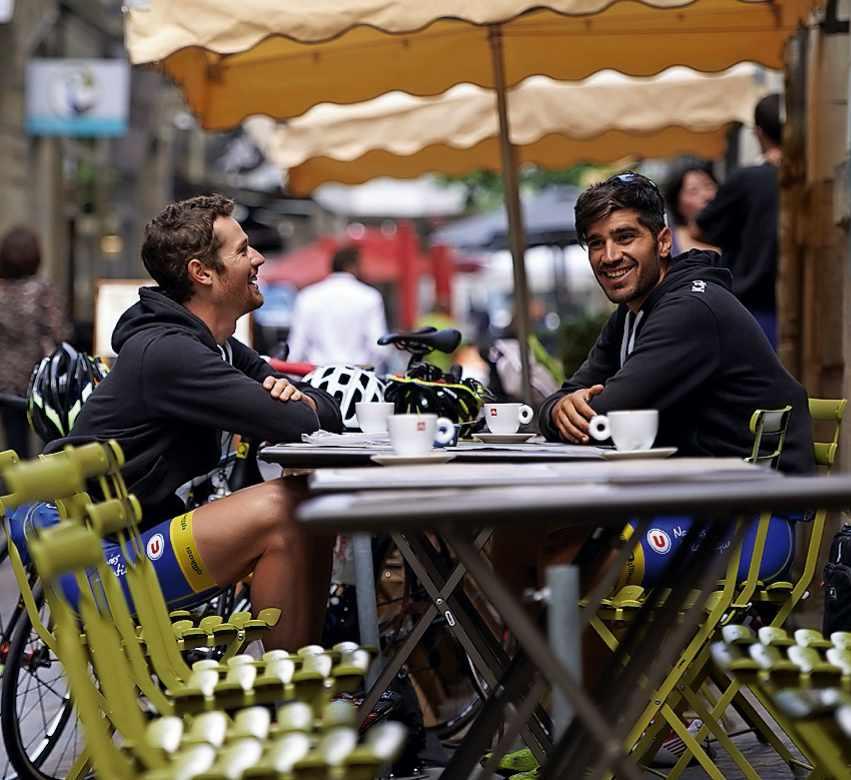
● “Think about planning evening meals proactively. Write a weekly menu together as a family and include weekends,” advises IOC sports nutritionist and ex-professional cyclist Jenny Rutter (@pdtsandc). “Make a list and go shopping for ingredients
once a week. Buy everything on your rest day. For many people this is Monday.” Rutter stresses the importance of including weekend meals in the plan as this can be when eating out or takeaways become the quick and easy option if there’s no food in the house.
● “Make a chilli and double everything. Put it into labelled and dated containers. When you next have a hard session you can grab a nutritious meal from the freezer,” suggests Rutter. “Use the time you save to sit and enjoy a book with your kids instead.” Building up a store of roll-over meals in your freezer will ensure that there’s always something quick and easy to reach for.
● Always have some storecupboard essentials to fall back on.
Left Make sure you have a wellstocked store cupboard
“Use your cupboards. Think about tinned staples such as chickpeas, lentils and tomatoes. Also packets of mixed rice. Microwave rice is less optimal than cooking rice from scratch but better than reaching for a takeaway and saves time,” explains Rutter, who works with elite and amateur athletes alike to keep meals easy and nourishing. “Keep the main dish the same but change up your vegetables or protein or carbohydrate.”
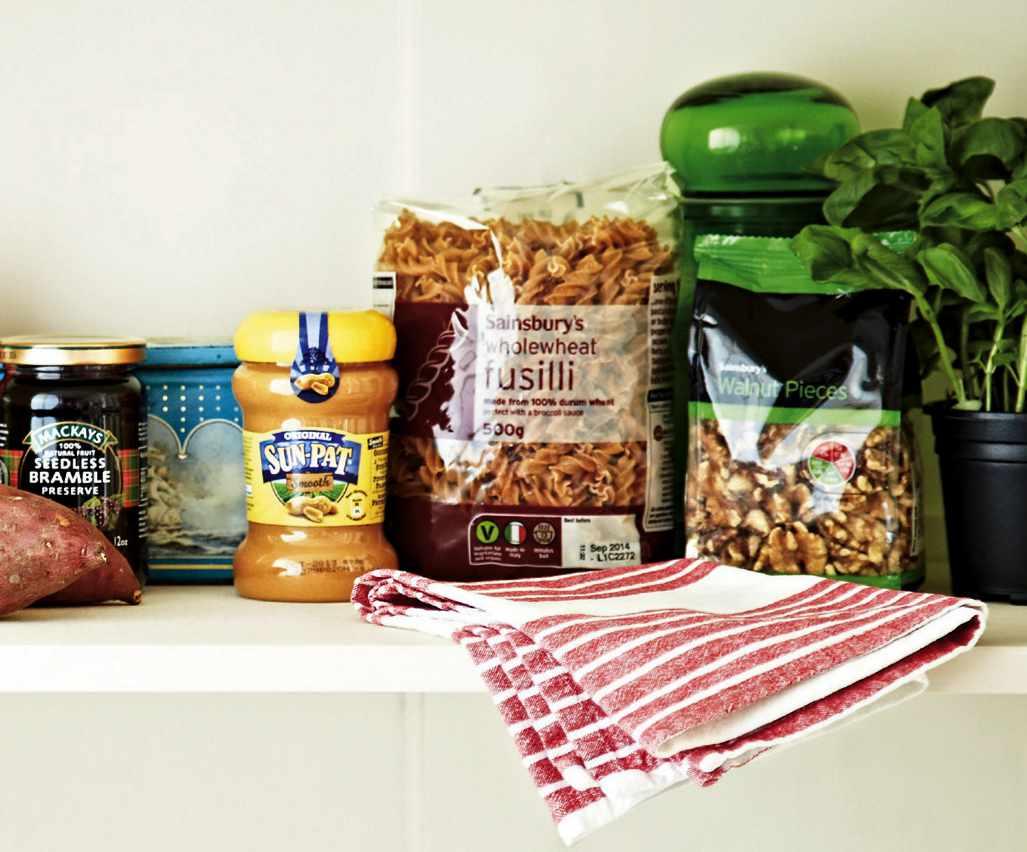
● Fitness improvements are made during recovery periods as adaptations take place, so you must find space for them. Improving sleep quality, eating well and balancing hard training sessions will ensure your hours of training are not wasted. Why not spend social time with family and friends on walks or easy rides on your rest days?
A quick way to measure your progress and improve power and pacing. Repeat this session every 8 weeks to try to beat your time and track fitness improvements.
An indoor trainer or rollers, a bike computer with sensors or a smart trainer and a heart rate monitor.
Keep hydrated and fuelled before the session and have an electrolyte drink during. You shouldn’t need to eat during the session but consider a recovery shake straight after.
Progressive riding for 20mins, increasing intensity to 7/10 effort. Include 2-3 hard 5sec surges to activate muscles.
Ride a sustainably hard effort for 10 miles starting at 8/10 effort and gradually squeezing effort every five minutes to finish at 10/10 effort. Aim to keep a consistent cadence.
Easy spinning for 10mins, reducing to 4/10 effort. Stretch afterwards.

This punchy sub-hour interval session can be fitted into busy schedules to improve sprint ability and repeated hard efforts.
An indoor trainer or rollers and a heart rate monitor.
Keep hydrated and fuelled throughout the day. Use electrolytes in your bottle during the session. Consider a recovery shake immediately afterwards.
Progressive riding for 20mins, increasing intensity to 7/10 effort. Include 2-3 hard 5sec surges to activate muscles.
Main set
Perform 5 x 20sec hard max (10/10) efforts with 40secs recovery. Drive hard out of the saddle for the start of each effort. Take 4mins active recovery between each interval (5/10 effort). Repeat this 3 times.
Easy spinning for 10mins, reducing to 4/10 effort. Carry out stretching afterwards.
TrainerRoad

$19.95 per month
lThis intelligent training app offers workouts and training plans to suit your goals. It responds and adjusts to your schedule and performance.
Zwift
£12.99 per month

Below Short, sharp training sessions can be highly effective
lAccess virtual worlds and a global community with this fun and motivational platform. Join meet-ups, try racing and access structured training.
Wahoo X £14.99 per month
lAccess two apps through one account.
SYSTM offers tailored workouts and training plans while RGT provides real roads to explore.
● Quiet, comfortable and realistic. This trainer simulates different road surfaces and gradients of up to 25%. Guaranteed to make your indoor training more enjoyable.


● A sunrise alarm clock to wake up gradually, feeling energised. The sunset mode is also great for bedtimes to create a healthy sleep environment.

● Coordinate and share family schedules with this nifty app. Save time-managing to-do lists, shopping lists and planning meals to make life run more smoothly.



“On the morning of 24 February 2022, the people of Ukraine woke up in a different world. Our hopes, plans and tranquillity disappeared in a second. Our phones woke many of us with a simple and short massage: ‘The war has started’. Whenever you read this article, our army, medics and volunteers will be doing their best to fight for freedom.”
“Cycling in Odesa has only been possible again recently and usually only on the weekends. After months of war, it’s a way for us to relax and chat for two or three hours. And although there can be air raid alarms during our cycling that bring us back to wartime life, that two or three hours is like a breath of fresh air.”
“Many cyclists from our community are on the front line, working as medics or volunteering, so not all of us are able to ride. For now, a road bike gives us some relief and helps
us to be in good shape. Even during training, we talk about our friends who died on the front or during rocket attacks, about destroyed cities, and when, just last year, we were riding a cycling race. We think about our city of Mykolaiv where the Russian army destroyed the water supply to the city and there hasn’t been any fresh water for months. Nine months of war has
Above Anti-tank hedgehogs are a common sight on rides these days Below Iurii dreams of going on gravel rides in southern Ukraine
brought sandbags, air-raid alarms and anti-tank hedgehogs into our bike rides.”
“I’m a sports photographer and cyclist. Together with my friends in 2021, we organised a gravel camp in the southern part of the Odesa region. We also planned to organise a camp this year in Serhiivka, a small town on a Black sea coast. This town and our camp has been attacked several times by Russian rockets. That’s our reality now.”
“There are endless gravel roads in Southern Ukraine. I do hope that in next few years these lovely destinations will become a gravel paradise for cyclists around the world. We have the breathtaking views and landscapes of the Carpathian Mountains, tricky singletrack riding, enormous open routes, welcoming people and beautiful cuisine.”
“Budziak, the region where we held our gravel camp, and part of the Black Sea Lowland, provides an outstanding opportunity for gravel pilgrimage and off-road adventures. The name derives from the Turkish word bucak, meaning ‘borderland’ or ‘corner’. The region is traditionally wind-blown in spring, yet is full of fields, small forests next to the sea, lakes and nice sandy beaches and cliffs, which are sometimes confused with the White Cliffs of Dover. It’s a sparsely populated, multi-ethnic region and is so unique that on our gravel camp last year we visited Ukrainian, Bulgarian, Romanian and Moldavian villages.”
“All of us here in Ukraine appreciate Britain’s help. We see it and we feel it every day. It’s hard to describe how important it is right now as it’s helping to save our lives.”
Donate to Ukraine via the Disasters Emergency Committee: dec.org.uk
“NINE MONTHS OF WAR HAS BROUGHT SANDBAGS, AIRRAID ALARMS AND ANTITANK HEDGEHOGS INTO OUR BIKE RIDES”


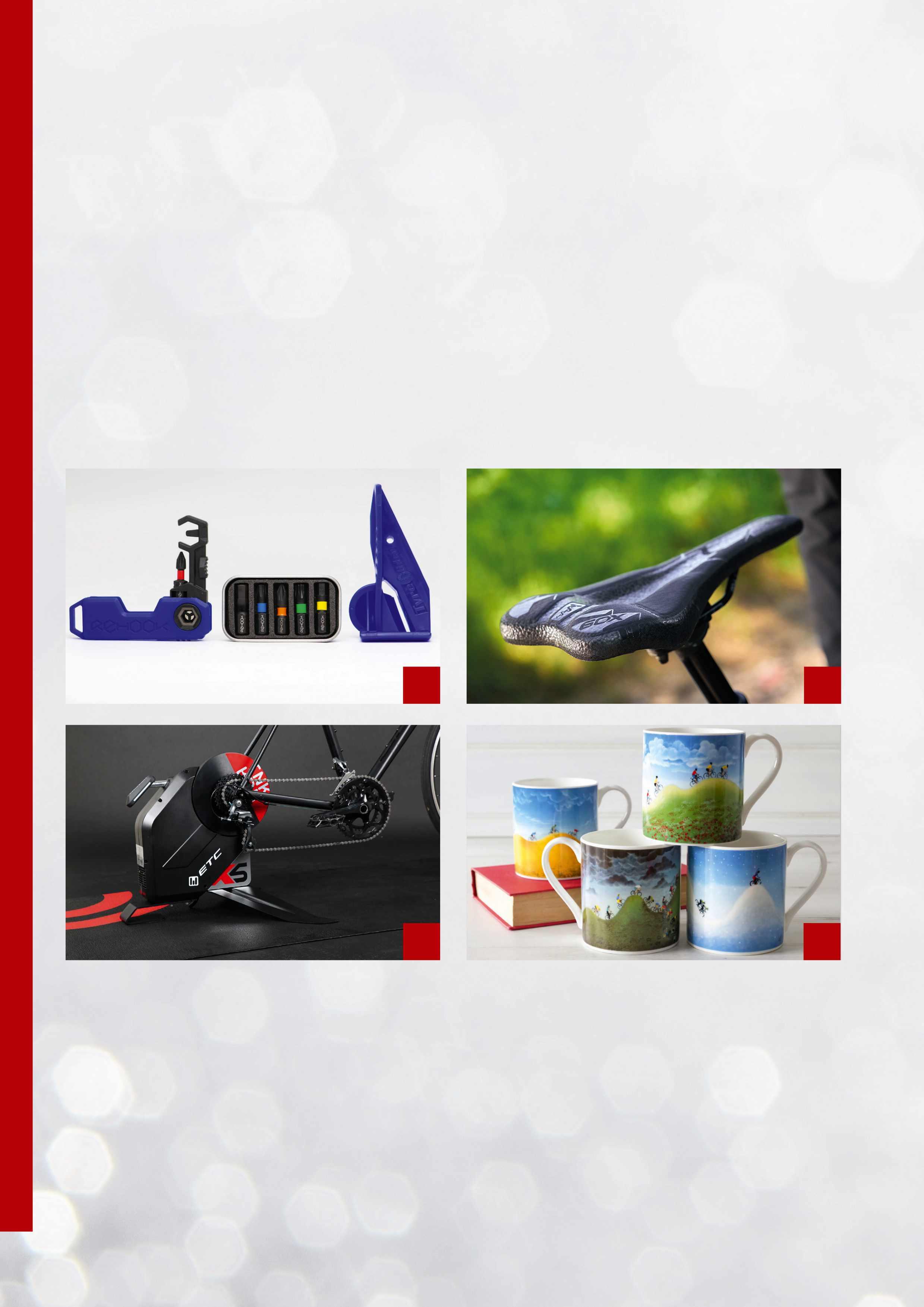
07
The all-new PROBOOTS Dynamic Compression System. The most accessible and customisable compression system on the market, available with four pre-set programmes. Adjustable and hypoallergenic, PROBOOTS is built for the modern athlete tinyurl.com/aup7w8pj
Upload your photo, choose from 3 different styles and trailmaps.com will transform your image into incredible artwork. The ideal bespoke gift for any cyclist, mountain biker, runner or skier. Use code CP10 for 10% off throughout November. £35 with free worldwide shipping. trailmaps.com
Meet WHOOP the world's most advanced wearable health and fitness coach. By providing you with actionable insights into your sleep, training, recovery, and general health, WHOOP will help you to unlock the best version of yourself! Go online to find out more. whoop.com
Powerful features on the Hammerhead Karoo 2 GPS bike computer make it simple to do structured workouts, follow routes, connect to Strava and other third parties, and get the most out of every ride. Get the 'Solstice' Bundle free with purchase of Karoo 2, now until Dec 21. hammerhead.io

I am completing my third and final Grand Tour this autumn. Having been on the road for the Giro and the Tour de France already in 2022 (I missed the Vuelta, preferring instead to attend the prematurely ended Tour of Britain), I decided in my wisdom to add an additional 28-stage Tour to my calendar, starting in Plymouth and finishing in Edinburgh, via pretty much everywhere in England and Wales.
Imaginatively titled the “ReTour de Ned” (we put a placeholder name into the theatres last winter, and it kind of stuck because I couldn’t think of a better one), these 28 dates constituted my first one-man show for four years. If you have not ever been present at one of these evenings, then it’s worth noting that they are probably not what you are expecting. Designed at least with the ambition to entertain and amuse, they are a kind of surreal, sometimes musical and visual examination, and occasional re-enactment, of various aspects of road racing, and specifically the Tour de France. They aspire to be an escapist celebration of our wonderful, idiosyncratic sport; a dose of nostalgia for the heat and light of July, just as winter is drawing in and the nights are getting longer. But mainly they are supposed to be a laugh. I hope if you came to a show, you at least smiled from time to time.
During five long weeks on the road with Rhys, my outstanding and astonishingly hard-working tour manager, criss-crossing the country, I was struck by a few things. Firstly, the sheer numbers of people who came to see the show: 10,000 souls booked babysitters and taxis, had curries afterwards, met up with friends, or simply made their way there alone. During such straightened times, I was gobsmacked by the turnout, and humbled. One woman messaged me after my show in Southport (I think) to say she’d enjoyed the evening, and was waiting for the bus home; a ride that would take two hours!
There is a kinship in this community; a shared understanding that though we are few, we are many. Interest in this sport may have ballooned through the “Wiggo” years, but it is still far from mainstream, and disappears under the radar when held up against the juggernauts of football, rugby and cricket. And yet, what we lack in numbers, we make up for in unadulterated passion. There was always a sense during the ReTour de Ned that we were sharing a secret among friends.
Cycling’s ability to laugh at itself is another admirable quality of its adherents. This is a good thing too, because there are repeated targets for my (hopefully well-
Ned Boulting Sports journalist

Ned is the main commentator for ITV’s Tour de France coverage and editor of The Road Book. He also tours his own one-man show
intentioned) mockery during the course of the evening: especially those who invest too much in the minutiae of gear ratios, or over-romanticise aspects of road-racing culture. I did four shows in Yorkshire, the self-proclaimed centre of the British scene since 2014 and the “Grandest of Grand Départs”. Outside of the county, I made sure that Yorkshire got taken down a peg or two. But, two-faced as I am, inside its borders, I told a very different story. There is much to take aim at, but, on the whole, the cycling public is able to roll with the blows!
From time to time, I was made aware of a special guest in the audience, a birthday being celebrated, or a notable achievement demanding recognition. On such occasions, we would, as one, take note of their presence. Sometimes, this was spine-tingling. Stan Brittain attended the show in Southport, at the age of 92. Stan had won a silver medal at the ’56 Olympics and completed the ’58 Tour de France, becoming only the third Briton ever to do so. And there he was, nimbly rising to his feet to take the ovation that came his way from a sell-out crowd. It was wonderful.
But a week later, we got news that his teammate from the 1958 Tour, the legendary Brian Robinson, had died. The next day, I was doing the show in Ilkley, close to roads on which the great man had trained and ridden all his life. I asked the crowd to cheer his memory to the rafters of the venerable King’s Hall. The noise was immense. I stood on stage, clapping, watching it all, and scarcely able to take it in.
Above Brian Robinson during stage 20 of the 1959 Tour de France
We have something special to hold onto; this love of our sport. It actually does things that not much else can in these fractious times. It binds us together. And that, more than anything else, is the lesson I will take from my final grand tour of 2022.

Ned takes to the stage for his own celebratory tour of Britain

